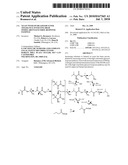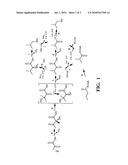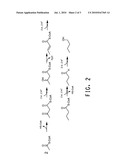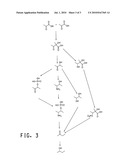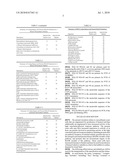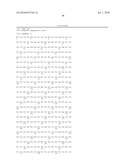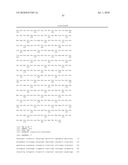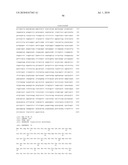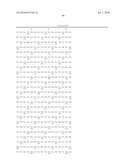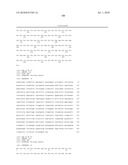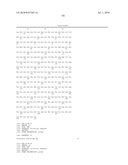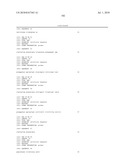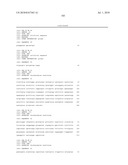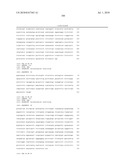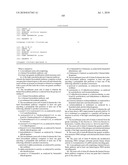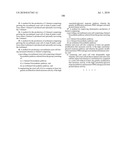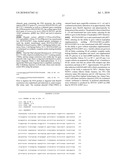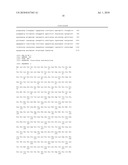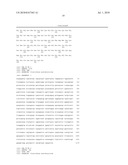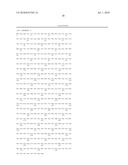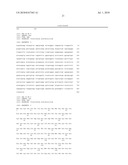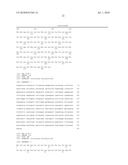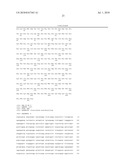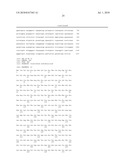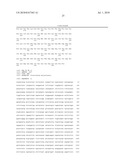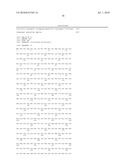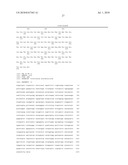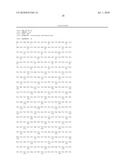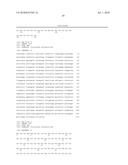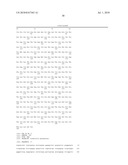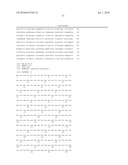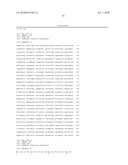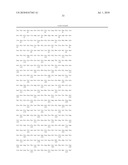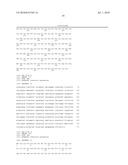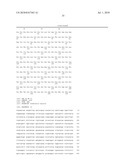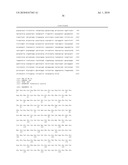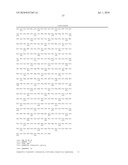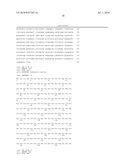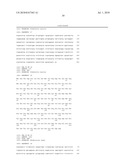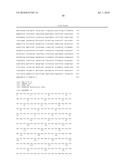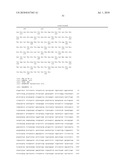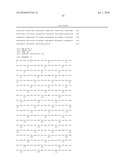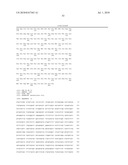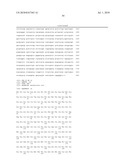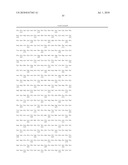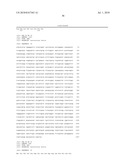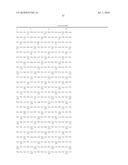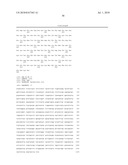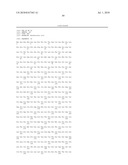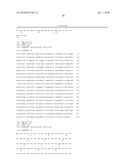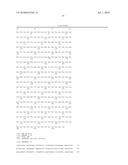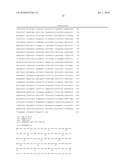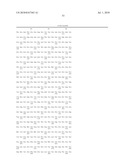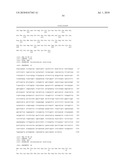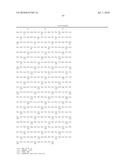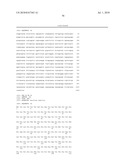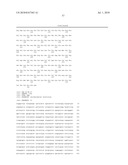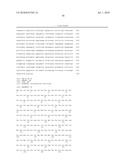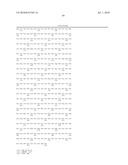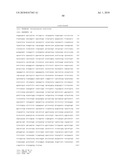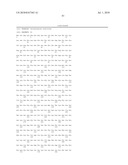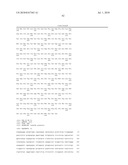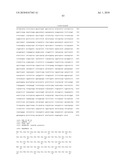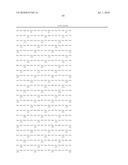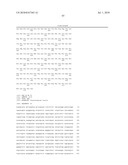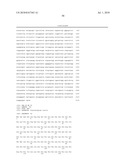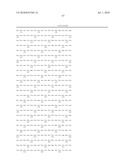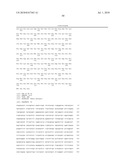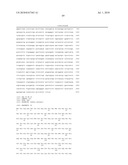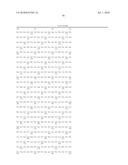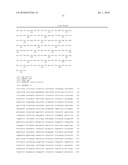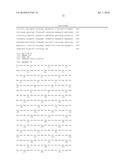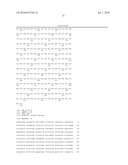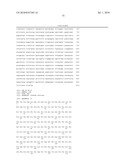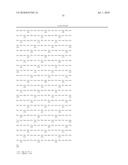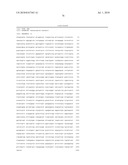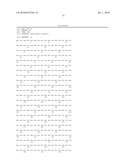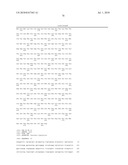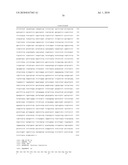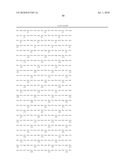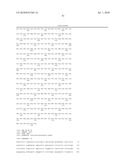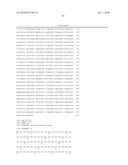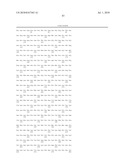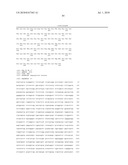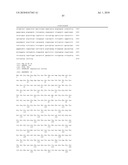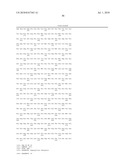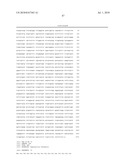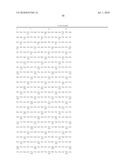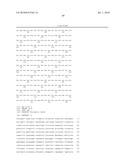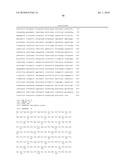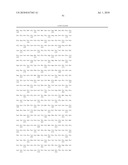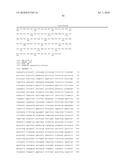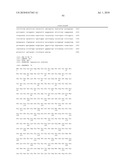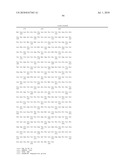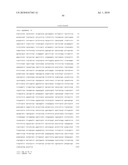Patent application title: YEAST WITH INCREASED BUTANOL TOLERANCE INVOLVING HIGH OSMOLARITY/GLYCEROL RESPONSE PATHWAY
Inventors:
Michael G. Bramucci (Boothwyn, PA, US)
Robert A. Larossa (Chadds Ford, PA, US)
Robert A. Larossa (Chadds Ford, PA, US)
Dana R. Smulski (Wilmington, DE, US)
Assignees:
BUTAMAX (TM) ADVANCED BIOFUELS LLC
IPC8 Class: AC12P716FI
USPC Class:
435160
Class name: Containing hydroxy group acyclic butanol
Publication date: 2010-07-01
Patent application number: 20100167365
Claims:
1. A recombinant yeast cell comprising:a) a butanol biosynthetic pathway;
andb) at least one genetic modification which increases activity of the
high osmolarity/glycerol response pathway:wherein the butanol
biosynthetic pathway comprises at least one gene that is heterologous to
the yeast cell and wherein the yeast cell has an increase in tolerance to
butanol as compared with a yeast cell that lacks the at least one genetic
modification of (b).
2. The recombinant yeast cell of claim 1 wherein the butanol biosynthetic pathway is selected from the group consisting of:a) a 1-butanol biosynthetic pathwayb) a 2-butanol biosynthetic pathway; andc) an isobutanol biosynthetic pathway.
3. The recombinant yeast cell of claim 2 wherein the 1-butanol biosynthetic pathway comprises at least one gene encoding a polypeptide that performs at least one of the following substrate to product conversions:a) acetyl-CoA to acetoacetyl-CoA, as catalyzed by acetyl-CoA acetyltransferase;b) acetoacetyl-CoA to 3-hydroxybutyryl-CoA, as catalyzed by 3-hydroxybutyryl-CoA dehydrogenase;c) 3-hydroxybutyryl-CoA to crotonyl-CoA, as catalyzed by crotonase;d) crotonyl-CoA to butyryl-CoA, as catalyzed by butyryl-CoA dehydrogenase;e) butyryl-CoA to butyraldehyde, as catalyzed by butyraldehyde dehydrogenase; andf) butyraldehyde to 1-butanol, as catalyzed by 1-butanol dehydrogenase.
4. The recombinant yeast cell of claim 2 wherein the 2-butanol biosynthetic pathway comprises at least one gene encoding a polypeptide that performs at least one of the following substrate to product conversions:a) pyruvate to alpha-acetolactate, as catalyzed by acetolactate synthase;b) alpha-acetolactate to acetoin, as catalyzed by acetolactate decarboxylase;c) acetoin to 2,3-butanediol, as catalyzed by butanediol dehydrogenase;d) 2,3-butanediol to 2-butanone, as catalyzed by butanediol dehydratase; ande) 2-butanone to 2-butanol, as catalyzed by 2-butanol dehydrogenase.
5. The recombinant yeast cell of claim 2 wherein the isobutanol biosynthetic pathway comprises at least one gene encoding a polypeptide that performs at least one of the following substrate to product conversions:a) pyruvate to acetolactate, as catalyzed by acetolactate synthase;b) acetolactate to 2,3-dihydroxyisovalerate, as catalyzed by acetohydroxy acid isomeroreductase;c) 2,3-dihydroxyisovalerate to α-ketoisovalerate, as catalyzed by acetohydroxy acid dehydratase or dihydroxyacid dehydratase;d) α-ketoisovalerate to isobutyraldehyde, as catalyzed by a branched-chain keto acid decarboxylase; ande) isobutyraldehyde to isobutanol, as catalyzed by a branched-chain alcohol dehydrogenase.
6. The recombinant yeast cell of claim 1 wherein the cell has at least about a 40% improvement in growth yield in 1% (w/v) isobutanol as compared to a parental cell having no increase in activity of the high osmolarity/glycerol response pathway.
7. The recombinant yeast cell of claim 1 selected from the group consisting of Saccharomyces, Schizosaccharomyces, Hansenula, Candida, Kluyveromyces, Yarrowia and Pichia.
8. The yeast cell of claim 1 wherein the genetic modification increases activity of the mitogen-activated protein kinase module of the high osmolarity/glycerol response pathway.
9. The yeast cell of claim 8 wherein the genetic modification increases PBS2 mitogen activated protein kinase kinase activity.
10. The yeast cell of claim 9 wherein the modification increasing PBS2 mitogen activated protein kinase kinase activity is overexpression of a pBS2 protein encoding gene.
11. A recombinant yeast cell comprising a butanol biosynthetic pathway and at least one heterologous PBS2 protein encoding gene.
12. The yeast cell of claim 11 wherein the butanol biosynthetic pathway comprises at least one gene that is heterologous to the yeast cell.
13. A method for the production of 1-butanol comprising growing the recombinant yeast cell of claim 3 under conditions where 1-butanol is produced and optionally recovering the 1-butanol.
14. A method for the production of 2-butanol comprising growing the recombinant yeast cell of claim 4 under conditions where 2-butanol is produced and optionally recovering the 2-butanol.
15. A method for the production of isobutanol comprising growing the recombinant yeast cell of claim 5 under conditions where isobutanol is produced and optionally recovering the isobutanol.
16. A method for producing a recombinant yeast cell having increased tolerance to butanol comprising:a) providing a recombinant yeast cell comprising a butanol biosynthetic pathway selected from the group consisting of:i) a 1-butanol biosynthetic pathwayii) a 2-butanol biosynthetic pathway; andiii) an isobutanol biosynthetic pathway; andb) engineering the yeast cell of (a) to comprise at least one genetic modification which increases activity of the high osmolarity/glycerol response pathway wherein the genetic modification increases PBS2 mitogen activated protein kinase activity.
17. A method for improving fermentative production of butanol comprising:a) providing a recombinant yeast cell comprising a butanol biosynthetic pathway selected from the group consisting of:i) a 1-butanol biosynthetic pathwayii) a 2-butanol biosynthetic pathway; andiii) an isobutanol biosynthetic pathway;wherein said yeast cell also comprises at least one genetic modification that increases activity of the high osmolarity/glycerol response pathway and wherein the genetic modification increases PBS2 mitogen activated protein kinase activity; andb) contacting said yeast cell with fermentable sugar whereby said yeast cell produces butanol and said yeast cell has improved tolerance to said butanol as compared to a yeast cell without at least one genetic modification that increases activity of the high osmolarity/glycerol response pathway and increases PBS2 mitogen activated protein kinase activity.
Description:
CROSS REFERENCE TO RELATED APPLICATIONS
[0001]This application is related to and claims the benefit of priority of U.S. Provisional Patent Application No. 61/141,012, filed Dec. 29, 2008, the entirety of which is herein incorporated by reference.
FIELD OF THE INVENTION
[0002]The invention relates to the field of microbiology and genetic engineering. More specifically, yeast genes that are involved in the cell response to butanol were identified. These genes may be engineered to improve growth yield in the presence of butanol.
BACKGROUND OF THE INVENTION
[0003]Butanol is an important industrial chemical, useful as a fuel additive, as a feedstock chemical in the plastics industry, and as a foodgrade extractant in the food and flavor industry. Each year 10 to12 billion pounds of butanol are produced by petrochemical means and the need for this commodity chemical will likely increase.
[0004]Butanol may be made through chemical synthesis or by fermentation. Isobutanol is produced biologically as a by-product of yeast fermentation. It is a component of "fusel oil" that forms as a result of incomplete metabolism of amino acids by this group of fungi. Isobutanol is specifically produced from catabolism of L-valine and the yield is typically very low. Additionally, recombinant microbial production hosts, expressing a 1-butanol biosynthetic pathway (Donaldson et al., U.S. Patent Application Publication No. US20080182308A1), a 2-butanol biosynthetic pathway (Donaldson et al., U.S. Patent Publication Nos. US 20070259410A1 and US 20070292927), and an isobutanol biosynthetic pathway (Maggio-Hall et al., U.S. Patent Publication No. US 20070092957) have been described.
[0005]Biological production of butanols is believed to be limited by butanol toxicity to the host microorganism used in fermentation for butanol production. Yeast are typically sensitive to butanol in the medium. Using a screen for 1-butanol insensitive Saccharomyces cerevisiae mutants, Lorenz et al. (Molec. Biol. of the Cell (2000) 11:183-199) identified proteins that regulate polarized growth (BUD8, BEM1, BEM4, and FIG1), mitochondrial function (MSM1, MRP21, and HM11), and a transcriptional regulator (CHD1). They also found that 1-butanol stimulates filamentous growth in haploid cells and induces cell elongation and changes in budding pattern, leading to a pseudohyphal morphology. Ashe et al. (The EMBO Journal (2001) 20:6464-6474) found that butanol brings about a rapid inhibition of translation at the initiation step in Saccharomyces cerevisiae. The GCD1-P180 allele has a single amino acid change in Gcd1p, which is part of the eIF2B guanine nucleotide complex that is responsible for recycling eIF2-GDP to eIF2-GTP, that allows translational regulation upon butanol addition. Smirnova et al. (Molecular and Cellular Bioloty (2005) 25:9340-9340) found by using microarray analysis that with addition of fusel alcohol, there is widespread translational reprogramming in yeast. These studies all indicate the complexity of butanol sensitivity in yeast.
[0006]A complete set of S. cerevisiae homozygous deletions was screened for tolerance to the aliphatic alcohols ethanol, propanol and pentanol (Fuijta et al. (2006) FEMS Yeast Res 6:744-750). The set was also screened for ethanol tolerance by van Voorst et al. ((2006) Yeast 23(5): 351-359). Mutant PBS2 deletion strains were not found to be hypersensitive to ethanol, propanol or pentanol. These screens also did not find other components of the high osmolarity/glycerol (HOG) cascade. In contrast PBS2 deletion strains are hypersensitive to many other chemicals including 2-mercaptoethanol, dithiothreitol, CaCl2, NaCl, sorbitol, sodium metaarsenite, tunicamycin and nocodazole.
[0007]There remains a need for yeast cells with increased tolerance to butanol, as well as methods of producing butanols using yeast host strains that are more tolerant to these chemicals. To this end applicants have Identified genes in yeast that are involved in butanol tolerance, that can be engineered to increase the level of butanol tolerance in yeast cells used for butanol production.
SUMMARY OF THE INVENTION
[0008]Provided herein are recombinant yeast cells comprising: a) a butanol biosynthetic pathway; and b) at least one genetic modification which increases activity of the high osmolarity/glycerol response pathway: wherein the butanol biosynthetic pathway comprises at least one gene that is heterologous to the yeast cell and wherein the yeast cell has an increase in tolerance to butanol as compared with a yeast cell that lacks the at least one genetic modification of (b).
[0009]In some embodiments, the cell has at least about a 40% improvement in growth yield in 1% (w/v) isobutanol as compared to a parental cell having no increase in activity of the high osmolarity/glycerol response pathway.
[0010]In some embodiments, the yeast is selected from the group consisting of Saccharomyces, Schizosaccharomyces, Hansenula, Candida, Kluyveromyces, Yarrowia and Pichia. In some embodiments, the genetic modification increases activity of the mitogen-activated protein kinase module of the high osmolarity/glycerol response pathway. In some embodiments, the genetic modification increases PBS2 mitogen activated protein kinase kinase activity. In some embodiments, the modification increasing PBS2 mitogen activated protein kinase kinase activity is overexpression of a pBS2 protein encoding gene. In some embodiments, PBS2 protein encoding gene encodes a protein having an amino acid sequence with at least about 90% sequence identity to a sequence selected from the group consisting of SEQ ID NOs:50, 52, 54, 56, 58, 60, 62, 64, 66, 68, 70, 72, 74, 76, 78, and 80 based on Clustal W method of alignment using the default parameters of GAP PENALTY=10, GAP LENGTH PENALTY=0.1, and Gonnet 250 series of protein weight matrix. In some embodiments, increasing PBS2 mitogen activated protein kinase kinase activity is overexpression of a gene selected from the group consisting of SIN1, SHO1, MS81, OPY2, TOS2, MYO1, ABC1, YPT7, YPD1, SSKI, PKC1, CDC42, KIN1, SEC15, STE20, CDC37, CKB2, MAL31, RHO1, CAT5, ST83, RPD3, RSC4, SPT16 and HOR2.
[0011]Also provided are recombinant yeast cells comprising a butanol biosynthetic pathway and at least one heterologous PBS2 protein encoding gene. In some embodiments, the butanol biosynthetic pathway comprises at least one gene that is heterologous to the yeast cell. In some embodiments, the yeast cell has an increased tolerance to butanol as compared to a yeast cell that does not comprise at least one heterologous PBS2 protein encoding gene.
[0012]In some embodiments, the butanol biosynthetic pathway is selected from the group consisting of: a) a 1-butanol biosynthetic pathway; b) a 2-butanol biosynthetic pathway; and c) an isobutanol biosynthetic pathway. In some embodiments, the 1-butanol biosynthetic pathway comprises at least one gene encoding a polypeptide that performs at least one of the following substrate to product conversions: a) acetyl-CoA to acetoacetyl-CoA, as catalyzed by acetyl-CoA acetyltransferase; b) acetoacetyl-CoA to 3-hydroxybutyryl-CoA, as catalyzed by 3-hydroxybutyryl-CoA dehydrogenase; c) 3-hydroxybutyryl-CoA to crotonyl-CoA, as catalyzed by crotonase; d) crotonyl-CoA to butyryl-CoA, as catalyzed by butyryl-CoA dehydrogenase; e) butyryl-CoA to butyraldehyde, as catalyzed by butyraldehyde dehydrogenase; and f) butyraldehyde to 1-butanol, as catalyzed by 1-butanol dehydrogenase. In some embodiments, the 2-butanol biosynthetic pathway comprises at least one gene encoding a polypeptide that performs at least one of the following substrate to product conversions: a) pyruvate to alpha-acetolactate, as catalyzed by acetolactate synthase; b) alpha-acetolactate to acetoin, as catalyzed by acetolactate decarboxylase; c) acetoin to 2,3-butanediol, as catalyzed by butanediol dehydrogenase;d) 2,3-butanediol to 2-butanone, as catalyzed by butanediol dehydratase; and e) 2-butanone to 2-butanol, as catalyzed by 2-butanol dehydrogenase. In some embodiments, the isobutanol biosynthetic pathway comprises at least one gene encoding a polypeptide that performs at least one of the following substrate to product conversions: a) pyruvate to acetolactate, as catalyzed by acetolactate synthase; b) acetolactate to 2,3-dihydroxyisovalerate, as catalyzed by acetohydroxy acid isomeroreductase; c) 2,3-dihydroxyisovalerate to α-ketoisovalerate, as catalyzed by acetohydroxy acid dehydratase or dihydroxyacid dehydratase; d) α-ketoisovalerate to isobutyraldehyde, as catalyzed by a branched-chain keto acid decarboxylase; and e) isobutyraldehyde to isobutanol, as catalyzed by a branched-chain alcohol dehydrogenase.
[0013]Also provided herein are methods for the production of 1-butanol comprising growing recombinant yeast cells under conditions where 1-butanol is produced and optionally recovering the 1-butanol. Also provided herein are methods for the production of 2-butanol comprising growing recombinant yeast cells under conditions where 2-butanol is produced and optionally recovering the 2-butanol. Also provided are methods for the production of isobutanol comprising growing recombinant yeast cells under conditions where isobutanol is produced and optionally recovering the isobutanol.
[0014]Also provided herein are methods for producing a recombinant yeast cell having increased tolerance to butanol comprising: a) providing a recombinant yeast cell comprising a butanol biosynthetic pathway selected from the group consisting of : i) a 1-butanol biosynthetic pathway; ii) a 2-butanol biosynthetic pathway; and iii) an isobutanol biosynthetic pathway; and b) engineering the yeast cell of (a) to comprise at least one genetic modification which increases activity of the high osmolarity/glycerol response pathway wherein the genetic modification increases increases PBS2 mitogen activated protein kinase kinase activity.
[0015]Also provided herein is a method for improving fermentative production of butanol comprising:
[0016]a) providing a recombinant yeast cell comprising a butanol biosynthetic pathway selected from the group consisting of:
[0017]i) a 1-butanol biosynthetic pathway
[0018]ii) a 2-butanol biosynthetic pathway; and
[0019]iii) an isobutanol biosynthetic pathway;
wherein said yeast cell also comprises at least one genetic modification that increases activity of the high osmolarity/glycerol response pathway and wherein the genetic modification increases PBS2 mitogen activated protein kinase activity; and
[0020]b) contacting said yeast cell with fermentable sugar whereby said yeast cell produces butanol and wherein said yeast cell has improved tolerance to said butanol as compared to a yeast cell without at least one genetic modification that increases activity of the high osmolarity/glycerol response pathway and wherein the genetic modification increases PBS2 mitogen activated protein kinase activity. Said method also provides for improved production of butanol as compared to a yeast cell without at least one genetic modification that increases activity of the high osmolarity/glycerol response pathway and increases PBS2 mitogen activated protein kinase activity.
BRIEF DESCRIPTION OF THE DRAWINGS AND SEQUENCE DESCRIPTIONS
[0021]The various embodiments of the invention can be more fully understood from the following detailed description and the accompanying sequence descriptions, which form a part of this application.
[0022]FIG. 1 depicts isobutanol biosynthetic pathways.
[0023]FIG. 2 depicts 1-butanol biosynthetic pathways.
[0024]FIG. 3 depicts 2-butanol biosynthetic pathways.
[0025]The following sequences conform with 37 C.F.R. 1.821-1.825 ("Requirements for Patent Applications Containing Nucleotide Sequences and/or Amino Acid Sequence Disclosures--the Sequence Rules") and are consistent with World Intellectual Property Organization (WIPO) Standard ST.25 (1998) and the sequence listing requirements of the EPO and PCT (Rules 5.2 and 49.5(a-bis), and Section 208 and Annex C of the Administrative Instructions). The symbols and format used for nucleotide and amino acid sequence data comply with the rules set forth in 37 C.F.R. §1.822.
TABLE-US-00001 TABLE 1 Summary of Coding Region and Protein SEQ ID Numbers for 1- Butanol Biosynthetic Pathway SEQ ID NO: SEQ ID NO: Description Nucleic acid Peptide Acetyl-CoA acetyltransferase thlA from 1 2 Clostridium acetobutylicum ATCC 824 Acetyl-CoA acetyltransferase thlB from 3 4 Clostridium acetobutylicum ATCC 824 Acetyl-CoA acetyltransferase from 39 40 Saccharomyces cerevisiae 3-Hydroxybutyryl-CoA dehydrogenase 5 6 from Clostridium acetobutylicum ATCC 824 Crotonase from Clostridium 7 8 acetobutylicum ATCC 824 Putative trans-enoyl CoA reductase from 9 10 Clostridium acetobutylicum ATCC 824 Butyraldehyde dehydrogenase from 11 12 Clostridium beijerinckii NRRL B594 1-Butanol dehydrogenase bdhB from 13 14 Clostridium acetobutylicum ATCC 824 1-Butanol dehydrogenase 15 16 bdhA from Clostridium acetobutylicum ATCC 824
TABLE-US-00002 TABLE 2 Summary of Coding Region and Protein SEQ ID Numbers for 2- Butanol Biosynthetic Pathway SEQ ID NO: SEQ ID NO: Description Nucleic acid Peptide budA, acetolactate decarboxylase from 17 18 Klebsiella pneumoniae ATCC 25955 budB, acetolactate synthase from 19 20 Klebsiella pneumoniae ATCC 25955 budC, butanediol dehydrogenase from 21 22 Klebsiella pneumoniae IAM1063 pddA, butanediol dehydratase alpha 23 24 subunit from Klebsiella oxytoca ATCC 8724 pddB, butanediol dehydratase beta 25 26 subunit from Klebsiella oxytoca ATCC 8724 pddC, butanediol dehydratase gamma 27 28 subunit from Klebsiella oxytoca ATCC 8724 sadH, 2-butanol dehydrogenase from 29 30 Rhodococcus ruber 219
TABLE-US-00003 TABLE 3 Summary of Coding Region and Protein SEQ ID Numbers for Isobutanol Biosynthetic Pathway SEQ ID NO: SEQ ID NO: Description Nucleic acid Peptide Klebsiella pneumoniae budB 19 20 (acetolactate synthase) Bacillus subtilis alsS 41 42 (acetolactate synthase) E. coli ilvC (acetohydroxy acid 31 32 reductoisomerase) S. cerevisiae ILV5 43 44 (acetohydroxy acid reductoisomerase) B. subtilis ilvC (acetohydroxy acid 45 46 reductoisomerase) E. coli ilvD (acetohydroxy acid 33 34 dehydratase) S. cerevisiae ILV3 47 48 (Dihydroxyacid dehydratase) Lactococcus lactis kivD (branched-chain 35 36 α-keto acid decarboxylase), codon optimized E. coli yqhD (branched-chain alcohol 37 38 dehydrogenase)
TABLE-US-00004 TABLE 4 Summary of PBS2 Coding Region and Protein SEQ ID Numbers SEQ ID NO: SEQ ID NO: Organism Nucleic acid Peptide Saccharomyces cerevisiae 49 50 Candida glabrata 51 52 Kluyveromyces lactis 53 54 Ashbya gossypii 55 56 Pichia stipitis 57 58 Candida albicans 59 60 Debaryomyces hansenii 61 62 Yarrowia lipolytica 63 64 Schizosaccharomyces pombe 65 66 Aspergillus terreus 67 68 Aspergillus fumigatus 69 70 Neurospora crassa 71 72 Aspergillus nidulans 73 74 Magnaporthe grisea 75 76 Cryptococcus neoformans 77 78 Ustilago maydis 79 80
[0026]SEQ ID NOs:81 and 82 are primers used for sequencing the ends of the S. cerevisiae genomic DNA insert of the plasmids in yBUT2 and yBUT15 strains.
[0027]SEQ ID NOs:83 and 84 are primers for PCR of iYDR006C.
[0028]SEQ ID NOs:85 and 86 are primers for PCR of iYDR008C.
[0029]SEQ ID NOs:87 and 88 are primers for PCR of upTRP1 DR UR.
[0030]SEQ ID NOs:89 and 90 are primers for PCR of RA3* DR downTRP1.
[0031]SEQ ID NO:91 is the nucleotide sequence of the CUP1 promoter.
[0032]SEQ ID NO:92 is the nucleotide sequence of the CYC1 terminator.
[0033]SEQ ID NO:93 is the nucleotide sequence of the FBA promoter.
[0034]SEQ ID NO:94 is the nucleotide sequence of the ADH1 terminator.
[0035]SEQ ID NO:95 is the nucleotide sequence of the GPM promoter.
[0036]SEQ ID NOs:96 and 97 are primers for PCR of the PBS2 gene and flanking DNA.
DETAILED DESCRIPTION
[0037]The present invention relates to recombinant yeast cells that are engineered for production of butanol and that additionally are engineered to have increased activity of the high osmolarity/glycerol response pathway. The present yeast cells may have increased expression or activity of at least one protein involved in promoting activity of the high osmolarity/glycerol response pathway including proteins that are pathway receptors of external stimuli, proteins that are in the mitogen-activated protein kinase (MAPK) module of this pathway, and proteins that are downstream targets of the MAPK module of this pathway. These yeast cells have increased tolerance to butanol and may be used for production of butanol which is valuable as a fuel or fuel additive to reduce demand for fossil fuels.
[0038]The following abbreviations and definitions will be used for the interpretation of the specification and the claims.
[0039]As used herein, the terms "comprises," "comprising," "includes," "including," "has," "having," "contains" or "containing," or any other variation thereof, are intended to cover a non-exclusive inclusion. For example, a composition, a mixture, process, method, article, or apparatus that comprises a list of elements is not necessarily limited to only those elements but may include other elements not expressly listed or inherent to such composition, mixture, process, method, article, or apparatus. Further, unless expressly stated to the contrary, "or" refers to an inclusive or and not to an exclusive or. For example, a condition A or B is satisfied by any one of the following: A is true (or present) and B is false (or not present), A is false (or not present) and B is true (or present), and both A and B are true (or present).
[0040]Also, the indefinite articles "a" and "an" preceding an element or component of the invention are intended to be nonrestrictive regarding the number of instances (i.e. occurrences) of the element or component. Therefore "a" or "an" should be read to include one or at least one, and the singular word form of the element or component also includes the plural unless the number is obviously meant to be singular.
[0041]The term "invention" or "present invention" as used herein is a non-limiting term and is not intended to refer to any single embodiment of the particular invention but encompasses all possible embodiments as described in the specification and the claims.
[0042]As used herein, the term "about" modifying the quantity of an ingredient or reactant of the invention employed refers to variation in the numerical quantity that can occur, for example, through typical measuring and liquid handling procedures used for making concentrates or use solutions in the real world; through inadvertent error in these procedures;
[0043]through differences in the manufacture, source, or purity of the ingredients employed to make the compositions or carry out the methods; and the like. The term "about" also encompasses amounts that differ due to different equilibrium conditions for a composition resulting from a particular initial mixture. Whether or not modified by the term "about", the claims include equivalents to the quantities. In one embodiment, the term "about" means within 10% of the reported numerical value, preferably within 5% of the reported numerical value
[0044]The term "butanol" as used herein, refers to 1-butanol, 2-butanol, isobutanol, or mixtures thereof.
[0045]The terms "butanol tolerant yeast cell" and "tolerant" when used to describe a modified yeast cell of the invention, refers to a modified yeast that shows better growth in the presence of butanol than the parent strain from which it is derived.
[0046]The term "butanol biosynthetic pathway" refers to an enzyme pathway to produce 1-butanol, 2-butanol, or isobutanol.
[0047]The term "1-butanol biosynthetic pathway" refers to an enzyme pathway to produce 1-butanol from acetyl-coenzyme A (acetyl-CoA).
[0048]The term "2-butanol biosynthetic pathway" refers to an enzyme pathway to produce 2-butanol from pyruvate.
[0049]The term "isobutanol biosynthetic pathway" refers to an enzyme pathway to produce isobutanol from pyruvate.
[0050]The term "mitogen activated protein (MAP) kinase" refers to proteins with EC number EC 2.7.11.24, which are serine/threonine-specific protein kinases that respond to extracellular stimuli (mitogens) and regulate various cellular activities, such as gene expression, mitosis, differentiation, and cell survival/apoptosis.
[0051]The term "PBS2" refers to a gene encoding a type of MAP kinase kinase that is a part of the mitogen-activated protein kinase module of the high osmolarity/glycerol response pathway. PBS2p is the protein encoded by PBS2, which is an example of proteins classified as EC 2.7.12.2. Proteins with the same function as PBS2p encoded by PBS2 may be referred to in the art as being encoded by genes with other names including SPC2, WIS1, SMF2, dSOR1, HOG4, SFS4, and SSK4. The term PBS2p refers herein to any of these encoded proteins that function similarly to PBS2p in the mitogen-activated protein kinase module of the high osmolarity/glycerol response pathway and that have sequence identity to a PBS2p amino acid sequence that is at least about 55%-60%, 60%-65%, 65%-70%, 70%-75%, 75%-80%, 80%-85%, 85%-90%, 90%-95%, or 95%-100%.
[0052]The term "acetyl-CoA acetyltransferase" refers to an enzyme that catalyzes the conversion of two molecules of acetyl-CoA to acetoacetyl-CoA and coenzyme A (CoA). Preferred acetyl-CoA acetyltransferases are acetyl-CoA acetyltransferases with substrate preferences (reaction in the forward direction) for a short chain acyl-CoA and acetyl-CoA and are classified as E.C. 2.3.1.9 [Enzyme Nomenclature 1992, Academic Press, San Diego]; although, enzymes with a broader substrate range (E.C. 2.3.1.16) will be functional as well. Acetyl-CoA acetyltransferases are available from a number of sources, for example, Escherichia coli (GenBank Nos: NP--416728, NC--000913; NCBI (National Center for Biotechnology Information) amino acid sequence, NCBI nucleotide sequence), Clostridium acetobutylicum (GenBank Nos: NP--349476.1 (SEQ ID NO:2), NC--003030; NP--149242 (SEQ ID NO:4), NC--001988), Bacillus subtilis (GenBank Nos: NP--390297, NC--000964), and Saccharomyces cerevisiae (GenBank Nos: NP--015297, NC--001148 (SEQ ID NO:39)).
[0053]The term "3-hydroxybutyryl-CoA dehydrogenase" refers to an enzyme that catalyzes the conversion of acetoacetyl-CoA to 3-hydroxybutyryl-CoA. 3-Hydroxybutyryl-CoA dehydrogenases may be reduced nicotinamide adenine dinucleotide (NADH)-dependent, with a substrate preference for (S)-3-hydroxybutyryl-CoA or (R)-3-hydroxybutyryl-CoA and are classified as E.C. 1.1.1.35 and E.C. 1.1.1.30, respectively. Additionally, 3-hydroxybutyryl-CoA dehydrogenases may be reduced nicotinamide adenine dinucleotide phosphate (NADPH)-dependent, with a substrate preference for (S)-3-hydroxybutyryl-CoA or (R)-3-hydroxybutyryl-CoA and are classified as E.C. 1.1.1.157 and E.C. 1.1.1.36, respectively. 3-Hydroxybutyryl-CoA dehydrogenases are available from a number of sources, for example, C. acetobutylicum (GenBank NOs: NP--349314 (SEQ ID NO:6), NC--003030), B. subtilis (GenBank NOs: AAB09614, U29084), Ralstonia eutropha (GenBank NOs: ZP--0017144, NZAADY01000001, Alcaligenes eutrophus (GenBank NOs: YP--294481, NC--007347), and A. eutrophus (GenBank NOs: P14697, J04987).
[0054]The term "crotonase" refers to an enzyme that catalyzes the conversion of 3-hydroxybutyryl-CoA to crotonyl-CoA and H2O. Crotonases may have a substrate preference for (S)-3-hydroxybutyryl-CoA or (R)-3-hydroxybutyryl-CoA and are classified as E.C. 4.2.1.17 and E.C. 4.2.1.55, respectively. Crotonases are available from a number of sources, for example, E. coli (GenBank NOs: NP--415911 (SEQ ID NO:8), NC--000913), C. acetobutylicum (GenBank NOs: NP--349318, NC--003030), B. subtilis (GenBank NOs: CAB13705, Z99113), and Aeromonas caviae (GenBank NOs: BAA21816, D88825).
[0055]The term "butyryl-CoA dehydrogenase", also called trans-enoyl CoA reductase, refers to an enzyme that catalyzes the conversion of crotonyl-CoA to butyryl-CoA. Butyryl-CoA dehydrogenases may be NADH-dependent or NADPH-dependent and are classified as E.C. 1.3.1.44 and E.C. 1.3.1.38, respectively. Butyryl-CoA dehydrogenases are available from a number of sources, for example, C. acetobutylicum (GenBank NOs: NP--347102 (SEQ ID NO:10), NC--003030), Euglena gracilis (GenBank NOs: Q5EU90, AY741582), Streptomyces collinus (Gen Bank NOs: AAA92890, U37135), and Streptomyces coelicolor (GenBank NOs: CAA22721, AL939127).
[0056]The term "butyraldehyde dehydrogenase" refers to an enzyme that catalyzes the conversion of butyryl-CoA to butyraldehyde, using NADH or NADPH as cofactor. Butyraldehyde dehydrogenases with a preference for NADH are known as E.C. 1.2.1.57 and are available from, for example, Clostridium beijerinckii (GenBank NOs: AAD31841 (SEQ ID NO:12), AF157306) and C. acetobutylicum (GenBank NOs: NP--149325, NC--001988).
[0057]The term "1-butanol dehydrogenase" refers to an enzyme that catalyzes the conversion of butyraldehyde to 1-butanol. 1-butanol dehydrogenases are a subset of the broad family of alcohol dehydrogenases. 1-butanol dehydrogenase may be NADH- or NADPH-dependent. 1-butanol dehydrogenases are available from, for example, C. acetobutylicum (GenBank NOs: NP--149325, NC--001988; NP--349891 (SEQ ID NO:14), NC--003030; and NP--349892 (SEQ ID NO:16), NC--003030) and E. coli (GenBank NOs: NP--417484, NC--000913).
[0058]The term "acetolactate synthase", also known as "acetohydroxy acid synthase", refers to a polypeptide (or polypeptides) having an enzyme activity that catalyzes the conversion of two molecules of pyruvic acid to one molecule of alpha-acetolactate. Acetolactate synthase, known as EC 2.2.1.6 [formerly 4.1.3.18] (Enzyme Nomenclature 1992, Academic Press, San Diego) may be dependent on the cofactor thiamin pyrophosphate for its activity. Suitable acetolactate synthase enzymes are available from a number of sources, for example, Bacillus subtilis (GenBank Nos: AAA22222 NCBI (National Center for Biotechnology Information) amino acid sequence (SEQ ID NO:42), L04470 NCBI nucleotide sequence (SEQ ID NO:41)), Klebsiella terrigena (GenBank Nos: AAA25055, L04507), and Klebsiella pneumoniae (GenBank Nos: AAA25079 (SEQ ID NO:20), M73842 (SEQ ID NO:19).
[0059]The term "acetolactate decarboxylase" refers to a polypeptide (or polypeptides) having an enzyme activity that catalyzes the conversion of alpha-acetolactate to acetoin. Acetolactate decarboxylases are known as EC 4.1.1.5 and are available, for example, from Bacillus subtilis (GenBank Nos: AAA22223, L04470), Klebsiella terrigena (GenBank Nos: AAA25054, L04507) and Klebsiella pneumoniae (SEQ ID NO:18 (amino acid) SEQ ID NO:17 (nucleotide)).
[0060]The term "butanediol dehydrogenase" also known as "acetoin reductase" refers to a polypeptide (or polypeptides) having an enzyme activity that catalyzes the conversion of acetoin to 2,3-butanediol. Butanediol dehydrogenases are a subset of the broad family of alcohol dehydrogenases. Butanediol dehydrogenase enzymes may have specificity for production of R- or S-stereochemistry in the alcohol product. S-specific butanediol dehydrogenases are known as EC 1.1.1.76 and are available, for example, from Klebsiella pneumoniae (GenBank Nos: BBA13085 (SEQ ID NO:22), D86412. R-specific butanediol dehydrogenases are known as EC 1.1.1.4 and are available, for example, from Bacillus cereus (GenBank Nos. NP--830481, NC--004722; AAP07682, AE017000), and Lactococcus lactis (GenBank Nos. AAK04995, AE006323).
[0061]The term "butanediol dehydratase", also known as "diol dehydratase" or "propanediol dehydratase" refers to a polypeptide (or polypeptides) having an enzyme activity that catalyzes the conversion of 2,3-butanediol to 2-butanone, also known as methyl ethyl ketone (MEK). Butanediol dehydratase may utilize the cofactor adenosyl cobalamin. Adenosyl cobalamin-dependent enzymes are known as EC 4.2.1.28 and are available, for example, from Klebsiella oxytoca (GenBank Nos: BAA08099 (alpha subunit) (SEQ ID NO:24), BAA08100 (beta subunit) (SEQ ID NO:26), and BBA08101 (gamma subunit) (SEQ ID NO:28), (Note all three subunits are required for activity), D45071).
[0062]The term "2-butanol dehydrogenase" refers to a polypeptide (or polypeptides) having an enzyme activity that catalyzes the conversion of 2-butanone to 2-butanol. 2-butanol dehydrogenases are a subset of the broad family of alcohol dehydrogenases. 2-butanol dehydrogenase may be NADH- or NADPH-dependent. The NADH-dependent enzymes are known as EC 1.1.1.1 and are available, for example, from Rhodococcus ruber (GenBank Nos: CAD36475 (SEQ ID NO:30), AJ491307 (SEQ ID NO:29)). The NADPH-dependent enzymes are known as EC 1.1.1.2 and are available, for example, from Pyrococcus furiosus (GenBank Nos: AAC25556, AF013169).
[0063]The term "acetohydroxy acid isomeroreductase" or "acetohydroxy acid reductoisomerase" refers to an enzyme that catalyzes the conversion of acetolactate to 2,3-dihydroxyisovalerate using NADPH (reduced nicotinamide adenine dinucleotide phosphate) as an electron donor. Preferred acetohydroxy acid isomeroreductases are known by the EC number 1.1.1.86 and sequences are available from a vast array of microorganisms, including, but not limited to, Escherichia coli (GenBank Nos: NP--418222 (SEQ ID NO:32), NC--000913 (SEQ ID NO:31)), Saccharomyces cerevisiae (GenBank Nos: NP--013459 (SEQ ID NO:44), NC--001144 (SEQ ID NO:43)), Methanococcus maripaludis (GenBank Nos: CAF30210, BX957220), and Bacillus subtilis (GenBank Nos: CAB14789 (SEQ ID NO:46), Z99118 (SEQ ID NO:45)).
[0064]The term "acetohydroxy acid dehydratase" or "dihydroxy acid dehydratase" refers to an enzyme that catalyzes the conversion of 2,3-dihydroxyisovalerate to α-ketoisovalerate. Preferred acetohydroxy acid dehydratases are known by the EC number 4.2.1.9. These enzymes are available from a vast array of microorganisms, including, but not limited to, E. coli (GenBank Nos: YP--026248 (SEQ ID NO:34), NC--000913 (SEQ ID NO:33)), S. cerevisiae (GenBank Nos: NP--012550 (SEQ ID NO:48), NC--001142 (SEQ ID NO:47)), M. maripaludis (GenBank Nos: CAF29874, BX957219), and B. subtilis (GenBank Nos: CAB14105, Z99115).
[0065]The term "branched-chain α-keto acid decarboxylase" refers to an enzyme that catalyzes the conversion of α-ketoisovalerate to isobutyraldehyde and CO2. Preferred branched-chain α-keto acid decarboxylases are known by the EC number 4.1.1.72 and are available from a number of sources, including, but not limited to, Lactococcus lactis (GenBank Nos: AAS49166, AY548760; CAG34226 (SEQ ID NO:36), AJ746364, Salmonella typhimurium (GenBank Nos: NP--461346, NC--003197), and Clostridium acetobutylicum (GenBank Nos: NP--149189, NC--001988).
[0066]The term "branched-chain alcohol dehydrogenase" refers to an enzyme that catalyzes the conversion of isobutyraldehyde to isobutanol. Preferred branched-chain alcohol dehydrogenases are known by the EC number 1.1.1.265, but may also be classified under other alcohol dehydrogenases (specifically, EC 1.1.1.1 or 1.1.1.2). These enzymes utilize NADH (reduced nicotinamide adenine dinucleotide) and/or NADPH as electron donor and are available from a number of sources, including, but not limited to, S. cerevisiae (GenBank Nos: NP--010656, NC--001136; NP--014051, NC--001145), E. coli (GenBank Nos: NP--417484 (SEQ ID NO:38), NC--000913 (SEQ ID NO:37)), and C. acetobutylicum (GenBank Nos: NP--349892, NC--003030).
[0067]The term "gene" refers to a nucleic acid fragment that is capable of being expressed as a specific protein, optionally including regulatory sequences preceding (5' non-coding sequences) and following (3' non-coding sequences) the coding sequence. "Native gene" refers to a gene as found in nature with its own regulatory sequences. "Chimeric gene" refers to any gene that is not a native gene, comprising regulatory and coding sequences that are not found together in nature. Accordingly, a chimeric gene may comprise regulatory sequences and coding sequences that are derived from different sources, or regulatory sequences and coding sequences derived from the same source, but arranged in a manner different than that found in nature. "Endogenous gene" refers to a native gene in its natural location in the genome of an organism. A "heterologous" or "foreign" gene refers to a gene not normally found in the host organism, but that is introduced into the host organism by gene transfer. Foreign or heterologous genes can comprise native genes inserted into a non-native organism, or chimeric genes. "Heterologous gene" includes a native coding region, or portion thereof, that is reintroduced into the source organism in a form that is different from the corresponding native gene. For example, a heterologous gene may include a native coding region that is a portion of a chimeric gene including non-native regulatory regions that is reintroduced into the native host. A "transgene" is a gene that has been introduced into the genome by a transformation procedure.
[0068]As used herein the term "coding sequence" refers to a DNA sequence that codes for a specific amino acid sequence. "Suitable regulatory sequences" refer to nucleotide sequences located upstream (5' non-coding sequences), within, or downstream (3' non-coding sequences) of a coding sequence, and which influence the transcription, RNA processing or stability, or translation of the associated coding sequence. Regulatory sequences may include promoters, translation leader sequences, introns, polyadenylation recognition sequences, RNA processing site, effector binding site and stem-loop structure.
[0069]The term "promoter" refers to a DNA sequence capable of controlling the expression of a coding sequence or functional RNA. In general, a coding sequence is located 3' to a promoter sequence. Promoters may be derived in their entirety from a native gene, or be composed of different elements derived from different promoters found in nature, or even comprise synthetic DNA segments. It is understood by those skilled in the art that different promoters may direct the expression of a gene in different tissues or cell types, or at different stages of development, or in response to different environmental or physiological conditions. Promoters which cause a gene to be expressed in most cell types at most times are commonly referred to as "constitutive promoters". It is further recognized that since in most cases the exact boundaries of regulatory sequences have not been completely defined, DNA fragments of different lengths may have identical promoter activity.
[0070]The term "operably linked" refers to the association of nucleic acid sequences on a single nucleic acid fragment so that the function of one is affected by the other. For example, a promoter is operably linked with a coding sequence when it is capable of effecting the expression of that coding sequence (i.e., that the coding sequence is under the transcriptional control of the promoter). Coding sequences can be operably linked to regulatory sequences in sense or antisense orientation.
[0071]The term "expression", as used herein, refers to the transcription and stable accumulation of sense (mRNA) or antisense RNA derived from the nucleic acid fragment of the invention. Expression may also refer to translation of mRNA into a polypeptide.
[0072]As used herein the term "transformation" refers to the transfer of a nucleic acid fragment into a host organism, resulting in genetically stable inheritance. Host organisms containing the transformed nucleic acid fragments are referred to as "transgenic" or "recombinant" or "transformed" organisms.
[0073]The terms "plasmid" and "vector" refer to an extra chromosomal element often carrying genes which are not part of the central metabolism of the cell, and usually in the form of circular double-stranded DNA fragments. Such elements may be autonomously replicating sequences, genome integrating sequences, phage or nucleotide sequences, linear or circular, of a single- or double-stranded DNA or RNA, derived from any source, in which a number of nucleotide sequences have been joined or recombined into a unique construction which is capable of introducing a promoter fragment and DNA sequence for a selected gene product along with appropriate 3' untranslated sequence into a cell. "Transformation vector" refers to a specific vector containing a foreign gene and having elements in addition to the foreign gene that facilitates transformation of a particular host cell.
[0074]As used herein the term "codon degeneracy" refers to the nature in the genetic code permitting variation of the nucleotide sequence without affecting the amino acid sequence of an encoded polypeptide. The skilled artisan is well aware of the "codon-bias" exhibited by a specific host cell in usage of nucleotide codons to specify a given amino acid. Therefore, when synthesizing a gene for improved expression in a host cell, it is desirable to design the gene such that its frequency of codon usage approaches the frequency of preferred codon usage of the host cell.
[0075]The term "codon-optimized" as it refers to genes or coding regions of nucleic acid molecules for transformation of various hosts, refers to the alteration of codons in the gene or coding regions of the nucleic acid molecules to reflect the typical codon usage of the host organism without altering the polypeptide encoded by the DNA.
[0076]A "substantial portion" of an amino acid or nucleotide sequence is that portion comprising enough of the amino acid sequence of a polypeptide or the nucleotide sequence of a gene to putatively identify that polypeptide or gene, either by manual evaluation of the sequence by one skilled in the art, or by computer-automated sequence comparison and identification using algorithms such as BLAST (Basic Local Alignment Search Tool; Altschul, S. F., et al., J. Mol. Biol., 215:403-410 (1993)). In general, a sequence of ten or more contiguous amino acids or thirty or more nucleotides is necessary in order to identify putatively a polypeptide or nucleic acid sequence as homologous to a known protein or gene. Moreover, with respect to nucleotide sequences, gene-specific oligonucleotide probes comprising 20-30 contiguous nucleotides may be used in sequence-dependent methods of gene identification (e.g., Southern hybridization) and isolation (e.g., in situ hybridization of bacterial colonies or bacteriophage plaques). In addition, short oligonucleotides of 12-15 bases may be used as amplification primers in PCR in order to obtain a particular nucleic acid fragment comprising the primers. Accordingly, a "substantial portion" of a nucleotide sequence comprises enough of the sequence to specifically identify and/or isolate a nucleic acid fragment comprising the sequence.
[0077]As used herein, "substantially similar" enzymes will refer to enzymes belonging to a family of proteins in the art known to share similar structures and function. It is well within the skill of one in the art to identify substantially similar proteins given a known structure. Typical methods to identify substantially similar structures will rely upon known sequence information (nucleotide sequence and/or amino acid sequences) and may include PCR amplification, nucleic acid hybridization, and/or sequence identity/similarity analysis (e.g., sequence alignments between partial and/or complete sequences and/or known functional motifs associated with the desired activity).
[0078]A nucleic acid molecule is "hybridizable" to another nucleic acid molecule, such as a cDNA, genomic DNA, or RNA molecule, when a single-stranded form of the nucleic acid molecule can anneal to the other nucleic acid molecule under the appropriate conditions of temperature and solution ionic strength. Given the nucleic acid sequences described herein, one of skill in the art can identify substantially similar nucleic acid fragments that may encode proteins having similar activity. Hybridization and washing conditions are well known and exemplified in Sambrook, J., Fritsch, E. F. and Maniatis, T. Molecular Cloning: A Laboratory Manual, 3rd ed., Cold Spring Harbor Laboratory: Cold Spring Harbor, N.Y. (2001), particularly Chapter 11 and Table 11.1 therein. The conditions of temperature and ionic strength determine the "stringency" of the hybridization. Stringency conditions can be adjusted to screen for moderately similar fragments (such as homologous sequences from distantly related organisms), to highly similar fragments (such as genes that duplicate functional enzymes from closely related organisms). Post-hybridization washes determine stringency conditions. One set of preferred conditions uses a series of washes starting with 6×SSC, 0.5% SDS at room temperature for 15 min, then repeated with 2×SSC, 0.5% SDS at 45° C. for 30 min, and then repeated twice with 0.2×SSC, 0.5% SDS at 50° C. for 30 min. A more preferred set of stringent conditions uses higher temperatures in which the washes are identical to those above except for the temperature of the final two 30 min washes in 0.2×SSC, 0.5% SDS was increased to 60° C. Another preferred set of highly stringent conditions uses two final washes in 0.1×SSC, 0.1% SDS at 65° C. An additional set of stringent conditions include hybridization at 0.1×SSC, 0.1% SDS, 65° C. and washes with 2×SSC, 0.1% SDS at 65° C. followed by 0.1×SSC, 0.1% SDS at 65° C., for example.
[0079]In one aspect, suitable nucleic acid fragments encode polypeptides that are at least about 70% identical to the amino acid sequences reported herein. In another aspect, the nucleic acid fragments encode amino acid sequences that are about 85-90% identical to the amino acid sequences reported herein. In a further aspect, the nucleic acid fragments encode amino acid sequences that are at least about 90-100% identical to the amino acid sequences reported herein. Suitable nucleic acid fragments not only have the above homologies but typically encode a polypeptide having at least about 50 amino acids, preferably at least about 100 amino acids, more preferably at least about 150 amino acids, still more preferably at least about 200 amino acids, and most preferably at least about 250 amino acids.
[0080]The term "percent identity", as known in the art, is a relationship between two or more polypeptide sequences or two or more polynucleotide sequences, as determined by comparing the sequences. In the art, "identity" also means the degree of sequence relatedness between polypeptide or polynucleotide sequences, as the case may be, as determined by the match between strings of such sequences. "Identity" and "similarity" can be readily calculated by known methods, including but not limited to those described in: 1.) Computational Molecular Biology (Lesk, A. M., Ed.) Oxford University: NY (1988); 2.) Biocomputing: Informatics and Genome Projects (Smith, D. W., Ed.) Academic: NY (1993); 3.) Computer Analysis of Sequence Data, Part I (Griffin, A. M., and Griffin, H. G., Eds.) Humania: N.J. (1994); 4.) Sequence Analysis in Molecular Biology (von Heinje, G., Ed.) Academic (1987); and 5.) Sequence Analysis Primer (Gribskov, M. and Devereux, J., Eds.) Stockton: N.Y. (1991). Preferred methods to determine identity are designed to give the best match between the sequences tested. Methods to determine identity and similarity are codified in publicly available computer programs. Sequence alignments and percent identity calculations may be performed using the Megalign program of the LASERGENE bioinformatics computing suite (DNASTAR Inc., Madison, Wis.). Multiple alignment of the sequences is performed using the Clustal method of alignment (Higgins and Sharp, CABIOS. 5:151-153 (1989)) with default parameters (GAP PENALTY=10, GAP LENGTH PENALTY=10), unless otherwise specified. Default parameters for pairwise alignments using the Clustal method are: KTUPLE 1, GAP PENALTY=3, WINDOW=5 and DIAGONALS SAVED=5.
[0081]Suitable nucleic acid fragments (isolated polynucleotides of the present invention) encode polypeptides that are at least about 70% identical, preferably at least about 75% identical, and more preferably at least about 80% identical to the amino acid sequences reported herein. Preferred nucleic acid fragments encode amino acid sequences that are about 85% identical to the amino acid sequences reported herein. More preferred nucleic acid fragments encode amino acid sequences that are at least about 90% identical to the amino acid sequences reported herein. Most preferred are nucleic acid fragments that encode amino acid sequences that are at least about 95% identical to the amino acid sequences reported herein. Suitable nucleic acid fragments not only have the above homologies but typically encode a polypeptide having at least 50 amino acids, preferably at least 100 amino acids, more preferably at least 150 amino acids, still more preferably at least 200 amino acids, and most preferably at least 250 amino acids.
[0082]The term "homology" refers to the relationship among sequences whereby there is some extent of likeness, typically due to descent from a common ancestral sequence. Homologous sequences can share homology based on genic, structural, functional and/or behavioral properties. The term "ortholog" or "orthologous sequences" refers herein to a relationship where sequence divergence follows speciation (i.e., homologous sequences in different species arose from a common ancestral gene during speciation). In contrast, the term "paralogous" refers to homologous sequences within a single species that arose by gene duplication. One skilled in the art will be familiar with techniques required to identify homologous, orthologous and paralogous sequences.
[0083]The term "sequence analysis software" refers to any computer algorithm or software program that is useful for the analysis of nucleotide or amino acid sequences. "Sequence analysis software" may be commercially available or independently developed. Typical sequence analysis software will include, but is not limited to: 1.) the GCG suite of programs (Wisconsin Package Version 9.0, Genetics Computer Group (GCG), Madison, Wis.); 2.) BLASTP, BLASTN, BLASTX (Altschul et al., J. Mol. Biol., 215:403-410 (1990)); 3.) DNASTAR (DNASTAR, Inc. Madison, Wis.); 4.) Sequencher (Gene Codes Corporation, Ann Arbor, Mich.); and 5.) the FASTA program incorporating the Smith-Waterman algorithm (W. R. Pearson, Comput. Methods Genome Res., [Proc. Int. Symp.] (1994), Meeting Date 1992, 111-20. Editor(s): Suhai, Sandor. Plenum: New York, N.Y.). Within the context of this application it will be understood that where sequence analysis software is used for analysis, that the results of the analysis will be based on the "default values" of the program referenced, unless otherwise specified. As used herein, "default values" will mean any set of values or parameters (as set by the software manufacturer) which originally load with the software when first initialized
[0084]Standard recombinant DNA and molecular cloning techniques used here are well known in the art and are described by Sambrook, J., Fritsch, E. F. and Maniatis, T. Molecular Cloning: A Laboratory Manual, 2nd ed.; Cold Spring Harbor Laboratory: Cold Spring Harbor, N.Y., 1989 (hereinafter "Maniatis"); and by Silhavy, T. J., Bennan, M. L. and Enquist, L. W. Experiments with Gene Fusions; Cold Spring Harbor Laboratory: Cold Spring Harbor, N.Y., 1984; and by Ausubel, F. M. et al., In Current Protocols in Molecular Biology, published by Greene Publishing and Wiley-Interscience, 1987.
[0085]"Fermentable sugars" refers to a sugar content primarily comprising monosaccharides and some disaccharides that can be used as the carbon source by microorganisms in a fermentation process to produce a target product. Sugars may from from any source, including cellulosic, hemicellulosic or ligcellulosic biomass.
Screening for Butanol Tolerance: Involvement of High Osmolarity/Glycerol Response Pathway
[0086]The invention relates to the discovery that increasing activity of the high osmolarity/glycerol response pathway has the effect of increasing tolerance of yeast cells to butanol. The discovery came from screening studies to identify yeast cells containing random fragments of yeast genomic DNA that had increased tolerance to butanol. In these studies, yeast containing a library of random genomic DNA fragments were grown in the presence of isobutanol to identify clones with improved growth relative to controls. In one clone with increased tolerance to butanol the random genomic DNA fragment was found to include the PBS2 gene. In further experiments herein, overexpression of the PBS2 coding region was found to increase tolerance of yeast to butanol. A yeast strain which overexpressed the PBS2p product of the PBS2 coding region had at least about a 40%, specifically a 41%, improvement in growth yield over the parental strain in 1% (w/v) isobutanol (Example 2 herein). In accordance with the present invention, yeast strains comprising a heterologous PBS2 protein encoding gene may have at least about a 20% increase in growth yield, at least about a 30% increase in growth yield, or at least a 40% increase in growth yield over the parental strain.
[0087]The PBS2p product of the PBS2 gene plays an important role in the high osmolarity/glycerol (HOG) response pathway. PBS2p is a mitogen activated protein kinase (MAPK) kinase which is part of a MAPK module in yeast that responds to high external osmolarity. Thus increase in PBS2p expression increases activity of the HOG response pathway.
Increase in High Osmolarity/Glycerol Response Pathway Activity by Directly Engineering PBS2p Expression
[0088]In the present engineered yeast cell any PBS2p may be expressed in increased amount above the amount found in the cell without PBS2p engineering to provide increased butanol tolerance. In the present yeast cell the endogenous PBS2p of the target yeast cell may be overexpressed, or a heterologous PBS2p may be expressed in the cell to provide increased activity. Examples of PBS2p that may be expressed include those from Saccharomyces cerevisiae (coding region SEQ ID NO:49; protein SEQ ID NO:50), Candida glabrata (coding region SEQ ID NO:51; protein SEQ ID NO:52), Kluyveromyces lactis (coding region SEQ ID NO:53; protein SEQ ID NO:54), Ashbya gossypii (coding region SEQ ID NO:55; protein SEQ ID NO:56), Pichia stipitis (coding region SEQ ID NO:57; protein SEQ ID NO:58), Candida albicans (coding region SEQ ID NO:59; protein SEQ ID NO:60), Debaryomyces hansenii (coding region SEQ ID NO:61; protein SEQ ID NO:62), Yarrowia lipolytica (coding region SEQ ID NO:63; protein SEQ ID NO:64), Schizosaccharomyces pombe (coding region SEQ ID NO:65; protein SEQ ID NO:66), Aspergillus terreus (coding region SEQ ID NO:67; protein SEQ ID NO:68), Aspergillus fumigatus (coding region SEQ ID NO:69; protein SEQ ID NO:70), Neurospora crassa (coding region SEQ ID NO:71; protein SEQ ID NO:72), Aspergillus nidulans (coding region SEQ ID NO:73; protein SEQ ID NO:74), Magnaportha grisea (coding region SEQ ID NO:75; protein SEQ ID NO:76), Cryptococcus neopormans (coding region SEQ ID NO:77; protein SEQ ID NO:78), and Ustilago maydis (coding region SEQ ID NO:79; protein SEQ ID NO:80).
[0089]Some proteins that can be recognized as performing the same function as PBS2p, that have high sequence identity to PBS2p, may have a different name in the art. Other names for the PB2 gene include SPC2, WIS1, SMF2, dSOR1, HOG4, SFS4, and 55K4. Though there is this variation in naming, a protein may be readily recognized as a PBS2p homolog by its sequence and by its activity as a MAP kinase kinase in the MAP kinase module of the HOG response pathway.
[0090]Because the sequences of PBS2 coding regions and the encoded proteins are known, as exemplified in the SEQ ID NOs listed above and given in Table 4, suitable PBS2ps may be readily identified by one skilled in the art on the basis of sequence similarity using bioinformatics approaches. Typically BLAST (described above) searching of publicly available databases with known PBS2p amino acid sequences, such as those provided herein, is used to identify PBS2ps, and their encoding sequences, that may be used in the present strains. These proteins may have at least about 55%-60%, 60%-65%, 65%-70%, 70%-75%, 75%-80%, 80-85%, 85%- 90%, 90%- 95% or 95%-99% sequence identity to any of the PBS2ps of SEQ ID NOS:50, 52, 54, 56, 58, 60, 62, 64, 66, 68, 70, 72, 74, 76, 78, or 80 while having PBS2p activity. Identities are based on the Clustal W method of alignment using the default parameters of GAP PENALTY=10, GAP LENGTH PENALTY=0.1, and Gonnet 250 series of protein weight matrix.
[0091]In addition to using protein or coding region sequence and bioinformatics methods to identify additional PBS2ps, the sequences described herein or those recited in the art may be used to experimentally identify other homologs in nature. For example each of the PBS2 encoding nucleic acid fragments described herein may be used to isolate genes encoding homologous proteins. Isolation of homologous genes using sequence-dependent protocols is well known in the art. Examples of sequence-dependent protocols include, but are not limited to: 1.) methods of nucleic acid hybridization; 2.) methods of DNA and RNA amplification, as exemplified by various uses of nucleic acid amplification technologies [e.g., polymerase chain reaction (PCR), Mullis et al., U.S. Pat. No. 4,683,202; ligase chain reaction (LCR), Tabor, S. et al., Proc. Acad. Sci. USA 82:1074 (1985); or strand displacement amplification (SDA), Walker, et al., Proc. Natl. Acad. Sci. U.S.A., 89:392 (1992)]; and 3.) methods of library construction and screening by complementation.
[0092]For example, genes encoding similar proteins or polypeptides to the PBS2p encoding genes described herein could be isolated directly by using all or a portion of the instant nucleic acid fragments as DNA hybridization probes to screen libraries from any desired organism using methodology well known to those skilled in the art. Specific oligonucleotide probes based upon the disclosed nucleic acid sequences can be designed and synthesized by methods known in the art (Maniatis, supra). Moreover, the entire sequences can be used directly to synthesize DNA probes by methods known to the skilled artisan (e.g., random primers DNA labeling, nick translation or end-labeling techniques), or RNA probes using available in vitro transcription systems. In addition, specific primers can be designed and used to amplify a part of (or full-length of) the instant sequences. The resulting amplification products can be labeled directly during amplification reactions or labeled after amplification reactions, and used as probes to isolate full-length DNA fragments by hybridization under conditions of appropriate stringency.
[0093]Typically, in PCR-type amplification techniques, the primers have different sequences and are not complementary to each other. Depending on the desired test conditions, the sequences of the primers should be designed to provide for both efficient and faithful replication of the target nucleic acid. Methods of PCR primer design are common and well known in the art (Thein and Wallace, "The use of oligonucleotides as specific hybridization probes in the Diagnosis of Genetic Disorders", in Human Genetic Diseases: A Practical Approach, K. E. Davis Ed., (1986) pp 33-50, IRL: Herndon, V A; and Rychlik, W., In Methods in Molecular Biology, White, B. A. Ed., (1993) Vol. 15, pp 31-39, PCR Protocols: Current Methods and Applications. Humania: Totowa, N.J.).
[0094]Generally two short segments of the described sequences may be used in polymerase chain reaction protocols to amplify longer nucleic acid fragments encoding homologous genes from DNA or RNA. The polymerase chain reaction may also be performed on a library of cloned nucleic acid fragments wherein the sequence of one primer is derived from the described nucleic acid fragments, and the sequence of the other primer takes advantage of the presence of the polyadenylic acid tracts to the 3' end of the mRNA precursor encoding microbial genes.
[0095]Alternatively, the second primer sequence may be based upon sequences derived from the cloning vector. For example, the skilled artisan can follow the RACE protocol (Frohman et al., PNAS USA 85:8998 (1988)) to generate cDNAs by using PCR to amplify copies of the region between a single point in the transcript and the 3' or 5' end. Primers oriented in the 3' and 5' directions can be designed from the instant sequences. Using commercially available 3' RACE or 5' RACE systems (e.g., BRL, Gaithersburg, Md.), specific 3' or 5' cDNA fragments can be isolated (Ohara et al., PNAS USA 86:5673 (1989); Loh et al., Science 243:217 (1989)).
[0096]Alternatively, the described PBS2p encoding sequences may be employed as hybridization reagents for the identification of homologs. The basic components of a nucleic acid hybridization test include a probe, a sample suspected of containing the gene or gene fragment of interest, and a specific hybridization method. Probes are typically single-stranded nucleic acid sequences that are complementary to the nucleic acid sequences to be detected. Probes are "hybridizable" to the nucleic acid sequence to be detected. The probe length can vary from 5 bases to tens of thousands of bases, and will depend upon the specific test to be done. Typically a probe length of about 15 bases to about 30 bases is suitable. Only part of the probe molecule need be complementary to the nucleic acid sequence to be detected. In addition, the complementarity between the probe and the target sequence need not be perfect. Hybridization does occur between imperfectly complementary molecules with the result that a certain fraction of the bases in the hybridized region are not paired with the proper complementary base.
[0097]Hybridization methods are well defined. Typically the probe and sample must be mixed under conditions that will permit nucleic acid hybridization. This involves contacting the probe and sample in the presence of an inorganic or organic salt under the proper concentration and temperature conditions. The probe and sample nucleic acids must be in contact for a long enough time that any possible hybridization between the probe and sample nucleic acid may occur. The concentration of probe or target in the mixture will determine the time necessary for hybridization to occur. The higher the probe or target concentration, the shorter the hybridization incubation time needed. Optionally, a chaotropic agent may be added. The chaotropic agent stabilizes nucleic acids by inhibiting nuclease activity. Furthermore, the chaotropic agent allows sensitive and stringent hybridization of short oligonucleotide probes at room temperature (Van Ness and Chen, Nucl. Acids Res. 19:5143-5151 (1991)). Suitable chaotropic agents include guanidinium chloride, guanidinium thiocyanate, sodium thiocyanate, lithium tetrachloroacetate, sodium perchlorate, rubidium tetrachloroacetate, potassium iodide and cesium trifluoroacetate, among others. Typically, the chaotropic agent will be present at a final concentration of about 3 M. If desired, one can add formamide to the hybridization mixture, typically 30-50% (v/v).
[0098]Various hybridization solutions can be employed. Typically, these comprise from about 20 to 60% volume, preferably 30%, of a polar organic solvent. A common hybridization solution employs about 30-50% v/v formamide, about 0.15 to 1 M sodium chloride, about 0.05 to 0.1 M buffers (e.g., sodium citrate, Tris-HCl, PIPES or HEPES (pH range about 6-9)), about 0.05 to 0.2% detergent (e.g., sodium dodecylsulfate), or between 0.5-20 mM EDTA, FICOLL (Pharmacia Inc.) (about 300-500 kdal), polyvinylpyrrolidone (about 250-500 kdal) and serum albumin. Also included in the typical hybridization solution will be unlabeled carrier nucleic acids from about 0.1 to 5 mg/mL, fragmented nucleic DNA (e.g., calf thymus or salmon sperm DNA, or yeast RNA), and optionally from about 0.5 to 2% wt/vol glycine. Other additives may also be included, such as volume exclusion agents that include a variety of polar water-soluble or swellable agents (e.g., polyethylene glycol), anionic polymers (e.g., polyacrylate or polymethylacrylate) and anionic saccharidic polymers (e.g., dextran sulfate). Nucleic acid hybridization is adaptable to a variety of assay formats.
[0099]One of the most suitable is the sandwich assay format. The sandwich assay is particularly adaptable to hybridization under non-denaturing conditions. A primary component of a sandwich-type assay is a solid support. The solid support has adsorbed to it or covalently coupled to it immobilized nucleic acid probe that is unlabeled and complementary to one portion of the sequence.
[0100]Expression of PBS2p is achieved by transforming with a gene comprising a sequence encoding a PBS2p. When using a heterologous coding region, the sequence may be codon-optimized for maximal expression in the target yeast host cell, as well known to one skilled in the art. Methods for gene expression in yeasts are known in the art (see for example Methods in Enzymology, Volume 194, Guide to Yeast Genetics and Molecular and Cell Biology (Part A, 2004, Christine Guthrie and Gerald R. Fink (Eds.), Elsevier Academic Press, San Diego, Calif.). Expression of genes in yeast typically requires a promoter, operably linked to a coding region of interest, and a transcriptional terminator. A number of yeast promoters can be used in constructing expression cassettes for genes encoding a PBS2p, including, but not limited to constitutive promoters FBA, GPD, ADH1, TEF, and GPM, and the inducible promoters GAL1, GAL10, and CUP1. Suitable transcriptional terminators include, but are not limited to FBAt, GPDt, GPMt, ERG10t, GAL1t, CYC1, and ADH1.
[0101]Suitable promoters, transcriptional terminators, and PBS2 coding regions may be cloned into E. coli-yeast shuttle vectors, and transformed into yeast cells. These vectors allow propagation in both E. coli and yeast strains. Typically the vector contains a selectable marker and sequences allowing autonomous replication or chromosomal integration in the desired host. Typically used plasmids in yeast are shuttle vectors pRS423, pRS424, pRS425, and pRS426 (American Type Culture Collection, Rockville, Md.), which contain an E. coli replication origin (e.g., pMB1), a yeast 2μ origin of replication, and a marker for nutritional selection. The selection markers for these four vectors are His3 (vector pRS423), Trp1 (vector pRS424), Leu2 (vector pRS425) and Ura3 (vector pRS426). Construction of expression vectors with a chimeric gene encoding an PBS2p may be performed by either standard molecular cloning techniques in E. coli or by the gap repair recombination method in yeast.
[0102]The gap repair cloning approach takes advantage of the highly efficient homologous recombination in yeast. Typically, a yeast vector DNA is digested (e.g., in its multiple cloning site) to create a "gap" in its sequence. A number of insert DNAs of interest are generated that contain a ≦21 by sequence at both the 5' and the 3' ends that sequentially overlap with each other, and with the 5' and 3' terminus of the vector DNA. For example, to construct a yeast expression vector for "Gene X", a yeast promoter and a yeast terminator are selected for the expression cassette.
[0103]The promoter and terminator are amplified from the yeast genomic DNA, and Gene X is either PCR amplified from its source organism or obtained from a cloning vector comprising Gene X sequence. There is at least a 21 by overlapping sequence between the 5' end of the linearized vector and the promoter sequence, between the promoter and Gene X, between Gene X and the terminator sequence, and between the terminator and the 3' end of the linearized vector. The "gapped" vector and the insert DNAs are then co-transformed into a yeast strain and plated on the medium containing the appropriate compound mixtures that allow complementation of the nutritional selection markers on the plasmids. The presence of correct insert combinations can be confirmed by PCR mapping using plasmid DNA prepared from the selected cells. The plasmid DNA isolated from yeast (usually low in concentration) can then be transformed into an E. coli strain, e.g. TOP10, followed by mini preps and restriction mapping to further verify the plasmid construct. Finally the construct can be verified by sequence analysis.
[0104]Like the gap repair technique, integration into the yeast genome also takes advantage of the homologous recombination system in yeast. Typically, a cassette containing a coding region plus control elements (promoter and terminator) and auxotrophic marker is PCR-amplified with a high-fidelity DNA polymerase using primers that hybridize to the cassette and contain 40-70 base pairs of sequence homology to the regions 5' and 3' of the genomic area where insertion is desired. The PCR product is then transformed into yeast and plated on medium containing the appropriate compound mixtures that allow selection for the integrated auxotrophic marker. For example, to integrate "Gene X" into chromosomal location "Y", the promoter-coding regionX-terminator construct is PCR amplified from a plasmid DNA construct and joined to an autotrophic marker (such as URA3) by either SOE PCR or by common restriction digests and cloning. The full cassette, containing the promoter-coding regionX-terminator-URA3 region, is PCR amplified with primer sequences that contain 40-70 by of homology to the regions 5' and 3' of location "Y" on the yeast chromosome. The PCR product is transformed into yeast and selected on growth media lacking uracil. Transformants can be verified either by colony PCR or by direct sequencing of chromosomal DNA. In addition the endogenous promoter of a gene may be replaced with a stronger promoter to increase expression by homologous recombination.
Additional Engineering to Increase High Osmolarity/Glycerol Response Pathway Activity
[0105]Increased expression of other genes of the HOG response pathway may be engineered to provide yeast cells of the present invention that have increased tolerance to butanol. Target genes and their encoded proteins for increased expression in the present yeast cells include any gene whose increased expression causes increased activity of the HOG response pathway. Target genes may include those that increase activity of PBS2p as well as any gene whose activity is increased by increased PBS2p activity. Genes of the HOG response pathway are known in the art and are disclosed in Hohmann et al. ((2007) Methods in Enzymology, Academic Press. 428:29-45) and Chen and Thorner (2007) Biochimica et Biophysica Acta 1773:1311-1340). For example, genes that may be targets are in the MAPK module of the HOG response pathway, including the MAP kinase HOG1, PBS2, and the MAPKK kinases (MAPKKK) STE11, SSK2, and SSK22. Additional genes that may be targets are genes that affect the MAPK module of the HOG response pathway including SIN1, SHO1, MS81, OPY2, TOS2, MYO1, ABC1, YPT7, YPD1, SSK1, PKC1, CDC42, KIN1, SEC15, STE20, CDC37, CKB2, MAL31 and RHO1. Target genes for increased HOG response pathway activity that are downstream of the MAPK module include transcription factors and metabolism genes such as CAT5, ST83, RPD3, RSC4, SPT16 and HOR2
[0106]The activity of any of the proteins encoded by these target genes may be increased by overexpressing the endogenous encoding sequence in a yeast cell or by expressing a heterologous sequence encoding the protein. Expression of any of these proteins may be accomplished as described above for PBS2p. The coding sequences and encoded proteins that may be used in the present cells may be readily identified in publicly available databases by one skilled in the art using the gene names and functions listed above. Any coding region to be expressed may be codon optimized for the host cell to be engineered, as well known to one skilled in the art.
Host Yeast Cells
[0107]The target genes and proteins that are engineered to provide an increase in HOG response pathway activity to confer butanol tolerance may be engineered in any yeast cell that is additionally engineered for production of butanol. Suitable yeasts include, but are not limited to, Saccharomyces, Schizosaccharomyces, Hansenula, Candida, Kluyveromyces, Yarrowia, Issatchenkia, and Pichia. Suitable strains include, but are not limited to, Saccharomyces cerevisiae Schizosaccharomyces pombe, Kluyveromyces lactis, Kluyveromyces thermotolerans, Candida glabrata, Candida albicans, Pichia stipitis and Yarrowia lipolytica.
Butanol Biosynthetic Pathway
[0108]In the present invention, a genetic modification conferring increased butanol tolerance, as described above, is engineered in a yeast cell that is engineered to express a butanol biosynthetic pathway. Either genetic modification may take place prior to the other. The butanol biosynthetic pathway may be a 1-butanol, 2-butanol, or isobutanol biosynthetic pathway.
[0109]Suitable biosynthetic pathways are known in the art, and certain suitable pathways are described herein. In some embodiments, the butanol biosynthetic pathway comprises at least one gene that is heterologous to the yeast cell. In some embodiments, genes encoding proteins which catalyze each substrate to product conversion of the butanol biosynthetic pathway are heterologous to the yeast cell. In some embodiments, the butanol biosynthetic pathway comprises more than one gene that is heterologous to the yeast cell. In some embodiments, genes encoding proteins which catalyze each substrate to product conversion of the butanol biosynthetic pathway are heterologous to the yeast cell. In some embodiments, the yeast cell comprises heterologous genes encoding the proteins for each substrate to product conversion of a butanol biosynthetic pathway.
[0110]Likewise, certain suitable proteins having the ability to catalyze the indicated substrate to product conversions are described herein and other suitable proteins are described in the art. For example, US Published Patent Application Nos. US20080261230 and US20090163376, incorporated herein by reference, describe acetohydroxy acid isomeroreductases; U.S. patent application Ser. No. 12/569,636, incorporated by reference, describes suitable dihydroxyacid dehydratases; a suitable alcohol dehydrogenase is described in US Published Patent Application US20090269823, incorporated herein by reference.
1-Butanol Biosynthetic Pathway
[0111]A suitable biosynthetic pathway for the production of 1-butanol that may be used is described by Donaldson et al. in U.S. Patent Application Publication No. US20080182308A1, incorporated herein by reference. This biosynthetic pathway comprises the following substrate to product conversions: [0112]a) acetyl-CoA to acetoacetyl-CoA, as catalyzed for example by acetyl-CoA acetyltransferase with protein sequence such as SEQ ID NO:2, 4 or 40 (which may be encoded, for example, by the genes given as SEQ ID NO:1, 3 or 39); [0113]b) acetoacetyl-CoA to 3-hydroxybutyryl-CoA, as catalyzed for example by 3-hydroxybutyryl-CoA dehydrogenase with protein sequence such as SEQ ID NO:6 (which may be encoded, for example, by the gene given as SEQ ID NO:5); [0114]c) 3-hydroxybutyryl-CoA to crotonyl-CoA, as catalyzed for example by crotonase with protein sequence such as SEQ ID NO:8 (which may be encoded, for example, by the gene given as SEQ ID NO:7); [0115]d) crotonyl-CoA to butyryl-CoA, as catalyzed for example by butyryl-CoA dehydrogenase with protein sequence such as SEQ ID NO:10 (which may be encoded, for example, by the gene given as SEQ ID NO:9); [0116]e) butyryl-CoA to butyraldehyde, as catalyzed for example by butyraldehyde dehydrogenase with protein sequence such as SEQ ID NO:12 (which may be encoded, for example, by the gene given as SEQ ID NO:11); and [0117]f) butyraldehyde to 1-butanol, as catalyzed for example by 1-butanol dehydrogenase with protein sequence such as SEQ ID NO:14 or 16 (which may be encoded, for example, by the genes given as SEQ ID NO:13 or 15).
[0118]The pathway requires no ATP and generates NAD.sup.+ and/or NADP.sup.+, thus, it balances with the central, metabolic routes that generate acetyl-CoA.
[0119]Other suitable biosynthetic pathways for the production of 1-butanol will be apparent to those of skill in the art. It will be appreciated that yeast cells may be engineered to express proteins that retain the ability to catalyze the indicated substrate to product conversion but have less than 100% sequence identity to the protein sequences provided herein. In one embodiment, yeast cells may be engineered to express a 1-butanol biosynthetic pathway comprising a sequence that has at least about 70%-75%, 75%-80%, 80-85%, 85%- 90%, 90%- 95% or 95%-99% sequence identity to a 1-butanol pathway protein provided herein.
2-Butanol Biosynthetic Pathway
[0120]Suitable biosynthetic pathways for the production of 2-butanol that may be used are described by Donaldson et al. in U.S. Patent Application Publication Nos. US20070259410A1 and US 20070292927A1, each incorporated herein by reference. One 2-butanol biosynthetic pathway comprises the following substrate to product conversions: [0121]a) pyruvate to alpha-acetolactate, as catalyzed for example by acetolactate synthase with protein sequence such as SEQ ID NO:20 (which may be encoded, for example, by the gene given as SEQ ID NO:19); [0122]b) alpha-acetolactate to acetoin, as catalyzed for example by acetolactate decarboxylase with protein sequence such as SEQ ID NO:18 (which may be encoded, for example, by the gene given as SEQ ID NO:17); [0123]c) acetoin to 2,3-butanediol, as catalyzed for example by butanediol dehydrogenase with protein sequence such as SEQ ID NO:22 (which may be encoded, for example, by the gene given as SEQ ID NO:21); [0124]d) 2,3-butanediol to 2-butanone, catalyzed for example by butanediol dehydratase with protein sequence such as SEQ ID NO:24, 26, or 28 (which may be encoded, for example, by genes given as SEQ ID NO:23, 25, or 27); and [0125]e) 2-butanone to 2-butanol, as catalyzed for example by 2-butanol dehydrogenase with protein sequence such as SEQ ID NO:30 (which may be encoded, for example, by the gene given as SEQ ID NO:29).
[0126]Other suitable biosynthetic pathways for the production of 2-butanol will be apparent to those of skill in the art. It will be appreciated that yeast cells may be engineered to express proteins that retain the ability to catalyze the indicated substrate to product conversion but have less than 100% sequence identity to the protein sequences provided herein. In one embodiment, yeast cells may be engineered to express a 2-butanol biosynthetic pathway comprising a sequence that has at least about 70%-75%, 75%-80%, 80-85%, 85%- 90%, 90%- 95% or 95%-99% sequence identity to a 2-butanol pathway protein provided herein.
Isobutanol Biosynthetic Pathway
[0127]Suitable biosynthetic pathways for the production of isobutanol that may be used are described by Maggio-Hall et al. in U.S. Patent Application Publication No. US20070092957 A1, incorporated herein by reference. One isobutanol biosynthetic pathway comprises the following substrate to product conversions: [0128]a) pyruvate to acetolactate, as catalyzed for example by acetolactate synthase with protein sequence such as SEQ ID NO:20 or 42 (which may be encoded, for example, by genes given as SEQ ID NO:19 or 41); [0129]b) acetolactate to 2,3-dihydroxyisovalerate, as catalyzed for example by acetohydroxy acid isomeroreductase with protein sequence such as SEQ ID NO:32, 44 or 46 (which may be encoded, for example, by genes given as SEQ ID NO:31, 43 or 45); [0130]c) 2,3-dihydroxyisovalerate to α-ketoisovalerate, as catalyzed for example by acetohydroxy acid dehydratase with protein sequence such as SEQ ID NO:34 (which may be encoded, for example, by the gene given as SEQ ID NO:33); or dihydroxyacid dehydratase with protein sequence such as SEQ ID NO:48 (which may be encoded, for example, by the gene given as SEQ ID NO:47); [0131]d) α-ketoisovalerate to isobutyraldehyde, as catalyzed for example by a branched-chain keto acid decarboxylase with protein sequence such as SEQ ID NO:36 (which may be encoded, for example, by the gene given as SEQ ID NO:35); and [0132]e) isobutyraldehyde to isobutanol, as catalyzed for example by a branched-chain alcohol dehydrogenase with protein sequence such as SEQ ID NO:38 (which may be encoded, for example, by the gene given as SEQ ID NO:37).
[0133]Other suitable biosynthetic pathways for the production of isobutanol will be apparent to those of skill in the art. It will be appreciated that yeast cells may be engineered to express proteins that retain the ability to catalyze the indicated substrate to product conversion but have less than 100% sequence identity to the protein sequences provided herein. In one embodiment, yeast cells may be engineered to express an isobutanol biosynthetic pathway comprising a sequence that has at least about 70%-75%, 75%-80%, 80-85%, 85%- 90%, 90%- 95% or 95%-99% sequence identity to an isobutanol pathway protein provided herein.
Construction of Yeast Strains for Butanol Production
[0134]Any yeast strain that is genetically modified for butanol tolerance as described herein is additionally genetically modified (before or after modification to tolerance) to incorporate a butanol biosynthetic pathway by methods well known to one skilled in the art. Genes encoding the enzyme activities described above, or homologs that may be identified and obtained by commonly used methods, such as those described above, that are well known to one skilled in the art, are introduced into a yeast host. Representative coding and amino acid sequences for pathway enzymes that may be used are given in Tables 1, 2, and 3, with SEQ ID NOs:1-48. Methods for gene expression in yeasts that may be used for butanol pathway genes are described above for expression of PBS2.
Fermentation Media
[0135]Fermentation media in the present invention must contain suitable carbon substrates. Suitable substrates may include but are not limited to monosaccharides such as glucose and fructose, oligosaccharides such as lactose or sucrose, polysaccharides such as starch or cellulose or mixtures thereof and unpurified mixtures from renewable feedstocks such as cheese whey permeate, cornsteep liquor, sugar beet molasses, and barley malt. Additionally the carbon substrate may also be one-carbon substrates such as carbon dioxide, or methanol for which metabolic conversion into key biochemical intermediates has been demonstrated. In addition to one and two carbon substrates methylotrophic organisms are also known to utilize a number of other carbon containing compounds such as methylamine, glucosamine and a variety of amino acids for metabolic activity. For example, methylotrophic yeast are known to utilize the carbon from methylamine to form trehalose or glycerol (Bellion et al., Microb. Growth C1 Compd., [Int. Symp.], 7th (1993), 415-32. Editor(s): Murrell, J. Collin; Kelly, Don P. Publisher: Intercept, Andover, UK). Similarly, various species of Candida will metabolize alanine or oleic acid (Sulter et al., Arch. Microbiol. 153:485-489 (1990)). Hence it is contemplated that the source of carbon utilized in the present invention may encompass a wide variety of carbon containing substrates and will only be limited by the choice of organism.
[0136]Although it is contemplated that all of the above mentioned carbon substrates and mixtures thereof are suitable in the present invention, preferred carbon substrates are glucose, fructose, and sucrose.
[0137]In addition to an appropriate carbon source, fermentation media must contain suitable minerals, salts, cofactors, buffers and other components, known to those skilled in the art, suitable for the growth of the cultures and promotion of the enzymatic pathway necessary for butanol production.
Culture Conditions
[0138]Typically cells are grown at a temperature in the range of about 20° C. to about 37° C. in an appropriate medium. Suitable growth media in the present invention are common commercially prepared media such as broth that includes yeast nitrogen base, ammonium sulfate, and dextrose as the carbon/energy source) or YPD Medium, a blend of peptone, yeast extract, and dextrose in optimal proportions for growing most Saccharomyces cerevisiae strains. Other defined or synthetic growth media may also be used and the appropriate medium for growth of the particular microorganism will be known by one skilled in the art of microbiology or fermentation science.
[0139]Suitable pH ranges for the fermentation are between pH 3.0 to pH 7.5, where pH 4.5.0 to pH 6.5 is preferred as the initial condition.
[0140]Fermentations may be performed under aerobic or anaerobic conditions, where anaerobic or microaerobic conditions are preferred.
[0141]The amount of butanol produced in the fermentation medium can be determined using a number of methods known in the art, for example, high performance liquid chromatography (HPLC) or gas chromatography (GC).
Industrial Batch and Continuous Fermentations
[0142]The present process may employ a batch method of fermentation. A classical batch fermentation is a closed system where the composition of the medium is set at the beginning of the fermentation and not subject to artificial alterations during the fermentation. Thus, at the beginning of the fermentation the medium is inoculated with the desired organism or organisms, and fermentation is permitted to occur without adding anything to the system. Typically, however, a "batch" fermentation is batch with respect to the addition of carbon source and attempts are often made at controlling factors such as pH and oxygen concentration. In batch systems the metabolite and biomass compositions of the system change constantly up to the time the fermentation is stopped. Within batch cultures cells moderate through a static lag phase to a high growth log phase and finally to a stationary phase where growth rate is diminished or halted. If untreated, cells in the stationary phase will eventually die. Cells in log phase generally are responsible for the bulk of production of end product or intermediate.
[0143]A variation on the standard batch system is the Fed-Batch system. Fed-Batch fermentation processes are also suitable in the present invention and comprise a typical batch system with the exception that the substrate is added in increments as the fermentation progresses. Fed-Batch systems are useful when catabolite repression is apt to inhibit the metabolism of the cells and where it is desirable to have limited amounts of substrate in the media. Measurement of the actual substrate concentration in Fed-Batch systems is difficult and is therefore estimated on the basis of the changes of measurable factors such as pH, dissolved oxygen and the partial pressure of waste gases such as CO2. Batch and Fed-Batch fermentations are common and well known in the art and examples may be found in Thomas D. Brock in Biotechnology: A Textbook of Industrial Microbiology, Second Edition (1989) Sinauer Associates, Inc., Sunderland, Mass., or Deshpande, Mukund V., Appl. Biochem. Biotechnol., 36:227, (1992), herein incorporated by reference.
[0144]Although the present invention is performed in batch mode it is contemplated that the method would be adaptable to continuous fermentation methods. Continuous fermentation is an open system where a defined fermentation medium is added continuously to a bioreactor and an equal amount of conditioned media is removed simultaneously for processing. Continuous fermentation generally maintains the cultures at a constant high density where cells are primarily in log phase growth.
[0145]Continuous fermentation allows for the modulation of one factor or any number of factors that affect cell growth or end product concentration. For example, one method will maintain a limiting nutrient such as the carbon source or nitrogen level at a fixed rate and allow all other parameters to moderate. In other systems a number of factors affecting growth can be altered continuously while the cell concentration, measured by media turbidity, is kept constant. Continuous systems strive to maintain steady state growth conditions and thus the cell loss due to the medium being drawn off must be balanced against the cell growth rate in the fermentation. Methods of modulating nutrients and growth factors for continuous fermentation processes as well as techniques for maximizing the rate of product formation are well known in the art of industrial microbiology and a variety of methods are detailed by Brock, supra.
[0146]It is contemplated that the present invention may be practiced using either batch, fed-batch or continuous processes and that any known mode of fermentation would be suitable. Additionally, it is contemplated that cells may be immobilized on a substrate as whole cell catalysts and subjected to fermentation conditions for 1-butanol production.
Methods for Butanol Isolation from the Fermentation Medium
[0147]The bioproduced butanol may be isolated from the fermentation medium using methods known in the art. For example, solids may be removed from the fermentation medium by centrifugation, filtration, decantation, or the like. Then, the butanol may be isolated from the fermentation medium, which has been treated to remove solids as described above, using methods such as distillation, liquid-liquid extraction, or membrane-based separation. Because butanol forms a low boiling point, azeotropic mixture with water, distillation can only be used to separate the mixture up to its azeotropic composition. Distillation may be used in combination with another separation method to obtain separation around the azeotrope. Methods that may be used in combination with distillation to isolate and purify butanol include, but are not limited to, decantation, liquid-liquid extraction, adsorption, and membrane-based techniques. Additionally, butanol may be isolated using azeotropic distillation using an entrainer (see for example Doherty and Malone, Conceptual Design of Distillation Systems, McGraw Hill, New York, 2001).
[0148]The butanol-water mixture forms a heterogeneous azeotrope so that distillation may be used in combination with decantation to isolate and purify the butanol. In this method, the butanol containing fermentation broth is distilled to near the azeotropic composition. Then, the azeotropic mixture is condensed, and the butanol is separated from the fermentation medium by decantation. The decanted aqueous phase may be returned to the first distillation column as reflux. The butanol-rich decanted organic phase may be further purified by distillation in a second distillation column.
[0149]The butanol may also be isolated from the fermentation medium using liquid-liquid extraction in combination with distillation. In this method, the butanol is extracted from the fermentation broth using liquid-liquid extraction with a suitable solvent. The butanol-containing organic phase is then distilled to separate the butanol from the solvent. Distillation in combination with adsorption may also be used to isolate butanol from the fermentation medium. In this method, the fermentation broth containing the butanol is distilled to near the azeotropic composition and then the remaining water is removed by use of an adsorbent, such as molecular sieves (Aden et al. Lignocellulosic Biomass to Ethanol Process Design and Economics Utilizing Co-Current Dilute Acid Prehydrolysis and Enzymatic Hydrolysis for Corn Stover, Report NREL/TP-510-32438, National Renewable Energy Laboratory, June 2002).
[0150]Additionally, distillation in combination with pervaporation may be used to isolate and purify the butanol from the fermentation medium. In this method, the fermentation broth containing the butanol is distilled to near the azeotropic composition, and then the remaining water is removed by pervaporation through a hydrophilic membrane (Guo et al., J. Membr. Sci. 245, 199-210 (2004)).
Examples
[0151]The present invention is further defined in the following Examples. It should be understood that these Examples, while indicating preferred embodiments of the invention, are given by way of illustration only. From the above discussion and these Examples, one skilled in the art can ascertain the essential characteristics of this invention, and without departing from the spirit and scope thereof, can make various changes and modifications of the invention to adapt it to various uses and conditions.
General Methods
[0152]Standard recombinant DNA and molecular cloning techniques used in the Examples are well known in the art and are described by Sambrook, J., Fritsch, E. F. and Maniatis, T. Molecular Cloning: A Laboratory Manual; Cold Spring Harbor Laboratory Press: Cold Spring Harbor, N.Y. (1989) (Maniatis) and by T. J. Silhavy, M. L. Bennan, and L. W. Enquist, Experiments with Gene Fusions, Cold Spring Harbor Laboratory Press, Cold Spring Harbor, N.Y. (1984) and by Ausubel, F. M. et al., Current Protocols in Molecular Biology, pub. by Greene Publishing Assoc. and Wiley-Interscience (1987). Materials and methods suitable for the maintenance and growth of bacterial and yeast cultures are well known in the art. Techniques suitable for use in the following Examples may be found as set out in Manual of Methods for General Bacteriology (Phillipp Gerhardt, R. G. E. Murray, Ralph N. Costilow, Eugene W. Nester, Willis A. Wood, Noel R. Krieg and G. Briggs Phillips, eds), American Society for Microbiology, Washington, D.C. (1994)) or by Thomas D. Brock in Biotechnology: A Textbook of Industrial Microbiology, Second Edition, Sinauer Associates, Inc., Sunderland, Mass. (1989) or in Yeast Protocols, Second Edition (Wei Xiao, ed; Humana Press, Totowa, N.J. (2006))). All reagents, restriction enzymes and materials used for the growth and maintenance of bacterial cells were obtained from Aldrich Chemicals (Milwaukee, Wis.), BD Diagnostic Systems (Sparks, Md.), Life Technologies (Rockville, Md.), or Sigma Chemical Company (St. Louis, Mo.) unless otherwise specified.
Methods for Determining Isobutanol Concentration in Culture Media
[0153]The concentration of isobutanol in the culture media can be determined by a number of methods known in the art. For example, a specific high performance liquid chromatography (HPLC) method utilizes a Shodex SH-1011 column with a Shodex SH-G guard column, both purchased from Waters Corporation (Milford, Mass.), with refractive index (RI) detection. Chromatographic separation is achieved using 0.01 M H2SO4 as the mobile phase with a flow rate of 0.5 mL/min and a column temperature of 50° C. Isobutanol has a retention time of 46.6 min under the conditions described. Alternatively, gas chromatography (GC) methods are available. For example, a specific GC method utilizes an HP-INNOWax column (30 m×0.53 mm id, 1 μm film thickness, Agilent Technologies, Wilmington, DE), with a flame ionization detector (FID). The carrier gas is helium at a flow rate of 4.5 mL/min, measured at 150° C. with constant head pressure; injector split is 1:25 at 200° C.; oven temperature ias 45° C. for 1 min, 45 to 220° C. at 10° C/min, and 22° C. for 5 min; and FID detection is employed at 240° C. with 26 mL/min helium makeup gas. The retention time of isobutanol is 4.5 min.
[0154]The meaning of abbreviations is as follows: "s" means second(s), "min" means minute(s), "h" means hour(s), "psi" means pounds per square inch, "nm" means nanometers, "d" means day(s), "μL" means microliter(s), "mL" means milliliter(s), "L" means liter(s), "mm" means millimeter(s), "nm" means nanometers, "mM" means millimolar, "μM" means micromolar, "M" means molar, "mmol" means millimole(s), "μmol" means micromole(s)", "g" means gram(s), "pg" means microgram(s) and "ng" means nanogram(s),
[0155]"PCR" means polymerase chain reaction, "OD" means optical density, "OD600" means the optical density measured at a wavelength of 600 nm, "kDa" means kilodaltons, "g" means the gravitation constant, "bp" means base pair(s), "kbp" means kilobase pair(s), "% w/v" means weight/volume percent, % v/v" means volume/volume percent, "HPLC" means high performance liquid chromatography, and "GC" means gas chromatography.
[0156]CM refers to synthetic complete medium which is described in Amberg, Burke and Strathern, 2005, Methods in Yeast Genetics, Cold Spring Harbor Laboratory Press, Cold Spring Harbor, N.Y.
Example 1
Identification of PBS2 from an Isobutanol Tolerance Screen
[0157]A yeast genomic library in the E. coli/yeast shuttle vector YEp13 was obtained from the American Type Culture Collection (ATCC 37323; Reed et al. (1989) J. Cell Sci. Suppl. 12:29-37). The library was provided in an E. coli host and supplies complete coverage of the Saccharomyces cerevisiae genome with 10,000 clones containing random and/or overlapping fragments of genomic DNA. The YEp13 vector includes a selectable yeast LEU marker and an E. coli marker, bla, specifying ampicillin resistance. The library was amplified by growth of the E. coli mixed culture in LB with ampicillin (50 μg/ml) for 16 hours at 37° C. with shaking, isolated from E. coli using a Qiaprep Spin Miniprep Kit (Cat. No. 27104) and transformed into S. cerevisiae BY4741 cells (ATCC 201388) using a lithium acetate transformation procedure (Gietz et al. (1995) Yeast 11:355-360). Transformants were washed from selection plates (SD Agar minus leucine, called CSM-Leu; Cat #YPL-1540 of KD Medical; Columbia, Md.) and combined to form a pool of at least 10,000 S. cerevisiae BY4741 transformants. The pool was mixed with 25% glycerol and stored at -70° C.
Isolation of Isobutanol Tolerance Clones by Screening
[0158]The pool was plated on selective media (CM-Leu) and colonies grown at 30° C. were picked to liquid selective medium in microtiter wells and then grown for 2 days at 30° C. with shaking. Glycerol was added to a final concentration of 12% (v/v) and mixed by repeated pipetting prior to freezing at -80° C. Microtiter contents were thawed prior to printing to control and isobutanol containing agar plates (CM-Leu). Leu.sup.+ transformants of BY4741 (haploid) were obtained and picked to microtiter wells. Growth of more than 10,000 clones was compared on control plates (complete synthetic medium lacking leucine) and on the same plates containing 1.8% (w/v) isobutanol after 2 days at 30° C. This primary screen identified 638 putative isobutanol tolerant colonies. Positive-scoring colonies were consolidated by inoculating new microtiter plates containing CM-Leu liquid media that were incubated at 30° C. overnight. A secondary screen for isobutanol tolerant clones was accomplished by printing from the consolidated microtiter plates on 1.6%, 1.8% and 2% (w/v) isobutanol containing agar plates and observing growth. This secondary screen identified 14 tolerant clones with improved growth relative to controls, termed BUT (isoBUtanol Tolerant) clones.
Molecular Identity of the BUT Clones
[0159]The fragments of genomic DNA present in two of the 14 isobutanol tolerant strains named yBUT2 and yBUT15 were characterized as follows. DNA was prepared from 2 μl of well mixed frozen cell glycerol stock (20% final) that was mixed with 9 μl of Genomiphi Sample Buffer prior to the addition of 1 μl zymolase [5units] (ZymoResearch, Cat#E1004). Samples were incubated for 15 minutes at 37° C. The reaction was terminated by heating for 3 minutes at 95° C. (no longer). The heated sample was cooled at 4° C. for 5 minutes.
[0160]To amplify DNA we used the GE/Amersham Biosciences Illustra® GenomiPhi V2 DNA Amplification Kit (Product number: 25-6600-31) which was stored at -70° C. The kit was not allowed to warm above 4° C. prior to initiation of DNA amplification. Next amplification reactions were set up. A reaction mix was prepared by combining 19.5 μl Reaction Buffer+0.5 μl Enzyme Mix (Genomiphi Version 2). 10 μl of the Reaction Mix was added to the heated and cooled template sample described in the prior paragraph. Amplification reactions were incubated at 30° C. overnight. Amplification reactions were terminated by heating at 65° C. for 10 minutes prior to cooling on ice. This amplified, derivative genomic DNA sample, including the YEp13 clone, was suitable for sequencing without any further manipulation.
[0161]DNA sequencing was performed as follows. For each 20 μl Genomiphi amplified sample, 8 μl was removed and added to 8 μl of Big Dye v3.1 Sequencing reagent (PN #4337457 Applied Biosystems, Foster City, Calif., 94404 USA), 4 μl of 10 μM primer (ype13-fwd: 5'-CTATGCGCACCCGTTCTCGGAGC SEQ ID NO:81, or ype13-rev: 5'-CGCTCATGAGCCCGAAGTGGCG SEQ ID NO:82; Sigma Genosys, Woodlands, Tex.), 4 μl 5× Sequencing buffer (PN #4336699 Applied Biosystems, Foster City, Calif.) and 16 μl Molecular Biology Grade water (Mediatech, Inc., Herndon, Va.). The sequencing reactions were then thermal cycled as follows; 3 minutes at 96° C. followed by 200 cycles of (95° C. 30 sec+55° C. 20 sec+60° C. 2 min) then stored at 4° C. The unincorporated ddNTPs were removed prior to sequencing using Edge Biosystems (Gaithersburg, Md.) clean-up plates. For each sequencing reaction the total 40 μl was pipetted into one well of a pre-spun 96 well clean up plate. The plate was then spun for 5 min at 5,000×g in a Sorvall RT-7 refrigerated centrifuge. The cleaned up reactions were then placed directly onto an Applied Biosystems 3730 DNA sequencer and sequenced with automatic base-calling.
[0162]The sequences of the two DNA vector-insert junction fragments from each clone were aligned to the yeast genome (Saccharomyces Genome Database, http://www.yeastgenome.org/) via the BLAST method (Altschul et al. (1997) Nucleic Acids Research 25: 3389-3402). Both insert ends of yBUT2 were homologous to segments of chromosome X. One sequence read matched 92 of 92 nucleotides between nucleotide positions 176066 and 176320 on chromosome X while the other junction matched 445 of 469 nucleotides between nucleotide positions 181768 and 182236. These data demonstrated that a 6170 by fragment resides on the plasmid of yBUT2 that contains nucleotides 176066 to 182236 of chromosome X. This region contains the following ORFs and genetic elements:
[0163]TRK1' PBS2 YJL127W-A YJL127C-B
[0164]where TRK1' indicates a 3' truncation.
[0165]YJL127W-A is annotated as a dubious open reading frame unlikely to encode a protein and YJL127C-B is annotated as encoding a putative protein of unknown function. The other complete ORF was PBS2 which encodes a cell wall integrity specific MAP Kinase Kinase. This MAP Kinase Kinase is part of a regulatory cascade that controls the cellular osmolarity response (Chen and Thorner (2007) Biochimica. et Biophysica. Acta 1773:1311-1340).
[0166]Both insert ends of yBUT15 were homologous to segments of chromosome X. One sequence read matched 622 of 661 nucleotides between nucleotide positions 176260 and 176918 on chromosome X while the other junction matched 609 of 615 nucleotides between nucleotide positions 181422 and 182036. These data demonstrated that a 5776 by fragment resides on the plasmid of yBUT2 that contains nucleotides 176260 to 182036 of chromosome X. This region contains the same ORFs and genetic elements as yBUT2 though the fragment ends differ:
[0167]TRK1' PBS2 YJL127W-A YJL127C-B
[0168]where TRK1' indicates a 3' truncation
Example 2
Overexpression of PBS2 Coding Region
[0169]The effect of overexpression of the PBS2 coding region was assessed as follows. A Yeast ORF collection (Gelperin, White et al. (2005) Genes Dev. 19(23):2816-2826)_is available from Open Biosystems (Huntsville, Ala.). In this collection yeast ORFs are expressed from the GAL1 promoter in the vector BG1805. This vector can be introduced into ura3 yeast mutants and transformants selected for uracil prototrophy. In the presence of galactose and the absence of glucose, expression from the GAL1 promoter is elevated about 1000 fold relative to the barely detectable level observed with glucose grown cells (Johnston and Davis (1984) Mol. Cell. Biol. 4(8):1440-1448). Note that each ORF encodes a fusion protein of the form:
[0170]N Terminal Yeast ORF-C Terminal Epitope Tag
[0171]A plasmid containing the PBS2 ORF was obtained from this collection (YSC3867-9523439) and transformed into yeast strain BY4741 selecting for uracil prototrophy. To measure the effects of isobutanol we compare the growth observed in an isobutanol-treated culture in galactose medium to an untreated culture grown in the same medium lacking isobutanol. Growth yield was measured by the following method. A fresh colony of a transformant was used to inoculate a tube in which CM galactose minus uracil medium had been placed. This medium provides selection for plasmid maintenance. The resultant culture was incubated at 30° C. on a roller drum to provide aeration. The parent BY4741 was cultured in this medium modified by the inclusion of uracil to satisfy its uracil requirement. The culture was diluted into fresh medium (10 ml) to OD600 of approximately 0.4. Absorbance was recorded.
[0172]Cultures were grown for 2-3 hours to allow one doubling. Absorbance was recorded at this time and was called T=0. The culture was divided into two equal parts; each was diluted with an equal volume of pre-warmed fresh media. In one sample the fresh media was supplemented with 1 wt % isobutanol; in the other (control) the fresh media was unadulterated. OD600 was measured after incubation on a roller drum for 2 days. Absorbencies presented were averages of triplicate control and triplicate treated cultures. Percent growth was calculated as 100×[average A600 of the triplicate isobutanol challenged cultures/average A600 of the triplicate control cultures.
[0173]Results for a 48 hr experiment indicated that the parental strain (BY4741) grown in galactose displayed a 24% growth yield in the presence of 1 wt % isobutanol relative to the uninhibited culture (measures are averages of triplicate cultures with standard deviations of less than 10% under each of the conditions tested for both strains). In contrast, the PBS2p over-producing strain grown in galactose displayed a growth yield of 65% yield in the presence of 1 wt % isobutanol, a 41% improvement.
Example 3
Prophetic
Production of Isobutanol in Recombinant S. cerevisiae with Engineered Isobutanol Pathway and PBS2 Overexpression
[0174]The purpose of this prophetic example is to describe how to enhance isobutanol production in a yeast strain by combining an isobutanol biosynthetic pathway with PBS2 overexpression. To this end we need to disrupt TRP1, the gene encoding phosphoribosylanthranilate isomerase that catalyzes the third step in tryptophan biosynthesis, to provide a third selectable marker. BY4741 is the starting strain. A cassette containing DNA sequences that are located upstream and downstream just outside of TRP1 (up TRP1 and downTRP1) is created containing the following elements: upTRP1 DR URA3* DR downTRP1, where DR are direct repeat sequences and URA3* is a heterologous URA3 gene. The upTRP1 DR URA3* DR downTRP1 fragment is constructed by the method of Reid et al. ((2002) Yeast 19(4):319-328). Following this method the 5' and 3' flanking regions of the TRP1 gene, which contain the up TRP1 and downTRP1 sequences, are prepared. These are called intergenic DNAs iYHR029C and iYHR030C, respectively.
[0175]Intergenic DNA iYDR006C is amplified from S. cerevisiae genomic DNA using PCR with primers:
TABLE-US-00005 Forward: (SEQ ID NO: 83) ccgctgctaggcgcgccgtgTCTGAAAACGGAAGAGGAGTAGG Reverse: (SEQ ID NO: 84) gcagggatgcggccgctgacATAACAGACATACTCCAAGCTGCC
[0176]Intergenic DNA iYDR008C is amplified from S. cerevisiae genomic DNA using PCR with primers:
TABLE-US-00006 Forward: (SEQ ID NO: 85) ccgctgctaggcgcgccgtgCATTTGGCTTTTGATTGATTGTAC Reverse (SEQ ID NO: 86) gcagggatgcggccgctgacACTTTTATTTTCTCTTTTTGCACTCCT
The two intergenic DNA PCR fragments are each used together with the plasmid pWJ1077, containing DR URA3*DR (Reid et al. ibid.), as template for PCR to produce DNA fragments containing each intergenic DNA sequence and a portion of the URA3* sequence, with overlap of the URA3* sequence between the two resulting fragments: upTRP1 DR UR and RA3* DR downTRP1. Primers for iYDR006C and pWJ1077 templates are C and kli3' (SEQ ID NOS:87 and 88). Primers for iYDR008C templates are D and kli5' (SEQ ID NOs: 89 and 90).
[0177]Co-transformation of these two fragments into yeast allows recombination between the two fragments to create a cassette containing an intact URA3* gene flanked by upTRP1 and downTRP1 sequences.
[0178]Recombination of this cassette into the yeast chromosome results in the replacement of TRP1 by DR URA3* DR. Transformants with this recombination event are selected by demanding growth in the absence of pyrimidines but in the presence of tryptophan. The recombinant requires tryptophan to grow. Excision of URA3* is accomplished by homologous recombination between the DR's and its loss is selected for with 5-FOA to create BY4741 ΔTRP1.
[0179]Construction of vectors pRS423::CUP1p-a/sS+FBAp-/L V3 and pHR81::FBAp-ILV5-GPMp-kivD is described in US Patent Publication # US20070092957 A1, Example 17, which is herein incorporated by reference. pRS423::CUP1p-a/sS+FBAp-/LV3 has a chimeric gene containing the CUP1 promoter (SEQ ID NO:91), the alsS coding region from Bacillus subtilis (SEQ ID NO:41), and CYC1 terminator (SEQ ID NO:92) as well as a chimeric gene containing the FBA promoter (SEQ ID NO:93), the coding region of the ILV3 gene of S. cerevisiae (SEQ ID NO:47), and the ADH1 terminator (SEQ ID NO:94). pHR81::FBAp-ILV5+GPMp-kivD is the pHR81 vector (ATCC #87541) with a chimeric gene containing the FBA promoter, the coding region of the ILV5 gene of S. cerevisiae (SEQ ID NO:43), and the CYC1 terminator as well as a chimeric gene containing the GPM promoter (SEQ ID NO:95), the coding region from kivD gene of Lactococcus lactis (SEQ ID NO:35), and the ADH1 terminator. pHR81 has URA3 and leu2-d selection markers.
[0180]Plasmid vectors pRS423::CUP1p-a/sS+FBAp-/LV3 and pHR81::FBAp-/LV5+GPMp-kivD are transformed into BY4741ΔTRP1 using standard genetic techniques to yield the doubly transformed strain BY4741ΔTRP1-iso (Methods in Yeast Genetics, 2005, Cold Spring Harbor Laboratory Press, Cold Spring Harbor, N.Y.). BY4741ΔTRP1-iso is maintained on synthetic complete media lacking histidine and uracil.
[0181]Next the YRp7 plasmid (Botstein et al. (1979) Gene 8(1): 17-240), which is available from ATCC (catalog number 37060), and has unique restriction sites within the Tet gene (BamHI, SalI, EagI, NruI), is digested with BamHI to yield a linear fragment which is then dephosphorylated. To it is ligated the PBS2 gene fragment that is amplified, including 1 kbp of flanking sequence on both ends, from yeast chromosomal DNA using the primers:
TABLE-US-00007 ccatggtggatccGTTTGTCTTTTACTGCGGGA (SEQ ID NO: 96) and ccatggggatccATATAGCAGGATTGAAGTTA. (SEQ ID NO: 97)
Prior to ligation the PCR product is digested with BamHI (restriction sites underlined and italicized) to yield compatible sticky ends. The resultant plasmid (YRp7-PBS2) is selected based upon ampicillin resistance in E. coli and is confirmed molecularly (liberation of an approximately 4 kbp fragment upon BamHI digestion) and phenotypically by being tetracycline sensitive. The plasmid is then isolated from E. coli and transformed into yeast strains, selecting for the ability to grow in the absence of tryptophan (TRP1 function).
[0182]BY4741ΔTRP1-iso is next transformed with yRP7-PBS2, selecting for the ability to grow without tryptophan supplementation, yielding BY4741ΔTRP1-iso-pBS2. BY4741ΔTRP1-iso is also transformed with yRP7 selecting for the ability to grow without tryptophan supplementation yielding BY4741ΔTRP1-iso-c. Aerobic cultures are grown in 250 ml flasks containing 50 ml synthetic complete media lacking histidine, tryptophan and uracil, and supplemented with 2% glucose in an Innova4000 incubator (New Brunswick Scientific, Edison, N.J.) at 30° C. and 225 rpm. Low oxygen cultures are prepared by adding 45 mL of medium to 60 mL serum vials that are sealed with crimped caps after inoculation and kept at 30° C. Approximately 24 h and 48 h after induction with 0.03 mM CuSO4 (final concentration), an aliquot of the broth is analyzed by HPLC (Shodex Sugar SH1011 column (Showa Denko America, Inc. NY) with refractive index (RI) detection and GC (HP-Innowax, 0.32 mm×0.25 μm×30 m (Agilent Technologies, Inc., Santa Clara, Calif.) with flame ionization detection (FID) for isobutanol content. Isobutanol is detected. In preferred embodiments, more isobutanol is produced by BY4741 ΔTRP1-iso-PBS than by BY4741 ΔTRP1-iso-c.
Sequence CWU
1
9711179DNAClostridium acetobutylicum 1atgaaagaag ttgtaatagc tagtgcagta
agaacagcga ttggatctta tggaaagtct 60cttaaggatg taccagcagt agatttagga
gctacagcta taaaggaagc agttaaaaaa 120gcaggaataa aaccagagga tgttaatgaa
gtcattttag gaaatgttct tcaagcaggt 180ttaggacaga atccagcaag acaggcatct
tttaaagcag gattaccagt tgaaattcca 240gctatgacta ttaataaggt ttgtggttca
ggacttagaa cagttagctt agcagcacaa 300attataaaag caggagatgc tgacgtaata
atagcaggtg gtatggaaaa tatgtctaga 360gctccttact tagcgaataa cgctagatgg
ggatatagaa tgggaaacgc taaatttgtt 420gatgaaatga tcactgacgg attgtgggat
gcatttaatg attaccacat gggaataaca 480gcagaaaaca tagctgagag atggaacatt
tcaagagaag aacaagatga gtttgctctt 540gcatcacaaa aaaaagctga agaagctata
aaatcaggtc aatttaaaga tgaaatagtt 600cctgtagtaa ttaaaggcag aaagggagaa
actgtagttg atacagatga gcaccctaga 660tttggatcaa ctatagaagg acttgcaaaa
ttaaaacctg ccttcaaaaa agatggaaca 720gttacagctg gtaatgcatc aggattaaat
gactgtgcag cagtacttgt aatcatgagt 780gcagaaaaag ctaaagagct tggagtaaaa
ccacttgcta agatagtttc ttatggttca 840gcaggagttg acccagcaat aatgggatat
ggacctttct atgcaacaaa agcagctatt 900gaaaaagcag gttggacagt tgatgaatta
gatttaatag aatcaaatga agcttttgca 960gctcaaagtt tagcagtagc aaaagattta
aaatttgata tgaataaagt aaatgtaaat 1020ggaggagcta ttgcccttgg tcatccaatt
ggagcatcag gtgcaagaat actcgttact 1080cttgtacacg caatgcaaaa aagagatgca
aaaaaaggct tagcaacttt atgtataggt 1140ggcggacaag gaacagcaat attgctagaa
aagtgctag 11792392PRTClostridium acetobutylicum
2Met Lys Glu Val Val Ile Ala Ser Ala Val Arg Thr Ala Ile Gly Ser1
5 10 15Tyr Gly Lys Ser Leu Lys
Asp Val Pro Ala Val Asp Leu Gly Ala Thr 20 25
30Ala Ile Lys Glu Ala Val Lys Lys Ala Gly Ile Lys Pro
Glu Asp Val 35 40 45Asn Glu Val
Ile Leu Gly Asn Val Leu Gln Ala Gly Leu Gly Gln Asn 50
55 60Pro Ala Arg Gln Ala Ser Phe Lys Ala Gly Leu Pro
Val Glu Ile Pro65 70 75
80Ala Met Thr Ile Asn Lys Val Cys Gly Ser Gly Leu Arg Thr Val Ser
85 90 95Leu Ala Ala Gln Ile Ile
Lys Ala Gly Asp Ala Asp Val Ile Ile Ala 100
105 110Gly Gly Met Glu Asn Met Ser Arg Ala Pro Tyr Leu
Ala Asn Asn Ala 115 120 125Arg Trp
Gly Tyr Arg Met Gly Asn Ala Lys Phe Val Asp Glu Met Ile 130
135 140Thr Asp Gly Leu Trp Asp Ala Phe Asn Asp Tyr
His Met Gly Ile Thr145 150 155
160Ala Glu Asn Ile Ala Glu Arg Trp Asn Ile Ser Arg Glu Glu Gln Asp
165 170 175Glu Phe Ala Leu
Ala Ser Gln Lys Lys Ala Glu Glu Ala Ile Lys Ser 180
185 190Gly Gln Phe Lys Asp Glu Ile Val Pro Val Val
Ile Lys Gly Arg Lys 195 200 205Gly
Glu Thr Val Val Asp Thr Asp Glu His Pro Arg Phe Gly Ser Thr 210
215 220Ile Glu Gly Leu Ala Lys Leu Lys Pro Ala
Phe Lys Lys Asp Gly Thr225 230 235
240Val Thr Ala Gly Asn Ala Ser Gly Leu Asn Asp Cys Ala Ala Val
Leu 245 250 255Val Ile Met
Ser Ala Glu Lys Ala Lys Glu Leu Gly Val Lys Pro Leu 260
265 270Ala Lys Ile Val Ser Tyr Gly Ser Ala Gly
Val Asp Pro Ala Ile Met 275 280
285Gly Tyr Gly Pro Phe Tyr Ala Thr Lys Ala Ala Ile Glu Lys Ala Gly 290
295 300Trp Thr Val Asp Glu Leu Asp Leu
Ile Glu Ser Asn Glu Ala Phe Ala305 310
315 320Ala Gln Ser Leu Ala Val Ala Lys Asp Leu Lys Phe
Asp Met Asn Lys 325 330
335Val Asn Val Asn Gly Gly Ala Ile Ala Leu Gly His Pro Ile Gly Ala
340 345 350Ser Gly Ala Arg Ile Leu
Val Thr Leu Val His Ala Met Gln Lys Arg 355 360
365Asp Ala Lys Lys Gly Leu Ala Thr Leu Cys Ile Gly Gly Gly
Gln Gly 370 375 380Thr Ala Ile Leu Leu
Glu Lys Cys385 39031179DNAClostridium acetobutylicum
3atgagagatg tagtaatagt aagtgctgta agaactgcaa taggagcata tggaaaaaca
60ttaaaggatg tacctgcaac agagttagga gctatagtaa taaaggaagc tgtaagaaga
120gctaatataa atccaaatga gattaatgaa gttatttttg gaaatgtact tcaagctgga
180ttaggccaaa acccagcaag acaagcagca gtaaaagcag gattaccttt agaaacacct
240gcgtttacaa tcaataaggt ttgtggttca ggtttaagat ctataagttt agcagctcaa
300attataaaag ctggagatgc tgataccatt gtagtaggtg gtatggaaaa tatgtctaga
360tcaccatatt tgattaacaa tcagagatgg ggtcaaagaa tgggagatag tgaattagtt
420gatgaaatga taaaggatgg tttgtgggat gcatttaatg gatatcatat gggagtaact
480gcagaaaata ttgcagaaca atggaatata acaagagaag agcaagatga attttcactt
540atgtcacaac aaaaagctga aaaagccatt aaaaatggag aatttaagga tgaaatagtt
600cctgtattaa taaagactaa aaaaggtgaa atagtctttg atcaagatga atttcctaga
660ttcggaaaca ctattgaagc attaagaaaa cttaaaccta ttttcaagga aaatggtact
720gttacagcag gtaatgcatc cggattaaat gatggagctg cagcactagt aataatgagc
780gctgataaag ctaacgctct cggaataaaa ccacttgcta agattacttc ttacggatca
840tatggggtag atccatcaat aatgggatat ggagcttttt atgcaactaa agctgcctta
900gataaaatta atttaaaacc tgaagactta gatttaattg aagctaacga ggcatatgct
960tctcaaagta tagcagtaac tagagattta aatttagata tgagtaaagt taatgttaat
1020ggtggagcta tagcacttgg acatccaata ggtgcatctg gtgcacgtat tttagtaaca
1080ttactatacg ctatgcaaaa aagagattca aaaaaaggtc ttgctactct atgtattggt
1140ggaggtcagg gaacagctct cgtagttgaa agagactaa
11794392PRTClostridium acetobutylicum 4Met Arg Asp Val Val Ile Val Ser
Ala Val Arg Thr Ala Ile Gly Ala1 5 10
15Tyr Gly Lys Thr Leu Lys Asp Val Pro Ala Thr Glu Leu Gly
Ala Ile 20 25 30Val Ile Lys
Glu Ala Val Arg Arg Ala Asn Ile Asn Pro Asn Glu Ile 35
40 45Asn Glu Val Ile Phe Gly Asn Val Leu Gln Ala
Gly Leu Gly Gln Asn 50 55 60Pro Ala
Arg Gln Ala Ala Val Lys Ala Gly Leu Pro Leu Glu Thr Pro65
70 75 80Ala Phe Thr Ile Asn Lys Val
Cys Gly Ser Gly Leu Arg Ser Ile Ser 85 90
95Leu Ala Ala Gln Ile Ile Lys Ala Gly Asp Ala Asp Thr
Ile Val Val 100 105 110Gly Gly
Met Glu Asn Met Ser Arg Ser Pro Tyr Leu Ile Asn Asn Gln 115
120 125Arg Trp Gly Gln Arg Met Gly Asp Ser Glu
Leu Val Asp Glu Met Ile 130 135 140Lys
Asp Gly Leu Trp Asp Ala Phe Asn Gly Tyr His Met Gly Val Thr145
150 155 160Ala Glu Asn Ile Ala Glu
Gln Trp Asn Ile Thr Arg Glu Glu Gln Asp 165
170 175Glu Phe Ser Leu Met Ser Gln Gln Lys Ala Glu Lys
Ala Ile Lys Asn 180 185 190Gly
Glu Phe Lys Asp Glu Ile Val Pro Val Leu Ile Lys Thr Lys Lys 195
200 205Gly Glu Ile Val Phe Asp Gln Asp Glu
Phe Pro Arg Phe Gly Asn Thr 210 215
220Ile Glu Ala Leu Arg Lys Leu Lys Pro Ile Phe Lys Glu Asn Gly Thr225
230 235 240Val Thr Ala Gly
Asn Ala Ser Gly Leu Asn Asp Gly Ala Ala Ala Leu 245
250 255Val Ile Met Ser Ala Asp Lys Ala Asn Ala
Leu Gly Ile Lys Pro Leu 260 265
270Ala Lys Ile Thr Ser Tyr Gly Ser Tyr Gly Val Asp Pro Ser Ile Met
275 280 285Gly Tyr Gly Ala Phe Tyr Ala
Thr Lys Ala Ala Leu Asp Lys Ile Asn 290 295
300Leu Lys Pro Glu Asp Leu Asp Leu Ile Glu Ala Asn Glu Ala Tyr
Ala305 310 315 320Ser Gln
Ser Ile Ala Val Thr Arg Asp Leu Asn Leu Asp Met Ser Lys
325 330 335Val Asn Val Asn Gly Gly Ala
Ile Ala Leu Gly His Pro Ile Gly Ala 340 345
350Ser Gly Ala Arg Ile Leu Val Thr Leu Leu Tyr Ala Met Gln
Lys Arg 355 360 365Asp Ser Lys Lys
Gly Leu Ala Thr Leu Cys Ile Gly Gly Gly Gln Gly 370
375 380Thr Ala Leu Val Val Glu Arg Asp385
3905849DNAClostridium acetobutylicum 5atgaaaaagg tatgtgttat aggtgcaggt
actatgggtt caggaattgc tcaggcattt 60gcagctaaag gatttgaagt agtattaaga
gatattaaag atgaatttgt tgatagagga 120ttagatttta tcaataaaaa tctttctaaa
ttagttaaaa aaggaaagat agaagaagct 180actaaagttg aaatcttaac tagaatttcc
ggaacagttg accttaatat ggcagctgat 240tgcgatttag ttatagaagc agctgttgaa
agaatggata ttaaaaagca gatttttgct 300gacttagaca atatatgcaa gccagaaaca
attcttgcat caaatacatc atcactttca 360ataacagaag tggcatcagc aactaaaaga
cctgataagg ttataggtat gcatttcttt 420aatccagctc ctgttatgaa gcttgtagag
gtaataagag gaatagctac atcacaagaa 480acttttgatg cagttaaaga gacatctata
gcaataggaa aagatcctgt agaagtagca 540gaagcaccag gatttgttgt aaatagaata
ttaataccaa tgattaatga agcagttggt 600atattagcag aaggaatagc ttcagtagaa
gacatagata aagctatgaa acttggagct 660aatcacccaa tgggaccatt agaattaggt
gattttatag gtcttgatat atgtcttgct 720ataatggatg ttttatactc agaaactgga
gattctaagt atagaccaca tacattactt 780aagaagtatg taagagcagg atggcttgga
agaaaatcag gaaaaggttt ctacgattat 840tcaaaataa
8496282PRTClostridium acetobutylicum
6Met Lys Lys Val Cys Val Ile Gly Ala Gly Thr Met Gly Ser Gly Ile1
5 10 15Ala Gln Ala Phe Ala Ala
Lys Gly Phe Glu Val Val Leu Arg Asp Ile 20 25
30Lys Asp Glu Phe Val Asp Arg Gly Leu Asp Phe Ile Asn
Lys Asn Leu 35 40 45Ser Lys Leu
Val Lys Lys Gly Lys Ile Glu Glu Ala Thr Lys Val Glu 50
55 60Ile Leu Thr Arg Ile Ser Gly Thr Val Asp Leu Asn
Met Ala Ala Asp65 70 75
80Cys Asp Leu Val Ile Glu Ala Ala Val Glu Arg Met Asp Ile Lys Lys
85 90 95Gln Ile Phe Ala Asp Leu
Asp Asn Ile Cys Lys Pro Glu Thr Ile Leu 100
105 110Ala Ser Asn Thr Ser Ser Leu Ser Ile Thr Glu Val
Ala Ser Ala Thr 115 120 125Lys Arg
Pro Asp Lys Val Ile Gly Met His Phe Phe Asn Pro Ala Pro 130
135 140Val Met Lys Leu Val Glu Val Ile Arg Gly Ile
Ala Thr Ser Gln Glu145 150 155
160Thr Phe Asp Ala Val Lys Glu Thr Ser Ile Ala Ile Gly Lys Asp Pro
165 170 175Val Glu Val Ala
Glu Ala Pro Gly Phe Val Val Asn Arg Ile Leu Ile 180
185 190Pro Met Ile Asn Glu Ala Val Gly Ile Leu Ala
Glu Gly Ile Ala Ser 195 200 205Val
Glu Asp Ile Asp Lys Ala Met Lys Leu Gly Ala Asn His Pro Met 210
215 220Gly Pro Leu Glu Leu Gly Asp Phe Ile Gly
Leu Asp Ile Cys Leu Ala225 230 235
240Ile Met Asp Val Leu Tyr Ser Glu Thr Gly Asp Ser Lys Tyr Arg
Pro 245 250 255His Thr Leu
Leu Lys Lys Tyr Val Arg Ala Gly Trp Leu Gly Arg Lys 260
265 270Ser Gly Lys Gly Phe Tyr Asp Tyr Ser Lys
275 2807786DNAClostridium acetobutylicum 7atggaactaa
acaatgtcat ccttgaaaag gaaggtaaag ttgctgtagt taccattaac 60agacctaaag
cattaaatgc gttaaatagt gatacactaa aagaaatgga ttatgttata 120ggtgaaattg
aaaatgatag cgaagtactt gcagtaattt taactggagc aggagaaaaa 180tcatttgtag
caggagcaga tatttctgag atgaaggaaa tgaataccat tgaaggtaga 240aaattcggga
tacttggaaa taaagtgttt agaagattag aacttcttga aaagcctgta 300atagcagctg
ttaatggttt tgctttagga ggcggatgcg aaatagctat gtcttgtgat 360ataagaatag
cttcaagcaa cgcaagattt ggtcaaccag aagtaggtct cggaataaca 420cctggttttg
gtggtacaca aagactttca agattagttg gaatgggcat ggcaaagcag 480cttatattta
ctgcacaaaa tataaaggca gatgaagcat taagaatcgg acttgtaaat 540aaggtagtag
aacctagtga attaatgaat acagcaaaag aaattgcaaa caaaattgtg 600agcaatgctc
cagtagctgt taagttaagc aaacaggcta ttaatagagg aatgcagtgt 660gatattgata
ctgctttagc atttgaatca gaagcatttg gagaatgctt ttcaacagag 720gatcaaaagg
atgcaatgac agctttcata gagaaaagaa aaattgaagg cttcaaaaat 780agatag
7868261PRTClostridium acetobutylicum 8Met Glu Leu Asn Asn Val Ile Leu Glu
Lys Glu Gly Lys Val Ala Val1 5 10
15Val Thr Ile Asn Arg Pro Lys Ala Leu Asn Ala Leu Asn Ser Asp
Thr 20 25 30Leu Lys Glu Met
Asp Tyr Val Ile Gly Glu Ile Glu Asn Asp Ser Glu 35
40 45Val Leu Ala Val Ile Leu Thr Gly Ala Gly Glu Lys
Ser Phe Val Ala 50 55 60Gly Ala Asp
Ile Ser Glu Met Lys Glu Met Asn Thr Ile Glu Gly Arg65 70
75 80Lys Phe Gly Ile Leu Gly Asn Lys
Val Phe Arg Arg Leu Glu Leu Leu 85 90
95Glu Lys Pro Val Ile Ala Ala Val Asn Gly Phe Ala Leu Gly
Gly Gly 100 105 110Cys Glu Ile
Ala Met Ser Cys Asp Ile Arg Ile Ala Ser Ser Asn Ala 115
120 125Arg Phe Gly Gln Pro Glu Val Gly Leu Gly Ile
Thr Pro Gly Phe Gly 130 135 140Gly Thr
Gln Arg Leu Ser Arg Leu Val Gly Met Gly Met Ala Lys Gln145
150 155 160Leu Ile Phe Thr Ala Gln Asn
Ile Lys Ala Asp Glu Ala Leu Arg Ile 165
170 175Gly Leu Val Asn Lys Val Val Glu Pro Ser Glu Leu
Met Asn Thr Ala 180 185 190Lys
Glu Ile Ala Asn Lys Ile Val Ser Asn Ala Pro Val Ala Val Lys 195
200 205Leu Ser Lys Gln Ala Ile Asn Arg Gly
Met Gln Cys Asp Ile Asp Thr 210 215
220Ala Leu Ala Phe Glu Ser Glu Ala Phe Gly Glu Cys Phe Ser Thr Glu225
230 235 240Asp Gln Lys Asp
Ala Met Thr Ala Phe Ile Glu Lys Arg Lys Ile Glu 245
250 255Gly Phe Lys Asn Arg
26091197DNAClostridium acetobutylicum 9atgatagtaa aagcaaagtt tgtaaaagga
tttatcagag atgtacatcc ttatggttgc 60agaagggaag tactaaatca aatagattat
tgtaagaagg ctattgggtt taggggacca 120aagaaggttt taattgttgg agcctcatct
gggtttggtc ttgctactag aatttcagtt 180gcatttggag gtccagaagc tcacacaatt
ggagtatcct atgaaacagg agctacagat 240agaagaatag gaacagcggg atggtataat
aacatatttt ttaaagaatt tgctaaaaaa 300aaaggattag ttgcaaaaaa cttcattgag
gatgcctttt ctaatgaaac caaagataaa 360gttattaagt atataaagga tgaatttggt
aaaatagatt tatttgttta tagtttagct 420gcgcctagga gaaaggacta taaaactgga
aatgtttata cttcaagaat aaaaacaatt 480ttaggagatt ttgagggacc gactattgat
gttgaaagag acgagattac tttaaaaaag 540gttagtagtg ctagcattga agaaattgaa
gaaactagaa aggtaatggg tggagaggat 600tggcaagagt ggtgtgaaga gctgctttat
gaagattgtt tttcggataa agcaactacc 660atagcatact cgtatatagg atccccaaga
acctacaaga tatatagaga aggtactata 720ggaatagcta aaaaggatct tgaagataag
gctaagctta taaatgaaaa acttaacaga 780gttataggtg gtagagcctt tgtgtctgtg
aataaagcat tagttacaaa agcaagtgca 840tatattccaa cttttcctct ttatgcagct
attttatata aggtcatgaa agaaaaaaat 900attcatgaaa attgtattat gcaaattgag
agaatgtttt ctgaaaaaat atattcaaat 960gaaaaaatac aatttgatga caagggaaga
ttaaggatgg acgatttaga gcttagaaaa 1020gacgttcaag acgaagttga tagaatatgg
agtaatatta ctcctgaaaa ttttaaggaa 1080ttatctgatt ataagggata caaaaaagaa
ttcatgaact taaacggttt tgatctagat 1140ggggttgatt atagtaaaga cctggatata
gaattattaa gaaaattaga accttaa 119710398PRTClostridium acetobutylicum
10Met Ile Val Lys Ala Lys Phe Val Lys Gly Phe Ile Arg Asp Val His1
5 10 15Pro Tyr Gly Cys Arg Arg
Glu Val Leu Asn Gln Ile Asp Tyr Cys Lys 20 25
30Lys Ala Ile Gly Phe Arg Gly Pro Lys Lys Val Leu Ile
Val Gly Ala 35 40 45Ser Ser Gly
Phe Gly Leu Ala Thr Arg Ile Ser Val Ala Phe Gly Gly 50
55 60Pro Glu Ala His Thr Ile Gly Val Ser Tyr Glu Thr
Gly Ala Thr Asp65 70 75
80Arg Arg Ile Gly Thr Ala Gly Trp Tyr Asn Asn Ile Phe Phe Lys Glu
85 90 95Phe Ala Lys Lys Lys Gly
Leu Val Ala Lys Asn Phe Ile Glu Asp Ala 100
105 110Phe Ser Asn Glu Thr Lys Asp Lys Val Ile Lys Tyr
Ile Lys Asp Glu 115 120 125Phe Gly
Lys Ile Asp Leu Phe Val Tyr Ser Leu Ala Ala Pro Arg Arg 130
135 140Lys Asp Tyr Lys Thr Gly Asn Val Tyr Thr Ser
Arg Ile Lys Thr Ile145 150 155
160Leu Gly Asp Phe Glu Gly Pro Thr Ile Asp Val Glu Arg Asp Glu Ile
165 170 175Thr Leu Lys Lys
Val Ser Ser Ala Ser Ile Glu Glu Ile Glu Glu Thr 180
185 190Arg Lys Val Met Gly Gly Glu Asp Trp Gln Glu
Trp Cys Glu Glu Leu 195 200 205Leu
Tyr Glu Asp Cys Phe Ser Asp Lys Ala Thr Thr Ile Ala Tyr Ser 210
215 220Tyr Ile Gly Ser Pro Arg Thr Tyr Lys Ile
Tyr Arg Glu Gly Thr Ile225 230 235
240Gly Ile Ala Lys Lys Asp Leu Glu Asp Lys Ala Lys Leu Ile Asn
Glu 245 250 255Lys Leu Asn
Arg Val Ile Gly Gly Arg Ala Phe Val Ser Val Asn Lys 260
265 270Ala Leu Val Thr Lys Ala Ser Ala Tyr Ile
Pro Thr Phe Pro Leu Tyr 275 280
285Ala Ala Ile Leu Tyr Lys Val Met Lys Glu Lys Asn Ile His Glu Asn 290
295 300Cys Ile Met Gln Ile Glu Arg Met
Phe Ser Glu Lys Ile Tyr Ser Asn305 310
315 320Glu Lys Ile Gln Phe Asp Asp Lys Gly Arg Leu Arg
Met Asp Asp Leu 325 330
335Glu Leu Arg Lys Asp Val Gln Asp Glu Val Asp Arg Ile Trp Ser Asn
340 345 350Ile Thr Pro Glu Asn Phe
Lys Glu Leu Ser Asp Tyr Lys Gly Tyr Lys 355 360
365Lys Glu Phe Met Asn Leu Asn Gly Phe Asp Leu Asp Gly Val
Asp Tyr 370 375 380Ser Lys Asp Leu Asp
Ile Glu Leu Leu Arg Lys Leu Glu Pro385 390
395111407DNAClostridium beijerinckii 11atgaataaag acacactaat acctacaact
aaagatttaa aagtaaaaac aaatggtgaa 60aacattaatt taaagaacta caaggataat
tcttcatgtt tcggagtatt cgaaaatgtt 120gaaaatgcta taagcagcgc tgtacacgca
caaaagatat tatcccttca ttatacaaaa 180gagcaaagag aaaaaatcat aactgagata
agaaaggccg cattacaaaa taaagaggtc 240ttggctacaa tgattctaga agaaacacat
atgggaagat atgaggataa aatattaaaa 300catgaattgg tagctaaata tactcctggt
acagaagatt taactactac tgcttggtca 360ggtgataatg gtcttacagt tgtagaaatg
tctccatatg gtgttatagg tgcaataact 420ccttctacga atccaactga aactgtaata
tgtaatagca taggcatgat agctgctgga 480aatgctgtag tatttaacgg acacccatgc
gctaaaaaat gtgttgcctt tgctgttgaa 540atgataaata aggcaattat ttcatgtggc
ggtcctgaaa atctagtaac aactataaaa 600aatccaacta tggagtctct agatgcaatt
attaagcatc cttcaataaa acttctttgc 660ggaactgggg gtccaggaat ggtaaaaacc
ctcttaaatt ctggtaagaa agctataggt 720gctggtgctg gaaatccacc agttattgta
gatgatactg ctgatataga aaaggctggt 780aggagcatca ttgaaggctg ttcttttgat
aataatttac cttgtattgc agaaaaagaa 840gtatttgttt ttgagaatgt tgcagatgat
ttaatatcta acatgctaaa aaataatgct 900gtaattataa atgaagatca agtatcaaaa
ttaatagatt tagtattaca aaaaaataat 960gaaactcaag aatactttat aaacaaaaaa
tgggtaggaa aagatgcaaa attattctta 1020gatgaaatag atgttgagtc tccttcaaat
gttaaatgca taatctgcga agtaaatgca 1080aatcatccat ttgttatgac agaactcatg
atgccaatat tgccaattgt aagagttaaa 1140gatatagatg aagctattaa atatgcaaag
atagcagaac aaaatagaaa acatagtgcc 1200tatatttatt ctaaaaatat agacaaccta
aatagatttg aaagagaaat agatactact 1260atttttgtaa agaatgctaa atcttttgct
ggtgttggtt atgaagcaga aggatttaca 1320actttcacta ttgctggatc tactggtgag
ggaataacct ctgcaaggaa ttttacaaga 1380caaagaagat gtgtacttgc cggctaa
140712468PRTClostridium beijerinckii
12Met Asn Lys Asp Thr Leu Ile Pro Thr Thr Lys Asp Leu Lys Val Lys1
5 10 15Thr Asn Gly Glu Asn Ile
Asn Leu Lys Asn Tyr Lys Asp Asn Ser Ser 20 25
30Cys Phe Gly Val Phe Glu Asn Val Glu Asn Ala Ile Ser
Ser Ala Val 35 40 45His Ala Gln
Lys Ile Leu Ser Leu His Tyr Thr Lys Glu Gln Arg Glu 50
55 60Lys Ile Ile Thr Glu Ile Arg Lys Ala Ala Leu Gln
Asn Lys Glu Val65 70 75
80Leu Ala Thr Met Ile Leu Glu Glu Thr His Met Gly Arg Tyr Glu Asp
85 90 95Lys Ile Leu Lys His Glu
Leu Val Ala Lys Tyr Thr Pro Gly Thr Glu 100
105 110Asp Leu Thr Thr Thr Ala Trp Ser Gly Asp Asn Gly
Leu Thr Val Val 115 120 125Glu Met
Ser Pro Tyr Gly Val Ile Gly Ala Ile Thr Pro Ser Thr Asn 130
135 140Pro Thr Glu Thr Val Ile Cys Asn Ser Ile Gly
Met Ile Ala Ala Gly145 150 155
160Asn Ala Val Val Phe Asn Gly His Pro Cys Ala Lys Lys Cys Val Ala
165 170 175Phe Ala Val Glu
Met Ile Asn Lys Ala Ile Ile Ser Cys Gly Gly Pro 180
185 190Glu Asn Leu Val Thr Thr Ile Lys Asn Pro Thr
Met Glu Ser Leu Asp 195 200 205Ala
Ile Ile Lys His Pro Ser Ile Lys Leu Leu Cys Gly Thr Gly Gly 210
215 220Pro Gly Met Val Lys Thr Leu Leu Asn Ser
Gly Lys Lys Ala Ile Gly225 230 235
240Ala Gly Ala Gly Asn Pro Pro Val Ile Val Asp Asp Thr Ala Asp
Ile 245 250 255Glu Lys Ala
Gly Arg Ser Ile Ile Glu Gly Cys Ser Phe Asp Asn Asn 260
265 270Leu Pro Cys Ile Ala Glu Lys Glu Val Phe
Val Phe Glu Asn Val Ala 275 280
285Asp Asp Leu Ile Ser Asn Met Leu Lys Asn Asn Ala Val Ile Ile Asn 290
295 300Glu Asp Gln Val Ser Lys Leu Ile
Asp Leu Val Leu Gln Lys Asn Asn305 310
315 320Glu Thr Gln Glu Tyr Phe Ile Asn Lys Lys Trp Val
Gly Lys Asp Ala 325 330
335Lys Leu Phe Leu Asp Glu Ile Asp Val Glu Ser Pro Ser Asn Val Lys
340 345 350Cys Ile Ile Cys Glu Val
Asn Ala Asn His Pro Phe Val Met Thr Glu 355 360
365Leu Met Met Pro Ile Leu Pro Ile Val Arg Val Lys Asp Ile
Asp Glu 370 375 380Ala Ile Lys Tyr Ala
Lys Ile Ala Glu Gln Asn Arg Lys His Ser Ala385 390
395 400Tyr Ile Tyr Ser Lys Asn Ile Asp Asn Leu
Asn Arg Phe Glu Arg Glu 405 410
415Ile Asp Thr Thr Ile Phe Val Lys Asn Ala Lys Ser Phe Ala Gly Val
420 425 430Gly Tyr Glu Ala Glu
Gly Phe Thr Thr Phe Thr Ile Ala Gly Ser Thr 435
440 445Gly Glu Gly Ile Thr Ser Ala Arg Asn Phe Thr Arg
Gln Arg Arg Cys 450 455 460Val Leu Ala
Gly465131215DNAClostridium acetobutylicum 13atggttgatt tcgaatattc
aataccaact agaatttttt tcggtaaaga taagataaat 60gtacttggaa gagagcttaa
aaaatatggt tctaaagtgc ttatagttta tggtggagga 120agtataaaga gaaatggaat
atatgataaa gctgtaagta tacttgaaaa aaacagtatt 180aaattttatg aacttgcagg
agtagagcca aatccaagag taactacagt tgaaaaagga 240gttaaaatat gtagagaaaa
tggagttgaa gtagtactag ctataggtgg aggaagtgca 300atagattgcg caaaggttat
agcagcagca tgtgaatatg atggaaatcc atgggatatt 360gtgttagatg gctcaaaaat
aaaaagggtg cttcctatag ctagtatatt aaccattgct 420gcaacaggat cagaaatgga
tacgtgggca gtaataaata atatggatac aaacgaaaaa 480ctaattgcgg cacatccaga
tatggctcct aagttttcta tattagatcc aacgtatacg 540tataccgtac ctaccaatca
aacagcagca ggaacagctg atattatgag tcatatattt 600gaggtgtatt ttagtaatac
aaaaacagca tatttgcagg atagaatggc agaagcgtta 660ttaagaactt gtattaaata
tggaggaata gctcttgaga agccggatga ttatgaggca 720agagccaatc taatgtgggc
ttcaagtctt gcgataaatg gacttttaac atatggtaaa 780gacactaatt ggagtgtaca
cttaatggaa catgaattaa gtgcttatta cgacataaca 840cacggcgtag ggcttgcaat
tttaacacct aattggatgg agtatatttt aaataatgat 900acagtgtaca agtttgttga
atatggtgta aatgtttggg gaatagacaa agaaaaaaat 960cactatgaca tagcacatca
agcaatacaa aaaacaagag attactttgt aaatgtacta 1020ggtttaccat ctagactgag
agatgttgga attgaagaag aaaaattgga cataatggca 1080aaggaatcag taaagcttac
aggaggaacc ataggaaacc taagaccagt aaacgcctcc 1140gaagtcctac aaatattcaa
aaaatctgtg taaaacgcct ccgaagtcct acaaatattc 1200aaaaaatctg tgtaa
121514390PRTClostridium
acetobutylicum 14Met Val Asp Phe Glu Tyr Ser Ile Pro Thr Arg Ile Phe Phe
Gly Lys1 5 10 15Asp Lys
Ile Asn Val Leu Gly Arg Glu Leu Lys Lys Tyr Gly Ser Lys 20
25 30Val Leu Ile Val Tyr Gly Gly Gly Ser
Ile Lys Arg Asn Gly Ile Tyr 35 40
45Asp Lys Ala Val Ser Ile Leu Glu Lys Asn Ser Ile Lys Phe Tyr Glu 50
55 60Leu Ala Gly Val Glu Pro Asn Pro Arg
Val Thr Thr Val Glu Lys Gly65 70 75
80Val Lys Ile Cys Arg Glu Asn Gly Val Glu Val Val Leu Ala
Ile Gly 85 90 95Gly Gly
Ser Ala Ile Asp Cys Ala Lys Val Ile Ala Ala Ala Cys Glu 100
105 110Tyr Asp Gly Asn Pro Trp Asp Ile Val
Leu Asp Gly Ser Lys Ile Lys 115 120
125Arg Val Leu Pro Ile Ala Ser Ile Leu Thr Ile Ala Ala Thr Gly Ser
130 135 140Glu Met Asp Thr Trp Ala Val
Ile Asn Asn Met Asp Thr Asn Glu Lys145 150
155 160Leu Ile Ala Ala His Pro Asp Met Ala Pro Lys Phe
Ser Ile Leu Asp 165 170
175Pro Thr Tyr Thr Tyr Thr Val Pro Thr Asn Gln Thr Ala Ala Gly Thr
180 185 190Ala Asp Ile Met Ser His
Ile Phe Glu Val Tyr Phe Ser Asn Thr Lys 195 200
205Thr Ala Tyr Leu Gln Asp Arg Met Ala Glu Ala Leu Leu Arg
Thr Cys 210 215 220Ile Lys Tyr Gly Gly
Ile Ala Leu Glu Lys Pro Asp Asp Tyr Glu Ala225 230
235 240Arg Ala Asn Leu Met Trp Ala Ser Ser Leu
Ala Ile Asn Gly Leu Leu 245 250
255Thr Tyr Gly Lys Asp Thr Asn Trp Ser Val His Leu Met Glu His Glu
260 265 270Leu Ser Ala Tyr Tyr
Asp Ile Thr His Gly Val Gly Leu Ala Ile Leu 275
280 285Thr Pro Asn Trp Met Glu Tyr Ile Leu Asn Asn Asp
Thr Val Tyr Lys 290 295 300Phe Val Glu
Tyr Gly Val Asn Val Trp Gly Ile Asp Lys Glu Lys Asn305
310 315 320His Tyr Asp Ile Ala His Gln
Ala Ile Gln Lys Thr Arg Asp Tyr Phe 325
330 335Val Asn Val Leu Gly Leu Pro Ser Arg Leu Arg Asp
Val Gly Ile Glu 340 345 350Glu
Glu Lys Leu Asp Ile Met Ala Lys Glu Ser Val Lys Leu Thr Gly 355
360 365Gly Thr Ile Gly Asn Leu Arg Pro Val
Asn Ala Ser Glu Val Leu Gln 370 375
380Ile Phe Lys Lys Ser Val385 390151170DNAClostridium
acetobutylicum 15atgctaagtt ttgattattc aataccaact aaagtttttt ttggaaaagg
aaaaatagac 60gtaattggag aagaaattaa gaaatatggc tcaagagtgc ttatagttta
tggcggagga 120agtataaaaa ggaacggtat atatgataga gcaacagcta tattaaaaga
aaacaatata 180gctttctatg aactttcagg agtagagcca aatcctagga taacaacagt
aaaaaaaggc 240atagaaatat gtagagaaaa taatgtggat ttagtattag caataggggg
aggaagtgca 300atagactgtt ctaaggtaat tgcagctgga gtttattatg atggcgatac
atgggacatg 360gttaaagatc catctaaaat aactaaagtt cttccaattg caagtatact
tactctttca 420gcaacagggt ctgaaatgga tcaaattgca gtaatttcaa atatggagac
taatgaaaag 480cttggagtag gacatgatga tatgagacct aaattttcag tgttagatcc
tacatatact 540tttacagtac ctaaaaatca aacagcagcg ggaacagctg acattatgag
tcacaccttt 600gaatcttact ttagtggtgt tgaaggtgct tatgtgcagg acggtatagc
agaagcaatc 660ttaagaacat gtataaagta tggaaaaata gcaatggaga agactgatga
ttacgaggct 720agagctaatt tgatgtgggc ttcaagttta gctataaatg gtctattatc
acttggtaag 780gatagaaaat ggagttgtca tcctatggaa cacgagttaa gtgcatatta
tgatataaca 840catggtgtag gacttgcaat tttaacacct aattggatgg aatatattct
aaatgacgat 900acacttcata aatttgtttc ttatggaata aatgtttggg gaatagacaa
gaacaaagat 960aactatgaaa tagcacgaga ggctattaaa aatacgagag aatactttaa
ttcattgggt 1020attccttcaa agcttagaga agttggaata ggaaaagata aactagaact
aatggcaaag 1080caagctgtta gaaattctgg aggaacaata ggaagtttaa gaccaataaa
tgcagaggat 1140gttcttgaga tatttaaaaa atcttattaa
117016389PRTClostridium acetobutylicum 16Met Leu Ser Phe Asp
Tyr Ser Ile Pro Thr Lys Val Phe Phe Gly Lys1 5
10 15Gly Lys Ile Asp Val Ile Gly Glu Glu Ile Lys
Lys Tyr Gly Ser Arg 20 25
30Val Leu Ile Val Tyr Gly Gly Gly Ser Ile Lys Arg Asn Gly Ile Tyr
35 40 45Asp Arg Ala Thr Ala Ile Leu Lys
Glu Asn Asn Ile Ala Phe Tyr Glu 50 55
60Leu Ser Gly Val Glu Pro Asn Pro Arg Ile Thr Thr Val Lys Lys Gly65
70 75 80Ile Glu Ile Cys Arg
Glu Asn Asn Val Asp Leu Val Leu Ala Ile Gly 85
90 95Gly Gly Ser Ala Ile Asp Cys Ser Lys Val Ile
Ala Ala Gly Val Tyr 100 105
110Tyr Asp Gly Asp Thr Trp Asp Met Val Lys Asp Pro Ser Lys Ile Thr
115 120 125Lys Val Leu Pro Ile Ala Ser
Ile Leu Thr Leu Ser Ala Thr Gly Ser 130 135
140Glu Met Asp Gln Ile Ala Val Ile Ser Asn Met Glu Thr Asn Glu
Lys145 150 155 160Leu Gly
Val Gly His Asp Asp Met Arg Pro Lys Phe Ser Val Leu Asp
165 170 175Pro Thr Tyr Thr Phe Thr Val
Pro Lys Asn Gln Thr Ala Ala Gly Thr 180 185
190Ala Asp Ile Met Ser His Thr Phe Glu Ser Tyr Phe Ser Gly
Val Glu 195 200 205Gly Ala Tyr Val
Gln Asp Gly Ile Ala Glu Ala Ile Leu Arg Thr Cys 210
215 220Ile Lys Tyr Gly Lys Ile Ala Met Glu Lys Thr Asp
Asp Tyr Glu Ala225 230 235
240Arg Ala Asn Leu Met Trp Ala Ser Ser Leu Ala Ile Asn Gly Leu Leu
245 250 255Ser Leu Gly Lys Asp
Arg Lys Trp Ser Cys His Pro Met Glu His Glu 260
265 270Leu Ser Ala Tyr Tyr Asp Ile Thr His Gly Val Gly
Leu Ala Ile Leu 275 280 285Thr Pro
Asn Trp Met Glu Tyr Ile Leu Asn Asp Asp Thr Leu His Lys 290
295 300Phe Val Ser Tyr Gly Ile Asn Val Trp Gly Ile
Asp Lys Asn Lys Asp305 310 315
320Asn Tyr Glu Ile Ala Arg Glu Ala Ile Lys Asn Thr Arg Glu Tyr Phe
325 330 335Asn Ser Leu Gly
Ile Pro Ser Lys Leu Arg Glu Val Gly Ile Gly Lys 340
345 350Asp Lys Leu Glu Leu Met Ala Lys Gln Ala Val
Arg Asn Ser Gly Gly 355 360 365Thr
Ile Gly Ser Leu Arg Pro Ile Asn Ala Glu Asp Val Leu Glu Ile 370
375 380Phe Lys Lys Ser Tyr38517780DNAKlebsiella
pneumoniae 17atgaatcatt ctgctgaatg cacctgcgaa gagagtctat gcgaaaccct
gcgggcgttt 60tccgcgcagc atcccgagag cgtgctctat cagacatcgc tcatgagcgc
cctgctgagc 120ggggtttacg aaggcagcac caccatcgcg gacctgctga aacacggcga
tttcggcctc 180ggcaccttta atgagctgga cggggagctg atcgccttca gcagtcaggt
ctatcagctg 240cgcgccgacg gcagcgcgcg caaagcccag ccggagcaga aaacgccgtt
cgcggtgatg 300acctggttcc agccgcagta ccggaaaacc tttgaccatc cggtgagccg
ccagcagctg 360cacgaggtga tcgaccagca aatcccctct gacaacctgt tctgcgccct
gcgcatcgac 420ggccatttcc gccatgccca tacccgcacc gtgccgcgcc agacgccgcc
gtaccgggcg 480atgaccgacg tcctcgacga tcagccggtg ttccgcttta accagcgcga
aggggtgctg 540gtcggcttcc ggaccccgca gcatatgcag gggatcaacg tcgccgggta
tcacgagcac 600tttattaccg atgaccgcaa aggcggcggt cacctgctgg attaccagct
cgaccatggg 660gtgctgacct tcggcgaaat tcacaagctg atgatcgacc tgcccgccga
cagcgcgttc 720ctgcaggcta atctgcatcc cgataatctc gatgccgcca tccgttccgt
agaaagttaa 78018259PRTKlebsiella pneumoniae 18Met Asn His Ser Ala Glu
Cys Thr Cys Glu Glu Ser Leu Cys Glu Thr1 5
10 15Leu Arg Ala Phe Ser Ala Gln His Pro Glu Ser Val
Leu Tyr Gln Thr 20 25 30Ser
Leu Met Ser Ala Leu Leu Ser Gly Val Tyr Glu Gly Ser Thr Thr 35
40 45Ile Ala Asp Leu Leu Lys His Gly Asp
Phe Gly Leu Gly Thr Phe Asn 50 55
60Glu Leu Asp Gly Glu Leu Ile Ala Phe Ser Ser Gln Val Tyr Gln Leu65
70 75 80Arg Ala Asp Gly Ser
Ala Arg Lys Ala Gln Pro Glu Gln Lys Thr Pro 85
90 95Phe Ala Val Met Thr Trp Phe Gln Pro Gln Tyr
Arg Lys Thr Phe Asp 100 105
110His Pro Val Ser Arg Gln Gln Leu His Glu Val Ile Asp Gln Gln Ile
115 120 125Pro Ser Asp Asn Leu Phe Cys
Ala Leu Arg Ile Asp Gly His Phe Arg 130 135
140His Ala His Thr Arg Thr Val Pro Arg Gln Thr Pro Pro Tyr Arg
Ala145 150 155 160Met Thr
Asp Val Leu Asp Asp Gln Pro Val Phe Arg Phe Asn Gln Arg
165 170 175Glu Gly Val Leu Val Gly Phe
Arg Thr Pro Gln His Met Gln Gly Ile 180 185
190Asn Val Ala Gly Tyr His Glu His Phe Ile Thr Asp Asp Arg
Lys Gly 195 200 205Gly Gly His Leu
Leu Asp Tyr Gln Leu Asp His Gly Val Leu Thr Phe 210
215 220Gly Glu Ile His Lys Leu Met Ile Asp Leu Pro Ala
Asp Ser Ala Phe225 230 235
240Leu Gln Ala Asn Leu His Pro Asp Asn Leu Asp Ala Ala Ile Arg Ser
245 250 255Val Glu
Ser191680DNAKlebsiella pneumoniae 19atggacaaac agtatccggt acgccagtgg
gcgcacggcg ccgatctcgt cgtcagtcag 60ctggaagctc agggagtacg ccaggtgttc
ggcatccccg gcgccaaaat tgacaaggtc 120ttcgactcac tgctggattc ctcgattcgc
attattccgg tacgccacga agccaacgcc 180gcgtttatgg ccgccgccgt cggacgcatt
accggcaaag cgggcgtggc gctggtcacc 240tccggtccgg gctgttccaa cctgatcacc
ggcatggcca ccgcgaacag cgaaggcgac 300ccggtggtgg ccctgggcgg cgcggtaaaa
cgcgccgata aagcgaagca ggtccaccag 360agtatggata cggtggcgat gttcagcccg
gtcaccaaat acgccgtcga ggtgacggcg 420ccggatgcgc tggcggaagt ggtctccaac
gccttccgcg ccgccgagca gggccggccg 480ggcagcgcgt tcgttagcct gccgcaggat
gtggtcgatg gcccggtcag cggcaaagtg 540ctgccggcca gcggggcccc gcagatgggc
gccgcgccgg atgatgccat cgaccaggtg 600gcgaagctta tcgcccaggc gaagaacccg
atcttcctgc tcggcctgat ggccagccag 660ccggaaaaca gcaaggcgct gcgccgtttg
ctggagacca gccatattcc agtcaccagc 720acctatcagg ccgccggagc ggtgaatcag
gataacttct ctcgcttcgc cggccgggtt 780gggctgttta acaaccaggc cggggaccgt
ctgctgcagc tcgccgacct ggtgatctgc 840atcggctaca gcccggtgga atacgaaccg
gcgatgtgga acagcggcaa cgcgacgctg 900gtgcacatcg acgtgctgcc cgcctatgaa
gagcgcaact acaccccgga tgtcgagctg 960gtgggcgata tcgccggcac tctcaacaag
ctggcgcaaa atatcgatca tcggctggtg 1020ctctccccgc aggcggcgga gatcctccgc
gaccgccagc accagcgcga gctgctggac 1080cgccgcggcg cgcagctgaa ccagtttgcc
ctgcatccgc tgcgcatcgt tcgcgccatg 1140caggacatcg tcaacagcga cgtcacgttg
accgtggaca tgggcagctt ccatatctgg 1200attgcccgct acctgtacag cttccgcgcc
cgtcaggtga tgatctccaa cggccagcag 1260accatgggcg tcgccctgcc ctgggctatc
ggcgcctggc tggtcaatcc tgagcgaaaa 1320gtggtctccg tctccggcga cggcggcttc
ctgcagtcga gcatggagct ggagaccgcc 1380gtccgcctga aagccaacgt actgcacctg
atctgggtcg ataacggcta caacatggtg 1440gccattcagg aagagaaaaa ataccagcgc
ctgtccggcg tcgagttcgg gccgatggat 1500tttaaagcct atgccgaatc cttcggcgcg
aaagggtttg ccgtggaaag cgccgaggcg 1560ctggagccga ccctgcacgc ggcgatggac
gtcgacggcc cggcggtggt ggccattccg 1620gtggattatc gcgataaccc gctgctgatg
ggccagctgc atctgagtca gattctgtaa 168020559PRTKlebsiella pneumoniae
20Met Asp Lys Gln Tyr Pro Val Arg Gln Trp Ala His Gly Ala Asp Leu1
5 10 15Val Val Ser Gln Leu Glu
Ala Gln Gly Val Arg Gln Val Phe Gly Ile 20 25
30Pro Gly Ala Lys Ile Asp Lys Val Phe Asp Ser Leu Leu
Asp Ser Ser 35 40 45Ile Arg Ile
Ile Pro Val Arg His Glu Ala Asn Ala Ala Phe Met Ala 50
55 60Ala Ala Val Gly Arg Ile Thr Gly Lys Ala Gly Val
Ala Leu Val Thr65 70 75
80Ser Gly Pro Gly Cys Ser Asn Leu Ile Thr Gly Met Ala Thr Ala Asn
85 90 95Ser Glu Gly Asp Pro Val
Val Ala Leu Gly Gly Ala Val Lys Arg Ala 100
105 110Asp Lys Ala Lys Gln Val His Gln Ser Met Asp Thr
Val Ala Met Phe 115 120 125Ser Pro
Val Thr Lys Tyr Ala Val Glu Val Thr Ala Pro Asp Ala Leu 130
135 140Ala Glu Val Val Ser Asn Ala Phe Arg Ala Ala
Glu Gln Gly Arg Pro145 150 155
160Gly Ser Ala Phe Val Ser Leu Pro Gln Asp Val Val Asp Gly Pro Val
165 170 175Ser Gly Lys Val
Leu Pro Ala Ser Gly Ala Pro Gln Met Gly Ala Ala 180
185 190Pro Asp Asp Ala Ile Asp Gln Val Ala Lys Leu
Ile Ala Gln Ala Lys 195 200 205Asn
Pro Ile Phe Leu Leu Gly Leu Met Ala Ser Gln Pro Glu Asn Ser 210
215 220Lys Ala Leu Arg Arg Leu Leu Glu Thr Ser
His Ile Pro Val Thr Ser225 230 235
240Thr Tyr Gln Ala Ala Gly Ala Val Asn Gln Asp Asn Phe Ser Arg
Phe 245 250 255Ala Gly Arg
Val Gly Leu Phe Asn Asn Gln Ala Gly Asp Arg Leu Leu 260
265 270Gln Leu Ala Asp Leu Val Ile Cys Ile Gly
Tyr Ser Pro Val Glu Tyr 275 280
285Glu Pro Ala Met Trp Asn Ser Gly Asn Ala Thr Leu Val His Ile Asp 290
295 300Val Leu Pro Ala Tyr Glu Glu Arg
Asn Tyr Thr Pro Asp Val Glu Leu305 310
315 320Val Gly Asp Ile Ala Gly Thr Leu Asn Lys Leu Ala
Gln Asn Ile Asp 325 330
335His Arg Leu Val Leu Ser Pro Gln Ala Ala Glu Ile Leu Arg Asp Arg
340 345 350Gln His Gln Arg Glu Leu
Leu Asp Arg Arg Gly Ala Gln Leu Asn Gln 355 360
365Phe Ala Leu His Pro Leu Arg Ile Val Arg Ala Met Gln Asp
Ile Val 370 375 380Asn Ser Asp Val Thr
Leu Thr Val Asp Met Gly Ser Phe His Ile Trp385 390
395 400Ile Ala Arg Tyr Leu Tyr Ser Phe Arg Ala
Arg Gln Val Met Ile Ser 405 410
415Asn Gly Gln Gln Thr Met Gly Val Ala Leu Pro Trp Ala Ile Gly Ala
420 425 430Trp Leu Val Asn Pro
Glu Arg Lys Val Val Ser Val Ser Gly Asp Gly 435
440 445Gly Phe Leu Gln Ser Ser Met Glu Leu Glu Thr Ala
Val Arg Leu Lys 450 455 460Ala Asn Val
Leu His Leu Ile Trp Val Asp Asn Gly Tyr Asn Met Val465
470 475 480Ala Ile Gln Glu Glu Lys Lys
Tyr Gln Arg Leu Ser Gly Val Glu Phe 485
490 495Gly Pro Met Asp Phe Lys Ala Tyr Ala Glu Ser Phe
Gly Ala Lys Gly 500 505 510Phe
Ala Val Glu Ser Ala Glu Ala Leu Glu Pro Thr Leu His Ala Ala 515
520 525Met Asp Val Asp Gly Pro Ala Val Val
Ala Ile Pro Val Asp Tyr Arg 530 535
540Asp Asn Pro Leu Leu Met Gly Gln Leu His Leu Ser Gln Ile Leu545
550 55521771DNAKlebsiella pneumoniae 21atgaaaaaag
tcgcacttgt taccggcgcc ggccagggga ttggtaaagc tatcgccctt 60cgtctggtga
aggatggatt tgccgtggcc attgccgatt ataacgacgc caccgccaaa 120gcggtcgcct
cggaaatcaa ccaggccggc ggacacgccg tggcggtgaa agtggatgtc 180tccgaccgcg
atcaggtatt tgccgccgtt gaacaggcgc gcaaaacgct gggcggcttc 240gacgtcatcg
tcaataacgc cggtgtggca ccgtctacgc cgatcgagtc cattaccccg 300gagattgtcg
acaaagtcta caacatcaac gtcaaagggg tgatctgggg tattcaggcg 360gcggtcgagg
cctttaagaa agaggggcac ggcgggaaaa tcatcaacgc ctgttcccag 420gccggccacg
tcggcaaccc ggagctggcg gtgtatagct ccagtaaatt cgcggtacgc 480ggcttaaccc
agaccgccgc tcgcgacctc gcgccgctgg gcatcacggt caacggctac 540tgcccgggga
ttgtcaaaac gccaatgtgg gccgaaattg accgccaggt gtccgaagcc 600gccggtaaac
cgctgggcta cggtaccgcc gagttcgcca aacgcatcac tctcggtcgt 660ctgtccgagc
cggaagatgt cgccgcctgc gtctcctatc ttgccagccc ggattctgat 720tacatgaccg
gtcagtcgtt gctgatcgac ggcgggatgg tatttaacta a
77122256PRTKlebsiella pneumoniae 22Met Lys Lys Val Ala Leu Val Thr Gly
Ala Gly Gln Gly Ile Gly Lys1 5 10
15Ala Ile Ala Leu Arg Leu Val Lys Asp Gly Phe Ala Val Ala Ile
Ala 20 25 30Asp Tyr Asn Asp
Ala Thr Ala Lys Ala Val Ala Ser Glu Ile Asn Gln 35
40 45Ala Gly Gly His Ala Val Ala Val Lys Val Asp Val
Ser Asp Arg Asp 50 55 60Gln Val Phe
Ala Ala Val Glu Gln Ala Arg Lys Thr Leu Gly Gly Phe65 70
75 80Asp Val Ile Val Asn Asn Ala Gly
Val Ala Pro Ser Thr Pro Ile Glu 85 90
95Ser Ile Thr Pro Glu Ile Val Asp Lys Val Tyr Asn Ile Asn
Val Lys 100 105 110Gly Val Ile
Trp Gly Ile Gln Ala Ala Val Glu Ala Phe Lys Lys Glu 115
120 125Gly His Gly Gly Lys Ile Ile Asn Ala Cys Ser
Gln Ala Gly His Val 130 135 140Gly Asn
Pro Glu Leu Ala Val Tyr Ser Ser Ser Lys Phe Ala Val Arg145
150 155 160Gly Leu Thr Gln Thr Ala Ala
Arg Asp Leu Ala Pro Leu Gly Ile Thr 165
170 175Val Asn Gly Tyr Cys Pro Gly Ile Val Lys Thr Pro
Met Trp Ala Glu 180 185 190Ile
Asp Arg Gln Val Ser Glu Ala Ala Gly Lys Pro Leu Gly Tyr Gly 195
200 205Thr Ala Glu Phe Ala Lys Arg Ile Thr
Leu Gly Arg Leu Ser Glu Pro 210 215
220Glu Asp Val Ala Ala Cys Val Ser Tyr Leu Ala Ser Pro Asp Ser Asp225
230 235 240Tyr Met Thr Gly
Gln Ser Leu Leu Ile Asp Gly Gly Met Val Phe Asn 245
250 255231665DNAKlebsiella oxytoca 23atgagatcga
aaagatttga agcactggcg aaacgccctg tgaatcagga cggcttcgtt 60aaggagtgga
tcgaagaagg ctttatcgcg atggaaagcc cgaacgaccc aaaaccgtcg 120attaaaatcg
ttaacggcgc ggtgaccgag ctggacggga aaccggtaag cgattttgac 180ctgatcgacc
actttatcgc ccgctacggt atcaacctga accgcgccga agaagtgatg 240gcgatggatt
cggtcaagct ggccaacatg ctgtgcgatc cgaacgttaa acgcagcgaa 300atcgtcccgc
tgaccaccgc gatgacgccg gcgaaaattg tcgaagtggt ttcgcatatg 360aacgtcgtcg
agatgatgat ggcgatgcag aaaatgcgcg cccgccgcac cccgtcccag 420caggcgcacg
tcaccaacgt caaagataac ccggtacaga ttgccgccga cgccgccgaa 480ggggcatggc
gcggatttga cgaacaggaa accaccgttg cggtagcgcg ctatgcgccg 540ttcaacgcca
tcgcgctgct ggtgggctcg caggtaggcc gtccgggcgt gctgacgcag 600tgctcgctgg
aagaagccac cgagctgaag ctcggcatgc tgggccacac ctgctacgcc 660gaaaccatct
ccgtctacgg caccgagccg gtctttaccg acggcgacga cacgccgtgg 720tcgaagggct
tcctcgcctc gtcctacgcc tctcgcgggc tgaaaatgcg ctttacctcc 780ggctccggct
cggaagtgca gatgggctac gccgaaggca aatccatgct ttatctggaa 840gcgcgctgca
tctacatcac caaagccgcg ggcgtacagg gtctgcaaaa cggttccgta 900agctgcatcg
gcgtgccgtc tgcggtgcct tccggcattc gcgcggtgct ggcggaaaac 960ctgatctgtt
cgtcgctgga tctggagtgc gcctccagca acgaccagac cttcacccac 1020tccgatatgc
gtcgtaccgc gcgcctgctg atgcagttcc tgccgggcac cgactttatc 1080tcctccggtt
attccgcggt gccgaactac gacaacatgt tcgccggctc caacgaagat 1140gccgaagact
ttgacgacta caacgtcatc cagcgcgacc tgaaggtgga cggcggtttg 1200cgtccggttc
gcgaagagga cgtcatcgcc atccgtaaca aagccgcccg cgcgctgcag 1260gccgtgtttg
ccggaatggg gctgccgccg attaccgatg aagaagttga agccgcgacc 1320tacgcccacg
gttcgaaaga tatgccggag cgcaacatcg tcgaagacat caagttcgcc 1380caggaaatca
tcaataaaaa ccgcaacggt ctggaagtgg tgaaagcgct ggcgcagggc 1440ggattcaccg
acgtggccca ggacatgctc aacatccaga aagctaagct gaccggggac 1500tacctgcata
cctccgcgat tatcgtcggc gacgggcagg tgctgtcagc cgtcaacgac 1560gtcaacgact
atgccggtcc ggcaacgggc tatcgcctgc agggcgaacg ctgggaagag 1620attaaaaaca
tccctggcgc tcttgatccc aacgagattg attaa
166524554PRTKlebsiella oxytoca 24Met Arg Ser Lys Arg Phe Glu Ala Leu Ala
Lys Arg Pro Val Asn Gln1 5 10
15Asp Gly Phe Val Lys Glu Trp Ile Glu Glu Gly Phe Ile Ala Met Glu
20 25 30Ser Pro Asn Asp Pro Lys
Pro Ser Ile Lys Ile Val Asn Gly Ala Val 35 40
45Thr Glu Leu Asp Gly Lys Pro Val Ser Asp Phe Asp Leu Ile
Asp His 50 55 60Phe Ile Ala Arg Tyr
Gly Ile Asn Leu Asn Arg Ala Glu Glu Val Met65 70
75 80Ala Met Asp Ser Val Lys Leu Ala Asn Met
Leu Cys Asp Pro Asn Val 85 90
95Lys Arg Ser Glu Ile Val Pro Leu Thr Thr Ala Met Thr Pro Ala Lys
100 105 110Ile Val Glu Val Val
Ser His Met Asn Val Val Glu Met Met Met Ala 115
120 125Met Gln Lys Met Arg Ala Arg Arg Thr Pro Ser Gln
Gln Ala His Val 130 135 140Thr Asn Val
Lys Asp Asn Pro Val Gln Ile Ala Ala Asp Ala Ala Glu145
150 155 160Gly Ala Trp Arg Gly Phe Asp
Glu Gln Glu Thr Thr Val Ala Val Ala 165
170 175Arg Tyr Ala Pro Phe Asn Ala Ile Ala Leu Leu Val
Gly Ser Gln Val 180 185 190Gly
Arg Pro Gly Val Leu Thr Gln Cys Ser Leu Glu Glu Ala Thr Glu 195
200 205Leu Lys Leu Gly Met Leu Gly His Thr
Cys Tyr Ala Glu Thr Ile Ser 210 215
220Val Tyr Gly Thr Glu Pro Val Phe Thr Asp Gly Asp Asp Thr Pro Trp225
230 235 240Ser Lys Gly Phe
Leu Ala Ser Ser Tyr Ala Ser Arg Gly Leu Lys Met 245
250 255Arg Phe Thr Ser Gly Ser Gly Ser Glu Val
Gln Met Gly Tyr Ala Glu 260 265
270Gly Lys Ser Met Leu Tyr Leu Glu Ala Arg Cys Ile Tyr Ile Thr Lys
275 280 285Ala Ala Gly Val Gln Gly Leu
Gln Asn Gly Ser Val Ser Cys Ile Gly 290 295
300Val Pro Ser Ala Val Pro Ser Gly Ile Arg Ala Val Leu Ala Glu
Asn305 310 315 320Leu Ile
Cys Ser Ser Leu Asp Leu Glu Cys Ala Ser Ser Asn Asp Gln
325 330 335Thr Phe Thr His Ser Asp Met
Arg Arg Thr Ala Arg Leu Leu Met Gln 340 345
350Phe Leu Pro Gly Thr Asp Phe Ile Ser Ser Gly Tyr Ser Ala
Val Pro 355 360 365Asn Tyr Asp Asn
Met Phe Ala Gly Ser Asn Glu Asp Ala Glu Asp Phe 370
375 380Asp Asp Tyr Asn Val Ile Gln Arg Asp Leu Lys Val
Asp Gly Gly Leu385 390 395
400Arg Pro Val Arg Glu Glu Asp Val Ile Ala Ile Arg Asn Lys Ala Ala
405 410 415Arg Ala Leu Gln Ala
Val Phe Ala Gly Met Gly Leu Pro Pro Ile Thr 420
425 430Asp Glu Glu Val Glu Ala Ala Thr Tyr Ala His Gly
Ser Lys Asp Met 435 440 445Pro Glu
Arg Asn Ile Val Glu Asp Ile Lys Phe Ala Gln Glu Ile Ile 450
455 460Asn Lys Asn Arg Asn Gly Leu Glu Val Val Lys
Ala Leu Ala Gln Gly465 470 475
480Gly Phe Thr Asp Val Ala Gln Asp Met Leu Asn Ile Gln Lys Ala Lys
485 490 495Leu Thr Gly Asp
Tyr Leu His Thr Ser Ala Ile Ile Val Gly Asp Gly 500
505 510Gln Val Leu Ser Ala Val Asn Asp Val Asn Asp
Tyr Ala Gly Pro Ala 515 520 525Thr
Gly Tyr Arg Leu Gln Gly Glu Arg Trp Glu Glu Ile Lys Asn Ile 530
535 540Pro Gly Ala Leu Asp Pro Asn Glu Ile
Asp545 55025675DNAKlebsiella oxytoca 25atggaaatta
atgaaaaatt gctgcgccag ataattgaag acgtgctcag cgagatgaag 60ggcagcgata
aaccggtctc gtttaatgcg ccggcggcct ccgcggcgcc ccaggccacg 120ccgcccgccg
gcgacggctt cctgacggaa gtgggcgaag cgcgtcaggg aacccagcag 180gacgaagtga
ttatcgccgt cggcccggct ttcggcctgg cgcagaccgt caatatcgtc 240ggcatcccgc
ataagagcat tttgcgcgaa gtcattgccg gtattgaaga agaaggcatt 300aaggcgcgcg
tgattcgctg ctttaaatcc tccgacgtgg ccttcgtcgc cgttgaaggt 360aatcgcctga
gcggctccgg catctctatc ggcatccagt cgaaaggcac cacggtgatc 420caccagcagg
ggctgccgcc gctctctaac ctggagctgt tcccgcaggc gccgctgctg 480accctggaaa
cctatcgcca gatcggcaaa aacgccgccc gctatgcgaa acgcgaatcg 540ccgcagccgg
tcccgacgct gaatgaccag atggcgcggc cgaagtacca ggcgaaatcg 600gccattttgc
acattaaaga gaccaagtac gtggtgacgg gcaaaaaccc gcaggaactg 660cgcgtggcgc
tttga
67526224PRTKlebsiella oxytoca 26Met Glu Ile Asn Glu Lys Leu Leu Arg Gln
Ile Ile Glu Asp Val Leu1 5 10
15Ser Glu Met Lys Gly Ser Asp Lys Pro Val Ser Phe Asn Ala Pro Ala
20 25 30Ala Ser Ala Ala Pro Gln
Ala Thr Pro Pro Ala Gly Asp Gly Phe Leu 35 40
45Thr Glu Val Gly Glu Ala Arg Gln Gly Thr Gln Gln Asp Glu
Val Ile 50 55 60Ile Ala Val Gly Pro
Ala Phe Gly Leu Ala Gln Thr Val Asn Ile Val65 70
75 80Gly Ile Pro His Lys Ser Ile Leu Arg Glu
Val Ile Ala Gly Ile Glu 85 90
95Glu Glu Gly Ile Lys Ala Arg Val Ile Arg Cys Phe Lys Ser Ser Asp
100 105 110Val Ala Phe Val Ala
Val Glu Gly Asn Arg Leu Ser Gly Ser Gly Ile 115
120 125Ser Ile Gly Ile Gln Ser Lys Gly Thr Thr Val Ile
His Gln Gln Gly 130 135 140Leu Pro Pro
Leu Ser Asn Leu Glu Leu Phe Pro Gln Ala Pro Leu Leu145
150 155 160Thr Leu Glu Thr Tyr Arg Gln
Ile Gly Lys Asn Ala Ala Arg Tyr Ala 165
170 175Lys Arg Glu Ser Pro Gln Pro Val Pro Thr Leu Asn
Asp Gln Met Ala 180 185 190Arg
Pro Lys Tyr Gln Ala Lys Ser Ala Ile Leu His Ile Lys Glu Thr 195
200 205Lys Tyr Val Val Thr Gly Lys Asn Pro
Gln Glu Leu Arg Val Ala Leu 210 215
22027522DNAKlebsiella oxytoca 27atgaataccg acgcaattga atcgatggta
cgcgacgtat tgagccgcat gaacagcctg 60cagggcgagg cgcctgcggc ggctccggcg
gctggcggcg cgtcccgtag cgccagggtc 120agcgactacc cgctggcgaa caagcacccg
gaatgggtga aaaccgccac caataaaacg 180ctggacgact ttacgctgga aaacgtgctg
agcaataaag tcaccgccca ggatatgcgt 240attaccccgg aaaccctgcg cttacaggct
tctattgcca aagacgcggg ccgcgaccgg 300ctggcgatga acttcgagcg cgccgccgag
ctgaccgcgg taccggacga tcgcattctt 360gaaatctaca acgccctccg cccctatcgc
tcgacgaaag aggagctgct ggcgatcgcc 420gacgatctcg aaagccgcta tcaggcgaag
atttgcgccg ctttcgttcg cgaagcggcc 480acgctgtacg tcgagcgtaa aaaactcaaa
ggcgacgatt aa 52228173PRTKlebsiella oxytoca 28Met
Asn Thr Asp Ala Ile Glu Ser Met Val Arg Asp Val Leu Ser Arg1
5 10 15Met Asn Ser Leu Gln Gly Glu
Ala Pro Ala Ala Ala Pro Ala Ala Gly 20 25
30Gly Ala Ser Arg Ser Ala Arg Val Ser Asp Tyr Pro Leu Ala
Asn Lys 35 40 45His Pro Glu Trp
Val Lys Thr Ala Thr Asn Lys Thr Leu Asp Asp Phe 50 55
60Thr Leu Glu Asn Val Leu Ser Asn Lys Val Thr Ala Gln
Asp Met Arg65 70 75
80Ile Thr Pro Glu Thr Leu Arg Leu Gln Ala Ser Ile Ala Lys Asp Ala
85 90 95Gly Arg Asp Arg Leu Ala
Met Asn Phe Glu Arg Ala Ala Glu Leu Thr 100
105 110Ala Val Pro Asp Asp Arg Ile Leu Glu Ile Tyr Asn
Ala Leu Arg Pro 115 120 125Tyr Arg
Ser Thr Lys Glu Glu Leu Leu Ala Ile Ala Asp Asp Leu Glu 130
135 140Ser Arg Tyr Gln Ala Lys Ile Cys Ala Ala Phe
Val Arg Glu Ala Ala145 150 155
160Thr Leu Tyr Val Glu Arg Lys Lys Leu Lys Gly Asp Asp
165 170291041DNARhodococcus ruber 29 atgaaagccc
tccagtacac cgagatcggc tccgagccgg tcgtcgtcga cgtccccacc 60ccggcgcccg
ggccgggtga gatcctgctg aaggtcaccg cggccggctt gtgccactcg 120gacatcttcg
tgatggacat gccggcagag cagtacatct acggtcttcc cctcaccctc 180ggccacgagg
gcgtcggcac cgtcgccgaa ctcggcgccg gcgtcaccgg attcgagacg 240ggggacgccg
tcgccgtgta cgggccgtgg gggtgcggtg cgtgccacgc gtgcgcgcgc 300ggccgggaga
actactgcac ccgcgccgcc gagctgggca tcaccccgcc cggtctcggc 360tcgcccgggt
cgatggccga gtacatgatc gtcgactcgg cgcgccacct cgtcccgatc 420ggggacctcg
accccgtcgc ggcggttccg ctcaccgacg cgggcctgac gccgtaccac 480gcgatctcgc
gggtcctgcc cctgctggga cccggctcga ccgcggtcgt catcggggtc 540ggcggactcg
ggcacgtcgg catccagatc ctgcgcgccg tcagcgcggc ccgcgtgatc 600gccgtcgatc
tcgacgacga ccgactcgcg ctcgcccgcg aggtcggcgc cgacgcggcg 660gtgaagtcgg
gcgccggggc ggcggacgcg atccgggagc tgaccggcgg tgagggcgcg 720acggcggtgt
tcgacttcgt cggcgcccag tcgacgatcg acacggcgca gcaggtggtc 780gcgatcgacg
ggcacatctc ggtggtcggc atccatgccg gcgcccacgc caaggtcggc 840ttcttcatga
tcccgttcgg cgcgtccgtc gtgacgccgt actggggcac gcggtccgag 900ctgatggacg
tcgtggacct ggcccgtgcc ggccggctcg acatccacac cgagacgttc 960accctcgacg
agggacccac ggcctaccgg cggctacgcg agggcagcat ccgcggccgc 1020ggggtggtcg
tcccgggctg a
104130346PRTRhodococcus ruber 30Met Lys Ala Leu Gln Tyr Thr Glu Ile Gly
Ser Glu Pro Val Val Val1 5 10
15Asp Val Pro Thr Pro Ala Pro Gly Pro Gly Glu Ile Leu Leu Lys Val
20 25 30Thr Ala Ala Gly Leu Cys
His Ser Asp Ile Phe Val Met Asp Met Pro 35 40
45Ala Glu Gln Tyr Ile Tyr Gly Leu Pro Leu Thr Leu Gly His
Glu Gly 50 55 60Val Gly Thr Val Ala
Glu Leu Gly Ala Gly Val Thr Gly Phe Glu Thr65 70
75 80Gly Asp Ala Val Ala Val Tyr Gly Pro Trp
Gly Cys Gly Ala Cys His 85 90
95Ala Cys Ala Arg Gly Arg Glu Asn Tyr Cys Thr Arg Ala Ala Glu Leu
100 105 110Gly Ile Thr Pro Pro
Gly Leu Gly Ser Pro Gly Ser Met Ala Glu Tyr 115
120 125Met Ile Val Asp Ser Ala Arg His Leu Val Pro Ile
Gly Asp Leu Asp 130 135 140Pro Val Ala
Ala Val Pro Leu Thr Asp Ala Gly Leu Thr Pro Tyr His145
150 155 160Ala Ile Ser Arg Val Leu Pro
Leu Leu Gly Pro Gly Ser Thr Ala Val 165
170 175Val Ile Gly Val Gly Gly Leu Gly His Val Gly Ile
Gln Ile Leu Arg 180 185 190Ala
Val Ser Ala Ala Arg Val Ile Ala Val Asp Leu Asp Asp Asp Arg 195
200 205Leu Ala Leu Ala Arg Glu Val Gly Ala
Asp Ala Ala Val Lys Ser Gly 210 215
220Ala Gly Ala Ala Asp Ala Ile Arg Glu Leu Thr Gly Gly Glu Gly Ala225
230 235 240Thr Ala Val Phe
Asp Phe Val Gly Ala Gln Ser Thr Ile Asp Thr Ala 245
250 255Gln Gln Val Val Ala Ile Asp Gly His Ile
Ser Val Val Gly Ile His 260 265
270Ala Gly Ala His Ala Lys Val Gly Phe Phe Met Ile Pro Phe Gly Ala
275 280 285Ser Val Val Thr Pro Tyr Trp
Gly Thr Arg Ser Glu Leu Met Asp Val 290 295
300Val Asp Leu Ala Arg Ala Gly Arg Leu Asp Ile His Thr Glu Thr
Phe305 310 315 320Thr Leu
Asp Glu Gly Pro Thr Ala Tyr Arg Arg Leu Arg Glu Gly Ser
325 330 335Ile Arg Gly Arg Gly Val Val
Val Pro Gly 340 345311476DNAEscherichia coli
31atggctaact acttcaatac actgaatctg cgccagcagc tggcacagct gggcaaatgt
60cgctttatgg gccgcgatga attcgccgat ggcgcgagct accttcaggg taaaaaagta
120gtcatcgtcg gctgtggcgc acagggtctg aaccagggcc tgaacatgcg tgattctggt
180ctcgatatct cctacgctct gcgtaaagaa gcgattgccg agaagcgcgc gtcctggcgt
240aaagcgaccg aaaatggttt taaagtgggt acttacgaag aactgatccc acaggcggat
300ctggtgatta acctgacgcc ggacaagcag cactctgatg tagtgcgcac cgtacagcca
360ctgatgaaag acggcgcggc gctgggctac tcgcacggtt tcaacatcgt cgaagtgggc
420gagcagatcc gtaaagatat caccgtagtg atggttgcgc cgaaatgccc aggcaccgaa
480gtgcgtgaag agtacaaacg tgggttcggc gtaccgacgc tgattgccgt tcacccggaa
540aacgatccga aaggcgaagg catggcgatt gccaaagcct gggcggctgc aaccggtggt
600caccgtgcgg gtgtgctgga atcgtccttc gttgcggaag tgaaatctga cctgatgggc
660gagcaaacca tcctgtgcgg tatgttgcag gctggctctc tgctgtgctt cgacaagctg
720gtggaagaag gtaccgatcc agcatacgca gaaaaactga ttcagttcgg ttgggaaacc
780atcaccgaag cactgaaaca gggcggcatc accctgatga tggaccgtct ctctaacccg
840gcgaaactgc gtgcttatgc gctttctgaa cagctgaaag agatcatggc acccctgttc
900cagaaacata tggacgacat catctccggc gaattctctt ccggtatgat ggcggactgg
960gccaacgatg ataagaaact gctgacctgg cgtgaagaga ccggcaaaac cgcgtttgaa
1020accgcgccgc agtatgaagg caaaatcggc gagcaggagt acttcgataa aggcgtactg
1080atgattgcga tggtgaaagc gggcgttgaa ctggcgttcg aaaccatggt cgattccggc
1140atcattgaag agtctgcata ttatgaatca ctgcacgagc tgccgctgat tgccaacacc
1200atcgcccgta agcgtctgta cgaaatgaac gtggttatct ctgataccgc tgagtacggt
1260aactatctgt tctcttacgc ttgtgtgccg ttgctgaaac cgtttatggc agagctgcaa
1320ccgggcgacc tgggtaaagc tattccggaa ggcgcggtag ataacgggca actgcgtgat
1380gtgaacgaag cgattcgcag ccatgcgatt gagcaggtag gtaagaaact gcgcggctat
1440atgacagata tgaaacgtat tgctgttgcg ggttaa
147632491PRTEscherichia coli 32Met Ala Asn Tyr Phe Asn Thr Leu Asn Leu
Arg Gln Gln Leu Ala Gln1 5 10
15Leu Gly Lys Cys Arg Phe Met Gly Arg Asp Glu Phe Ala Asp Gly Ala
20 25 30Ser Tyr Leu Gln Gly Lys
Lys Val Val Ile Val Gly Cys Gly Ala Gln 35 40
45Gly Leu Asn Gln Gly Leu Asn Met Arg Asp Ser Gly Leu Asp
Ile Ser 50 55 60Tyr Ala Leu Arg Lys
Glu Ala Ile Ala Glu Lys Arg Ala Ser Trp Arg65 70
75 80Lys Ala Thr Glu Asn Gly Phe Lys Val Gly
Thr Tyr Glu Glu Leu Ile 85 90
95Pro Gln Ala Asp Leu Val Ile Asn Leu Thr Pro Asp Lys Gln His Ser
100 105 110Asp Val Val Arg Thr
Val Gln Pro Leu Met Lys Asp Gly Ala Ala Leu 115
120 125Gly Tyr Ser His Gly Phe Asn Ile Val Glu Val Gly
Glu Gln Ile Arg 130 135 140Lys Asp Ile
Thr Val Val Met Val Ala Pro Lys Cys Pro Gly Thr Glu145
150 155 160Val Arg Glu Glu Tyr Lys Arg
Gly Phe Gly Val Pro Thr Leu Ile Ala 165
170 175Val His Pro Glu Asn Asp Pro Lys Gly Glu Gly Met
Ala Ile Ala Lys 180 185 190Ala
Trp Ala Ala Ala Thr Gly Gly His Arg Ala Gly Val Leu Glu Ser 195
200 205Ser Phe Val Ala Glu Val Lys Ser Asp
Leu Met Gly Glu Gln Thr Ile 210 215
220Leu Cys Gly Met Leu Gln Ala Gly Ser Leu Leu Cys Phe Asp Lys Leu225
230 235 240Val Glu Glu Gly
Thr Asp Pro Ala Tyr Ala Glu Lys Leu Ile Gln Phe 245
250 255Gly Trp Glu Thr Ile Thr Glu Ala Leu Lys
Gln Gly Gly Ile Thr Leu 260 265
270Met Met Asp Arg Leu Ser Asn Pro Ala Lys Leu Arg Ala Tyr Ala Leu
275 280 285Ser Glu Gln Leu Lys Glu Ile
Met Ala Pro Leu Phe Gln Lys His Met 290 295
300Asp Asp Ile Ile Ser Gly Glu Phe Ser Ser Gly Met Met Ala Asp
Trp305 310 315 320Ala Asn
Asp Asp Lys Lys Leu Leu Thr Trp Arg Glu Glu Thr Gly Lys
325 330 335Thr Ala Phe Glu Thr Ala Pro
Gln Tyr Glu Gly Lys Ile Gly Glu Gln 340 345
350Glu Tyr Phe Asp Lys Gly Val Leu Met Ile Ala Met Val Lys
Ala Gly 355 360 365Val Glu Leu Ala
Phe Glu Thr Met Val Asp Ser Gly Ile Ile Glu Glu 370
375 380Ser Ala Tyr Tyr Glu Ser Leu His Glu Leu Pro Leu
Ile Ala Asn Thr385 390 395
400Ile Ala Arg Lys Arg Leu Tyr Glu Met Asn Val Val Ile Ser Asp Thr
405 410 415Ala Glu Tyr Gly Asn
Tyr Leu Phe Ser Tyr Ala Cys Val Pro Leu Leu 420
425 430Lys Pro Phe Met Ala Glu Leu Gln Pro Gly Asp Leu
Gly Lys Ala Ile 435 440 445Pro Glu
Gly Ala Val Asp Asn Gly Gln Leu Arg Asp Val Asn Glu Ala 450
455 460Ile Arg Ser His Ala Ile Glu Gln Val Gly Lys
Lys Leu Arg Gly Tyr465 470 475
480Met Thr Asp Met Lys Arg Ile Ala Val Ala Gly 485
490331851DNAEscherichia coli 33atgcctaagt accgttccgc
caccaccact catggtcgta atatggcggg tgctcgtgcg 60ctgtggcgcg ccaccggaat
gaccgacgcc gatttcggta agccgattat cgcggttgtg 120aactcgttca cccaatttgt
accgggtcac gtccatctgc gcgatctcgg taaactggtc 180gccgaacaaa ttgaagcggc
tggcggcgtt gccaaagagt tcaacaccat tgcggtggat 240gatgggattg ccatgggcca
cggggggatg ctttattcac tgccatctcg cgaactgatc 300gctgattccg ttgagtatat
ggtcaacgcc cactgcgccg acgccatggt ctgcatctct 360aactgcgaca aaatcacccc
ggggatgctg atggcttccc tgcgcctgaa tattccggtg 420atctttgttt ccggcggccc
gatggaggcc gggaaaacca aactttccga tcagatcatc 480aagctcgatc tggttgatgc
gatgatccag ggcgcagacc cgaaagtatc tgactcccag 540agcgatcagg ttgaacgttc
cgcgtgtccg acctgcggtt cctgctccgg gatgtttacc 600gctaactcaa tgaactgcct
gaccgaagcg ctgggcctgt cgcagccggg caacggctcg 660ctgctggcaa cccacgccga
ccgtaagcag ctgttcctta atgctggtaa acgcattgtt 720gaattgacca aacgttatta
cgagcaaaac gacgaaagtg cactgccgcg taatatcgcc 780agtaaggcgg cgtttgaaaa
cgccatgacg ctggatatcg cgatgggtgg atcgactaac 840accgtacttc acctgctggc
ggcggcgcag gaagcggaaa tcgacttcac catgagtgat 900atcgataagc tttcccgcaa
ggttccacag ctgtgtaaag ttgcgccgag cacccagaaa 960taccatatgg aagatgttca
ccgtgctggt ggtgttatcg gtattctcgg cgaactggat 1020cgcgcggggt tactgaaccg
tgatgtgaaa aacgtacttg gcctgacgtt gccgcaaacg 1080ctggaacaat acgacgttat
gctgacccag gatgacgcgg taaaaaatat gttccgcgca 1140ggtcctgcag gcattcgtac
cacacaggca ttctcgcaag attgccgttg ggatacgctg 1200gacgacgatc gcgccaatgg
ctgtatccgc tcgctggaac acgcctacag caaagacggc 1260ggcctggcgg tgctctacgg
taactttgcg gaaaacggct gcatcgtgaa aacggcaggc 1320gtcgatgaca gcatcctcaa
attcaccggc ccggcgaaag tgtacgaaag ccaggacgat 1380gcggtagaag cgattctcgg
cggtaaagtt gtcgccggag atgtggtagt aattcgctat 1440gaaggcccga aaggcggtcc
ggggatgcag gaaatgctct acccaaccag cttcctgaaa 1500tcaatgggtc tcggcaaagc
ctgtgcgctg atcaccgacg gtcgtttctc tggtggcacc 1560tctggtcttt ccatcggcca
cgtctcaccg gaagcggcaa gcggcggcag cattggcctg 1620attgaagatg gtgacctgat
cgctatcgac atcccgaacc gtggcattca gttacaggta 1680agcgatgccg aactggcggc
gcgtcgtgaa gcgcaggacg ctcgaggtga caaagcctgg 1740acgccgaaaa atcgtgaacg
tcaggtctcc tttgccctgc gtgcttatgc cagcctggca 1800accagcgccg acaaaggcgc
ggtgcgcgat aaatcgaaac tggggggtta a 185134616PRTEscherichia
coli 34Met Pro Lys Tyr Arg Ser Ala Thr Thr Thr His Gly Arg Asn Met Ala1
5 10 15Gly Ala Arg Ala Leu
Trp Arg Ala Thr Gly Met Thr Asp Ala Asp Phe 20
25 30Gly Lys Pro Ile Ile Ala Val Val Asn Ser Phe Thr
Gln Phe Val Pro 35 40 45Gly His
Val His Leu Arg Asp Leu Gly Lys Leu Val Ala Glu Gln Ile 50
55 60Glu Ala Ala Gly Gly Val Ala Lys Glu Phe Asn
Thr Ile Ala Val Asp65 70 75
80Asp Gly Ile Ala Met Gly His Gly Gly Met Leu Tyr Ser Leu Pro Ser
85 90 95Arg Glu Leu Ile Ala
Asp Ser Val Glu Tyr Met Val Asn Ala His Cys 100
105 110Ala Asp Ala Met Val Cys Ile Ser Asn Cys Asp Lys
Ile Thr Pro Gly 115 120 125Met Leu
Met Ala Ser Leu Arg Leu Asn Ile Pro Val Ile Phe Val Ser 130
135 140Gly Gly Pro Met Glu Ala Gly Lys Thr Lys Leu
Ser Asp Gln Ile Ile145 150 155
160Lys Leu Asp Leu Val Asp Ala Met Ile Gln Gly Ala Asp Pro Lys Val
165 170 175Ser Asp Ser Gln
Ser Asp Gln Val Glu Arg Ser Ala Cys Pro Thr Cys 180
185 190Gly Ser Cys Ser Gly Met Phe Thr Ala Asn Ser
Met Asn Cys Leu Thr 195 200 205Glu
Ala Leu Gly Leu Ser Gln Pro Gly Asn Gly Ser Leu Leu Ala Thr 210
215 220His Ala Asp Arg Lys Gln Leu Phe Leu Asn
Ala Gly Lys Arg Ile Val225 230 235
240Glu Leu Thr Lys Arg Tyr Tyr Glu Gln Asn Asp Glu Ser Ala Leu
Pro 245 250 255Arg Asn Ile
Ala Ser Lys Ala Ala Phe Glu Asn Ala Met Thr Leu Asp 260
265 270Ile Ala Met Gly Gly Ser Thr Asn Thr Val
Leu His Leu Leu Ala Ala 275 280
285Ala Gln Glu Ala Glu Ile Asp Phe Thr Met Ser Asp Ile Asp Lys Leu 290
295 300Ser Arg Lys Val Pro Gln Leu Cys
Lys Val Ala Pro Ser Thr Gln Lys305 310
315 320Tyr His Met Glu Asp Val His Arg Ala Gly Gly Val
Ile Gly Ile Leu 325 330
335Gly Glu Leu Asp Arg Ala Gly Leu Leu Asn Arg Asp Val Lys Asn Val
340 345 350Leu Gly Leu Thr Leu Pro
Gln Thr Leu Glu Gln Tyr Asp Val Met Leu 355 360
365Thr Gln Asp Asp Ala Val Lys Asn Met Phe Arg Ala Gly Pro
Ala Gly 370 375 380Ile Arg Thr Thr Gln
Ala Phe Ser Gln Asp Cys Arg Trp Asp Thr Leu385 390
395 400Asp Asp Asp Arg Ala Asn Gly Cys Ile Arg
Ser Leu Glu His Ala Tyr 405 410
415Ser Lys Asp Gly Gly Leu Ala Val Leu Tyr Gly Asn Phe Ala Glu Asn
420 425 430Gly Cys Ile Val Lys
Thr Ala Gly Val Asp Asp Ser Ile Leu Lys Phe 435
440 445Thr Gly Pro Ala Lys Val Tyr Glu Ser Gln Asp Asp
Ala Val Glu Ala 450 455 460Ile Leu Gly
Gly Lys Val Val Ala Gly Asp Val Val Val Ile Arg Tyr465
470 475 480Glu Gly Pro Lys Gly Gly Pro
Gly Met Gln Glu Met Leu Tyr Pro Thr 485
490 495Ser Phe Leu Lys Ser Met Gly Leu Gly Lys Ala Cys
Ala Leu Ile Thr 500 505 510Asp
Gly Arg Phe Ser Gly Gly Thr Ser Gly Leu Ser Ile Gly His Val 515
520 525Ser Pro Glu Ala Ala Ser Gly Gly Ser
Ile Gly Leu Ile Glu Asp Gly 530 535
540Asp Leu Ile Ala Ile Asp Ile Pro Asn Arg Gly Ile Gln Leu Gln Val545
550 555 560Ser Asp Ala Glu
Leu Ala Ala Arg Arg Glu Ala Gln Asp Ala Arg Gly 565
570 575Asp Lys Ala Trp Thr Pro Lys Asn Arg Glu
Arg Gln Val Ser Phe Ala 580 585
590Leu Arg Ala Tyr Ala Ser Leu Ala Thr Ser Ala Asp Lys Gly Ala Val
595 600 605Arg Asp Lys Ser Lys Leu Gly
Gly 610 615351647DNALactococcus lactis 35atgtatactg
tgggggatta cctgctggat cgcctgcacg aactggggat tgaagaaatt 60ttcggtgtgc
caggcgatta taacctgcag ttcctggacc agattatctc gcacaaagat 120atgaagtggg
tcggtaacgc caacgaactg aacgcgagct atatggcaga tggttatgcc 180cgtaccaaaa
aagctgctgc gtttctgacg acctttggcg ttggcgaact gagcgccgtc 240aacggactgg
caggaagcta cgccgagaac ctgccagttg tcgaaattgt tgggtcgcct 300acttctaagg
ttcagaatga aggcaaattt gtgcaccata ctctggctga tggggatttt 360aaacatttta
tgaaaatgca tgaaccggtt actgcggccc gcacgctgct gacagcagag 420aatgctacgg
ttgagatcga ccgcgtcctg tctgcgctgc tgaaagagcg caagccggta 480tatatcaatc
tgcctgtcga tgttgccgca gcgaaagccg aaaagccgtc gctgccactg 540aaaaaagaaa
acagcacctc caatacatcg gaccaggaaa ttctgaataa aatccaggaa 600tcactgaaga
atgcgaagaa accgatcgtc atcaccggac atgagatcat ctcttttggc 660ctggaaaaaa
cggtcacgca gttcatttct aagaccaaac tgcctatcac caccctgaac 720ttcggcaaat
ctagcgtcga tgaagcgctg ccgagttttc tgggtatcta taatggtacc 780ctgtccgaac
cgaacctgaa agaattcgtc gaaagcgcgg actttatcct gatgctgggc 840gtgaaactga
cggatagctc cacaggcgca tttacccacc atctgaacga gaataaaatg 900atttccctga
atatcgacga aggcaaaatc tttaacgagc gcatccagaa cttcgatttt 960gaatctctga
ttagttcgct gctggatctg tccgaaattg agtataaagg taaatatatt 1020gataaaaaac
aggaggattt tgtgccgtct aatgcgctgc tgagtcagga tcgtctgtgg 1080caagccgtag
aaaacctgac acagtctaat gaaacgattg ttgcggaaca gggaacttca 1140tttttcggcg
cctcatccat ttttctgaaa tccaaaagcc atttcattgg ccaaccgctg 1200tgggggagta
ttggttatac ctttccggcg gcgctgggtt cacagattgc agataaggaa 1260tcacgccatc
tgctgtttat tggtgacggc agcctgcagc tgactgtcca ggaactgggg 1320ctggcgatcc
gtgaaaaaat caatccgatt tgctttatca tcaataacga cggctacacc 1380gtcgaacgcg
aaattcatgg accgaatcaa agttacaatg acatcccgat gtggaactat 1440agcaaactgc
cggaatcctt tggcgcgaca gaggatcgcg tggtgagtaa aattgtgcgt 1500acggaaaacg
aatttgtgtc ggttatgaaa gaagcgcagg ctgacccgaa tcgcatgtat 1560tggattgaac
tgatcctggc aaaagaaggc gcaccgaaag ttctgaaaaa gatggggaaa 1620ctgtttgcgg
agcaaaataa aagctaa
164736548PRTLactococcus lactis 36Met Tyr Thr Val Gly Asp Tyr Leu Leu Asp
Arg Leu His Glu Leu Gly1 5 10
15Ile Glu Glu Ile Phe Gly Val Pro Gly Asp Tyr Asn Leu Gln Phe Leu
20 25 30Asp Gln Ile Ile Ser His
Lys Asp Met Lys Trp Val Gly Asn Ala Asn 35 40
45Glu Leu Asn Ala Ser Tyr Met Ala Asp Gly Tyr Ala Arg Thr
Lys Lys 50 55 60Ala Ala Ala Phe Leu
Thr Thr Phe Gly Val Gly Glu Leu Ser Ala Val65 70
75 80Asn Gly Leu Ala Gly Ser Tyr Ala Glu Asn
Leu Pro Val Val Glu Ile 85 90
95Val Gly Ser Pro Thr Ser Lys Val Gln Asn Glu Gly Lys Phe Val His
100 105 110His Thr Leu Ala Asp
Gly Asp Phe Lys His Phe Met Lys Met His Glu 115
120 125Pro Val Thr Ala Ala Arg Thr Leu Leu Thr Ala Glu
Asn Ala Thr Val 130 135 140Glu Ile Asp
Arg Val Leu Ser Ala Leu Leu Lys Glu Arg Lys Pro Val145
150 155 160Tyr Ile Asn Leu Pro Val Asp
Val Ala Ala Ala Lys Ala Glu Lys Pro 165
170 175Ser Leu Pro Leu Lys Lys Glu Asn Ser Thr Ser Asn
Thr Ser Asp Gln 180 185 190Glu
Ile Leu Asn Lys Ile Gln Glu Ser Leu Lys Asn Ala Lys Lys Pro 195
200 205Ile Val Ile Thr Gly His Glu Ile Ile
Ser Phe Gly Leu Glu Lys Thr 210 215
220Val Thr Gln Phe Ile Ser Lys Thr Lys Leu Pro Ile Thr Thr Leu Asn225
230 235 240Phe Gly Lys Ser
Ser Val Asp Glu Ala Leu Pro Ser Phe Leu Gly Ile 245
250 255Tyr Asn Gly Thr Leu Ser Glu Pro Asn Leu
Lys Glu Phe Val Glu Ser 260 265
270Ala Asp Phe Ile Leu Met Leu Gly Val Lys Leu Thr Asp Ser Ser Thr
275 280 285Gly Ala Phe Thr His His Leu
Asn Glu Asn Lys Met Ile Ser Leu Asn 290 295
300Ile Asp Glu Gly Lys Ile Phe Asn Glu Arg Ile Gln Asn Phe Asp
Phe305 310 315 320Glu Ser
Leu Ile Ser Ser Leu Leu Asp Leu Ser Glu Ile Glu Tyr Lys
325 330 335Gly Lys Tyr Ile Asp Lys Lys
Gln Glu Asp Phe Val Pro Ser Asn Ala 340 345
350Leu Leu Ser Gln Asp Arg Leu Trp Gln Ala Val Glu Asn Leu
Thr Gln 355 360 365Ser Asn Glu Thr
Ile Val Ala Glu Gln Gly Thr Ser Phe Phe Gly Ala 370
375 380Ser Ser Ile Phe Leu Lys Ser Lys Ser His Phe Ile
Gly Gln Pro Leu385 390 395
400Trp Gly Ser Ile Gly Tyr Thr Phe Pro Ala Ala Leu Gly Ser Gln Ile
405 410 415Ala Asp Lys Glu Ser
Arg His Leu Leu Phe Ile Gly Asp Gly Ser Leu 420
425 430Gln Leu Thr Val Gln Glu Leu Gly Leu Ala Ile Arg
Glu Lys Ile Asn 435 440 445Pro Ile
Cys Phe Ile Ile Asn Asn Asp Gly Tyr Thr Val Glu Arg Glu 450
455 460Ile His Gly Pro Asn Gln Ser Tyr Asn Asp Ile
Pro Met Trp Asn Tyr465 470 475
480Ser Lys Leu Pro Glu Ser Phe Gly Ala Thr Glu Asp Arg Val Val Ser
485 490 495Lys Ile Val Arg
Thr Glu Asn Glu Phe Val Ser Val Met Lys Glu Ala 500
505 510Gln Ala Asp Pro Asn Arg Met Tyr Trp Ile Glu
Leu Ile Leu Ala Lys 515 520 525Glu
Gly Ala Pro Lys Val Leu Lys Lys Met Gly Lys Leu Phe Ala Glu 530
535 540Gln Asn Lys Ser545371164DNAEscherichia
coli 37atgaacaact ttaatctgca caccccaacc cgcattctgt ttggtaaagg cgcaatcgct
60ggtttacgcg aacaaattcc tcacgatgct cgcgtattga ttacctacgg cggcggcagc
120gtgaaaaaaa ccggcgttct cgatcaagtt ctggatgccc tgaaaggcat ggacgtgctg
180gaatttggcg gtattgagcc aaacccggct tatgaaacgc tgatgaacgc cgtgaaactg
240gttcgcgaac agaaagtgac tttcctgctg gcggttggcg gcggttctgt actggacggc
300accaaattta tcgccgcagc ggctaactat ccggaaaata tcgatccgtg gcacattctg
360caaacgggcg gtaaagagat taaaagcgcc atcccgatgg gctgtgtgct gacgctgcca
420gcaaccggtt cagaatccaa cgcaggcgcg gtgatctccc gtaaaaccac aggcgacaag
480caggcgttcc attctgccca tgttcagccg gtatttgccg tgctcgatcc ggtttatacc
540tacaccctgc cgccgcgtca ggtggctaac ggcgtagtgg acgcctttgt acacaccgtg
600gaacagtatg ttaccaaacc ggttgatgcc aaaattcagg accgtttcgc agaaggcatt
660ttgctgacgc taatcgaaga tggtccgaaa gccctgaaag agccagaaaa ctacgatgtg
720cgcgccaacg tcatgtgggc ggcgactcag gcgctgaacg gtttgattgg cgctggcgta
780ccgcaggact gggcaacgca tatgctgggc cacgaactga ctgcgatgca cggtctggat
840cacgcgcaaa cactggctat cgtcctgcct gcactgtgga atgaaaaacg cgataccaag
900cgcgctaagc tgctgcaata tgctgaacgc gtctggaaca tcactgaagg ttccgatgat
960gagcgtattg acgccgcgat tgccgcaacc cgcaatttct ttgagcaatt aggcgtgccg
1020acccacctct ccgactacgg tctggacggc agctccatcc cggctttgct gaaaaaactg
1080gaagagcacg gcatgaccca actgggcgaa aatcatgaca ttacgttgga tgtcagccgc
1140cgtatatacg aagccgcccg ctaa
116438387PRTEscherichia coli 38Met Asn Asn Phe Asn Leu His Thr Pro Thr
Arg Ile Leu Phe Gly Lys1 5 10
15Gly Ala Ile Ala Gly Leu Arg Glu Gln Ile Pro His Asp Ala Arg Val
20 25 30Leu Ile Thr Tyr Gly Gly
Gly Ser Val Lys Lys Thr Gly Val Leu Asp 35 40
45Gln Val Leu Asp Ala Leu Lys Gly Met Asp Val Leu Glu Phe
Gly Gly 50 55 60Ile Glu Pro Asn Pro
Ala Tyr Glu Thr Leu Met Asn Ala Val Lys Leu65 70
75 80Val Arg Glu Gln Lys Val Thr Phe Leu Leu
Ala Val Gly Gly Gly Ser 85 90
95Val Leu Asp Gly Thr Lys Phe Ile Ala Ala Ala Ala Asn Tyr Pro Glu
100 105 110Asn Ile Asp Pro Trp
His Ile Leu Gln Thr Gly Gly Lys Glu Ile Lys 115
120 125Ser Ala Ile Pro Met Gly Cys Val Leu Thr Leu Pro
Ala Thr Gly Ser 130 135 140Glu Ser Asn
Ala Gly Ala Val Ile Ser Arg Lys Thr Thr Gly Asp Lys145
150 155 160Gln Ala Phe His Ser Ala His
Val Gln Pro Val Phe Ala Val Leu Asp 165
170 175Pro Val Tyr Thr Tyr Thr Leu Pro Pro Arg Gln Val
Ala Asn Gly Val 180 185 190Val
Asp Ala Phe Val His Thr Val Glu Gln Tyr Val Thr Lys Pro Val 195
200 205Asp Ala Lys Ile Gln Asp Arg Phe Ala
Glu Gly Ile Leu Leu Thr Leu 210 215
220Ile Glu Asp Gly Pro Lys Ala Leu Lys Glu Pro Glu Asn Tyr Asp Val225
230 235 240Arg Ala Asn Val
Met Trp Ala Ala Thr Gln Ala Leu Asn Gly Leu Ile 245
250 255Gly Ala Gly Val Pro Gln Asp Trp Ala Thr
His Met Leu Gly His Glu 260 265
270Leu Thr Ala Met His Gly Leu Asp His Ala Gln Thr Leu Ala Ile Val
275 280 285Leu Pro Ala Leu Trp Asn Glu
Lys Arg Asp Thr Lys Arg Ala Lys Leu 290 295
300Leu Gln Tyr Ala Glu Arg Val Trp Asn Ile Thr Glu Gly Ser Asp
Asp305 310 315 320Glu Arg
Ile Asp Ala Ala Ile Ala Ala Thr Arg Asn Phe Phe Glu Gln
325 330 335Leu Gly Val Pro Thr His Leu
Ser Asp Tyr Gly Leu Asp Gly Ser Ser 340 345
350Ile Pro Ala Leu Leu Lys Lys Leu Glu Glu His Gly Met Thr
Gln Leu 355 360 365Gly Glu Asn His
Asp Ile Thr Leu Asp Val Ser Arg Arg Ile Tyr Glu 370
375 380Ala Ala Arg385391197DNASaccharomyces cerevisiae
39atgtctcaga acgtttacat tgtatcgact gccagaaccc caattggttc attccagggt
60tctctatcct ccaagacagc agtggaattg ggtgctgttg ctttaaaagg cgccttggct
120aaggttccag aattggatgc atccaaggat tttgacgaaa ttatttttgg taacgttctt
180tctgccaatt tgggccaagc tccggccaga caagttgctt tggctgccgg tttgagtaat
240catatcgttg caagcacagt taacaaggtc tgtgcatccg ctatgaaggc aatcattttg
300ggtgctcaat ccatcaaatg tggtaatgct gatgttgtcg tagctggtgg ttgtgaatct
360atgactaacg caccatacta catgccagca gcccgtgcgg gtgccaaatt tggccaaact
420gttcttgttg atggtgtcga aagagatggg ttgaacgatg cgtacgatgg tctagccatg
480ggtgtacacg cagaaaagtg tgcccgtgat tgggatatta ctagagaaca acaagacaat
540tttgccatcg aatcctacca aaaatctcaa aaatctcaaa aggaaggtaa attcgacaat
600gaaattgtac ctgttaccat taagggattt agaggtaagc ctgatactca agtcacgaag
660gacgaggaac ctgctagatt acacgttgaa aaattgagat ctgcaaggac tgttttccaa
720aaagaaaacg gtactgttac tgccgctaac gcttctccaa tcaacgatgg tgctgcagcc
780gtcatcttgg tttccgaaaa agttttgaag gaaaagaatt tgaagccttt ggctattatc
840aaaggttggg gtgaggccgc tcatcaacca gctgatttta catgggctcc atctcttgca
900gttccaaagg ctttgaaaca tgctggcatc gaagacatca attctgttga ttactttgaa
960ttcaatgaag ccttttcggt tgtcggtttg gtgaacacta agattttgaa gctagaccca
1020tctaaggtta atgtatatgg tggtgctgtt gctctaggtc acccattggg ttgttctggt
1080gctagagtgg ttgttacact gctatccatc ttacagcaag aaggaggtaa gatcggtgtt
1140gccgccattt gtaatggtgg tggtggtgct tcctctattg tcattgaaaa gatatga
119740398PRTSaccharomyces cerevisiae 40Met Ser Gln Asn Val Tyr Ile Val
Ser Thr Ala Arg Thr Pro Ile Gly1 5 10
15Ser Phe Gln Gly Ser Leu Ser Ser Lys Thr Ala Val Glu Leu
Gly Ala 20 25 30Val Ala Leu
Lys Gly Ala Leu Ala Lys Val Pro Glu Leu Asp Ala Ser 35
40 45Lys Asp Phe Asp Glu Ile Ile Phe Gly Asn Val
Leu Ser Ala Asn Leu 50 55 60Gly Gln
Ala Pro Ala Arg Gln Val Ala Leu Ala Ala Gly Leu Ser Asn65
70 75 80His Ile Val Ala Ser Thr Val
Asn Lys Val Cys Ala Ser Ala Met Lys 85 90
95Ala Ile Ile Leu Gly Ala Gln Ser Ile Lys Cys Gly Asn
Ala Asp Val 100 105 110Val Val
Ala Gly Gly Cys Glu Ser Met Thr Asn Ala Pro Tyr Tyr Met 115
120 125Pro Ala Ala Arg Ala Gly Ala Lys Phe Gly
Gln Thr Val Leu Val Asp 130 135 140Gly
Val Glu Arg Asp Gly Leu Asn Asp Ala Tyr Asp Gly Leu Ala Met145
150 155 160Gly Val His Ala Glu Lys
Cys Ala Arg Asp Trp Asp Ile Thr Arg Glu 165
170 175Gln Gln Asp Asn Phe Ala Ile Glu Ser Tyr Gln Lys
Ser Gln Lys Ser 180 185 190Gln
Lys Glu Gly Lys Phe Asp Asn Glu Ile Val Pro Val Thr Ile Lys 195
200 205Gly Phe Arg Gly Lys Pro Asp Thr Gln
Val Thr Lys Asp Glu Glu Pro 210 215
220Ala Arg Leu His Val Glu Lys Leu Arg Ser Ala Arg Thr Val Phe Gln225
230 235 240Lys Glu Asn Gly
Thr Val Thr Ala Ala Asn Ala Ser Pro Ile Asn Asp 245
250 255Gly Ala Ala Ala Val Ile Leu Val Ser Glu
Lys Val Leu Lys Glu Lys 260 265
270Asn Leu Lys Pro Leu Ala Ile Ile Lys Gly Trp Gly Glu Ala Ala His
275 280 285Gln Pro Ala Asp Phe Thr Trp
Ala Pro Ser Leu Ala Val Pro Lys Ala 290 295
300Leu Lys His Ala Gly Ile Glu Asp Ile Asn Ser Val Asp Tyr Phe
Glu305 310 315 320Phe Asn
Glu Ala Phe Ser Val Val Gly Leu Val Asn Thr Lys Ile Leu
325 330 335Lys Leu Asp Pro Ser Lys Val
Asn Val Tyr Gly Gly Ala Val Ala Leu 340 345
350Gly His Pro Leu Gly Cys Ser Gly Ala Arg Val Val Val Thr
Leu Leu 355 360 365Ser Ile Leu Gln
Gln Glu Gly Gly Lys Ile Gly Val Ala Ala Ile Cys 370
375 380Asn Gly Gly Gly Gly Ala Ser Ser Ile Val Ile Glu
Lys Ile385 390 395411713DNABacillus
subtilis 41ttgacaaaag caacaaaaga acaaaaatcc cttgtgaaaa acagaggggc
ggagcttgtt 60gttgattgct tagtggagca aggtgtcaca catgtatttg gcattccagg
tgcaaaaatt 120gatgcggtat ttgacgcttt acaagataaa ggacctgaaa ttatcgttgc
ccggcacgaa 180caaaacgcag cattcatggc ccaagcagtc ggccgtttaa ctggaaaacc
gggagtcgtg 240ttagtcacat caggaccggg tgcctctaac ttggcaacag gcctgctgac
agcgaacact 300gaaggagacc ctgtcgttgc gcttgctgga aacgtgatcc gtgcagatcg
tttaaaacgg 360acacatcaat ctttggataa tgcggcgcta ttccagccga ttacaaaata
cagtgtagaa 420gttcaagatg taaaaaatat accggaagct gttacaaatg catttaggat
agcgtcagca 480gggcaggctg gggccgcttt tgtgagcttt ccgcaagatg ttgtgaatga
agtcacaaat 540acgaaaaacg tgcgtgctgt tgcagcgcca aaactcggtc ctgcagcaga
tgatgcaatc 600agtgcggcca tagcaaaaat ccaaacagca aaacttcctg tcgttttggt
cggcatgaaa 660ggcggaagac cggaagcaat taaagcggtt cgcaagcttt tgaaaaaggt
tcagcttcca 720tttgttgaaa catatcaagc tgccggtacc ctttctagag atttagagga
tcaatatttt 780ggccgtatcg gtttgttccg caaccagcct ggcgatttac tgctagagca
ggcagatgtt 840gttctgacga tcggctatga cccgattgaa tatgatccga aattctggaa
tatcaatgga 900gaccggacaa ttatccattt agacgagatt atcgctgaca ttgatcatgc
ttaccagcct 960gatcttgaat tgatcggtga cattccgtcc acgatcaatc atatcgaaca
cgatgctgtg 1020aaagtggaat ttgcagagcg tgagcagaaa atcctttctg atttaaaaca
atatatgcat 1080gaaggtgagc aggtgcctgc agattggaaa tcagacagag cgcaccctct
tgaaatcgtt 1140aaagagttgc gtaatgcagt cgatgatcat gttacagtaa cttgcgatat
cggttcgcac 1200gccatttgga tgtcacgtta tttccgcagc tacgagccgt taacattaat
gatcagtaac 1260ggtatgcaaa cactcggcgt tgcgcttcct tgggcaatcg gcgcttcatt
ggtgaaaccg 1320ggagaaaaag tggtttctgt ctctggtgac ggcggtttct tattctcagc
aatggaatta 1380gagacagcag ttcgactaaa agcaccaatt gtacacattg tatggaacga
cagcacatat 1440gacatggttg cattccagca attgaaaaaa tataaccgta catctgcggt
cgatttcgga 1500aatatcgata tcgtgaaata tgcggaaagc ttcggagcaa ctggcttgcg
cgtagaatca 1560ccagaccagc tggcagatgt tctgcgtcaa ggcatgaacg ctgaaggtcc
tgtcatcatc 1620gatgtcccgg ttgactacag tgataacatt aatttagcaa gtgacaagct
tccgaaagaa 1680ttcggggaac tcatgaaaac gaaagctctc tag
171342570PRTBacillus subtilis 42Met Thr Lys Ala Thr Lys Glu
Gln Lys Ser Leu Val Lys Asn Arg Gly1 5 10
15Ala Glu Leu Val Val Asp Cys Leu Val Glu Gln Gly Val
Thr His Val 20 25 30Phe Gly
Ile Pro Gly Ala Lys Ile Asp Ala Val Phe Asp Ala Leu Gln 35
40 45Asp Lys Gly Pro Glu Ile Ile Val Ala Arg
His Glu Gln Asn Ala Ala 50 55 60Phe
Met Ala Gln Ala Val Gly Arg Leu Thr Gly Lys Pro Gly Val Val65
70 75 80Leu Val Thr Ser Gly Pro
Gly Ala Ser Asn Leu Ala Thr Gly Leu Leu 85
90 95Thr Ala Asn Thr Glu Gly Asp Pro Val Val Ala Leu
Ala Gly Asn Val 100 105 110Ile
Arg Ala Asp Arg Leu Lys Arg Thr His Gln Ser Leu Asp Asn Ala 115
120 125Ala Leu Phe Gln Pro Ile Thr Lys Tyr
Ser Val Glu Val Gln Asp Val 130 135
140Lys Asn Ile Pro Glu Ala Val Thr Asn Ala Phe Arg Ile Ala Ser Ala145
150 155 160Gly Gln Ala Gly
Ala Ala Phe Val Ser Phe Pro Gln Asp Val Val Asn 165
170 175Glu Val Thr Asn Thr Lys Asn Val Arg Ala
Val Ala Ala Pro Lys Leu 180 185
190Gly Pro Ala Ala Asp Asp Ala Ile Ser Ala Ala Ile Ala Lys Ile Gln
195 200 205Thr Ala Lys Leu Pro Val Val
Leu Val Gly Met Lys Gly Gly Arg Pro 210 215
220Glu Ala Ile Lys Ala Val Arg Lys Leu Leu Lys Lys Val Gln Leu
Pro225 230 235 240Phe Val
Glu Thr Tyr Gln Ala Ala Gly Thr Leu Ser Arg Asp Leu Glu
245 250 255Asp Gln Tyr Phe Gly Arg Ile
Gly Leu Phe Arg Asn Gln Pro Gly Asp 260 265
270Leu Leu Leu Glu Gln Ala Asp Val Val Leu Thr Ile Gly Tyr
Asp Pro 275 280 285Ile Glu Tyr Asp
Pro Lys Phe Trp Asn Ile Asn Gly Asp Arg Thr Ile 290
295 300Ile His Leu Asp Glu Ile Ile Ala Asp Ile Asp His
Ala Tyr Gln Pro305 310 315
320Asp Leu Glu Leu Ile Gly Asp Ile Pro Ser Thr Ile Asn His Ile Glu
325 330 335His Asp Ala Val Lys
Val Glu Phe Ala Glu Arg Glu Gln Lys Ile Leu 340
345 350Ser Asp Leu Lys Gln Tyr Met His Glu Gly Glu Gln
Val Pro Ala Asp 355 360 365Trp Lys
Ser Asp Arg Ala His Pro Leu Glu Ile Val Lys Glu Leu Arg 370
375 380Asn Ala Val Asp Asp His Val Thr Val Thr Cys
Asp Ile Gly Ser His385 390 395
400Ala Ile Trp Met Ser Arg Tyr Phe Arg Ser Tyr Glu Pro Leu Thr Leu
405 410 415Met Ile Ser Asn
Gly Met Gln Thr Leu Gly Val Ala Leu Pro Trp Ala 420
425 430Ile Gly Ala Ser Leu Val Lys Pro Gly Glu Lys
Val Val Ser Val Ser 435 440 445Gly
Asp Gly Gly Phe Leu Phe Ser Ala Met Glu Leu Glu Thr Ala Val 450
455 460Arg Leu Lys Ala Pro Ile Val His Ile Val
Trp Asn Asp Ser Thr Tyr465 470 475
480Asp Met Val Ala Phe Gln Gln Leu Lys Lys Tyr Asn Arg Thr Ser
Ala 485 490 495Val Asp Phe
Gly Asn Ile Asp Ile Val Lys Tyr Ala Glu Ser Phe Gly 500
505 510Ala Thr Gly Leu Arg Val Glu Ser Pro Asp
Gln Leu Ala Asp Val Leu 515 520
525Arg Gln Gly Met Asn Ala Glu Gly Pro Val Ile Ile Asp Val Pro Val 530
535 540Asp Tyr Ser Asp Asn Ile Asn Leu
Ala Ser Asp Lys Leu Pro Lys Glu545 550
555 560Phe Gly Glu Leu Met Lys Thr Lys Ala Leu
565 570431188DNASaccharomyces cerevisiae 43
atgttgagaa ctcaagccgc cagattgatc tgcaactccc gtgtcatcac tgctaagaga
60acctttgctt tggccacccg tgctgctgct tacagcagac cagctgcccg tttcgttaag
120ccaatgatca ctacccgtgg tttgaagcaa atcaacttcg gtggtactgt tgaaaccgtc
180tacgaaagag ctgactggcc aagagaaaag ttgttggact acttcaagaa cgacactttt
240gctttgatcg gttacggttc ccaaggttac ggtcaaggtt tgaacttgag agacaacggt
300ttgaacgtta tcattggtgt ccgtaaagat ggtgcttctt ggaaggctgc catcgaagac
360ggttgggttc caggcaagaa cttgttcact gttgaagatg ctatcaagag aggtagttac
420gttatgaact tgttgtccga tgccgctcaa tcagaaacct ggcctgctat caagccattg
480ttgaccaagg gtaagacttt gtacttctcc cacggtttct ccccagtctt caaggacttg
540actcacgttg aaccaccaaa ggacttagat gttatcttgg ttgctccaaa gggttccggt
600agaactgtca gatctttgtt caaggaaggt cgtggtatta actcttctta cgccgtctgg
660aacgatgtca ccggtaaggc tcacgaaaag gcccaagctt tggccgttgc cattggttcc
720ggttacgttt accaaaccac tttcgaaaga gaagtcaact ctgacttgta cggtgaaaga
780ggttgtttaa tgggtggtat ccacggtatg ttcttggctc aatacgacgt cttgagagaa
840aacggtcact ccccatctga agctttcaac gaaaccgtcg aagaagctac ccaatctcta
900tacccattga tcggtaagta cggtatggat tacatgtacg atgcttgttc caccaccgcc
960agaagaggtg ctttggactg gtacccaatc ttcaagaatg ctttgaagcc tgttttccaa
1020gacttgtacg aatctaccaa gaacggtacc gaaaccaaga gatctttgga attcaactct
1080caacctgact acagagaaaa gctagaaaag gaattagaca ccatcagaaa catggaaatc
1140tggaaggttg gtaaggaagt cagaaagttg agaccagaaa accaataa
118844395PRTSaccharomyces cerevisiae 44Met Leu Arg Thr Gln Ala Ala Arg
Leu Ile Cys Asn Ser Arg Val Ile1 5 10
15Thr Ala Lys Arg Thr Phe Ala Leu Ala Thr Arg Ala Ala Ala
Tyr Ser 20 25 30Arg Pro Ala
Ala Arg Phe Val Lys Pro Met Ile Thr Thr Arg Gly Leu 35
40 45Lys Gln Ile Asn Phe Gly Gly Thr Val Glu Thr
Val Tyr Glu Arg Ala 50 55 60Asp Trp
Pro Arg Glu Lys Leu Leu Asp Tyr Phe Lys Asn Asp Thr Phe65
70 75 80Ala Leu Ile Gly Tyr Gly Ser
Gln Gly Tyr Gly Gln Gly Leu Asn Leu 85 90
95Arg Asp Asn Gly Leu Asn Val Ile Ile Gly Val Arg Lys
Asp Gly Ala 100 105 110Ser Trp
Lys Ala Ala Ile Glu Asp Gly Trp Val Pro Gly Lys Asn Leu 115
120 125Phe Thr Val Glu Asp Ala Ile Lys Arg Gly
Ser Tyr Val Met Asn Leu 130 135 140Leu
Ser Asp Ala Ala Gln Ser Glu Thr Trp Pro Ala Ile Lys Pro Leu145
150 155 160Leu Thr Lys Gly Lys Thr
Leu Tyr Phe Ser His Gly Phe Ser Pro Val 165
170 175Phe Lys Asp Leu Thr His Val Glu Pro Pro Lys Asp
Leu Asp Val Ile 180 185 190Leu
Val Ala Pro Lys Gly Ser Gly Arg Thr Val Arg Ser Leu Phe Lys 195
200 205Glu Gly Arg Gly Ile Asn Ser Ser Tyr
Ala Val Trp Asn Asp Val Thr 210 215
220Gly Lys Ala His Glu Lys Ala Gln Ala Leu Ala Val Ala Ile Gly Ser225
230 235 240Gly Tyr Val Tyr
Gln Thr Thr Phe Glu Arg Glu Val Asn Ser Asp Leu 245
250 255Tyr Gly Glu Arg Gly Cys Leu Met Gly Gly
Ile His Gly Met Phe Leu 260 265
270Ala Gln Tyr Asp Val Leu Arg Glu Asn Gly His Ser Pro Ser Glu Ala
275 280 285Phe Asn Glu Thr Val Glu Glu
Ala Thr Gln Ser Leu Tyr Pro Leu Ile 290 295
300Gly Lys Tyr Gly Met Asp Tyr Met Tyr Asp Ala Cys Ser Thr Thr
Ala305 310 315 320Arg Arg
Gly Ala Leu Asp Trp Tyr Pro Ile Phe Lys Asn Ala Leu Lys
325 330 335Pro Val Phe Gln Asp Leu Tyr
Glu Ser Thr Lys Asn Gly Thr Glu Thr 340 345
350Lys Arg Ser Leu Glu Phe Asn Ser Gln Pro Asp Tyr Arg Glu
Lys Leu 355 360 365Glu Lys Glu Leu
Asp Thr Ile Arg Asn Met Glu Ile Trp Lys Val Gly 370
375 380Lys Glu Val Arg Lys Leu Arg Pro Glu Asn Gln385
390 395451029DNABacillus subtilis
45atggtaaaag tatattataa cggtgatatc aaagagaacg tattggctgg aaaaacagta
60gcggttatcg ggtacggttc gcaaggccac gcacatgccc tgaaccttaa agaaagcgga
120gtagacgtga tcgtcggtgt tagacaagga aaatctttca ctcaagccca agaagacgga
180cataaagtat tttcagtaaa agaagcggca gcccaagccg aaatcatcat ggttctgctt
240ccggatgagc agcagcaaaa agtatacgaa gctgaaatca aagatgaatt gacagcagga
300aaatcattag tattcgctca tggatttaac gtgcatttcc atcaaattgt tcctccggcg
360gatgtagatg tattcttagt ggcccctaaa ggcccgggac acttggtaag aagaacatat
420gagcaaggag ctggcgtacc tgcattgttc gcaatctatc aagatgtgac tggagaagca
480agagacaaag ccctcgctta tgctaaagga atcggcggcg caagagcggg cgtattagaa
540acgacattta aagaagaaac agaaacagat ttgttcggtg agcaagcagt tctttgcggc
600ggattaagcg cgcttgtcaa agccggattt gaaaccttaa ctgaagcagg ttatcagcct
660gaacttgcat acttcgagtg tcttcatgag ctgaaattaa tcgtagacct tatgtacgaa
720gaaggacttg caggaatgag atattcaatc tctgacacag cacagtgggg agatttcgta
780tcaggccctc gcgttgtgga cgccaaagta aaagaatcta tgaaagaagt attaaaagat
840atccaaaacg gtacattcgc aaaagagtgg atcgtcgaaa accaagtaaa ccgtcctcgt
900ttcaacgcta tcaatgcaag cgagaacgaa catcaaatcg aagtagtggg aagaaagctt
960cgtgaaatga tgccgtttgt gaaacaaggc aagaagaagg aagcggtggt ctccgttgcg
1020caaaattaa
102946342PRTBacillus subtilis 46Met Val Lys Val Tyr Tyr Asn Gly Asp Ile
Lys Glu Asn Val Leu Ala1 5 10
15Gly Lys Thr Val Ala Val Ile Gly Tyr Gly Ser Gln Gly His Ala His
20 25 30Ala Leu Asn Leu Lys Glu
Ser Gly Val Asp Val Ile Val Gly Val Arg 35 40
45Gln Gly Lys Ser Phe Thr Gln Ala Gln Glu Asp Gly His Lys
Val Phe 50 55 60Ser Val Lys Glu Ala
Ala Ala Gln Ala Glu Ile Ile Met Val Leu Leu65 70
75 80Pro Asp Glu Gln Gln Gln Lys Val Tyr Glu
Ala Glu Ile Lys Asp Glu 85 90
95Leu Thr Ala Gly Lys Ser Leu Val Phe Ala His Gly Phe Asn Val His
100 105 110Phe His Gln Ile Val
Pro Pro Ala Asp Val Asp Val Phe Leu Val Ala 115
120 125Pro Lys Gly Pro Gly His Leu Val Arg Arg Thr Tyr
Glu Gln Gly Ala 130 135 140Gly Val Pro
Ala Leu Phe Ala Ile Tyr Gln Asp Val Thr Gly Glu Ala145
150 155 160Arg Asp Lys Ala Leu Ala Tyr
Ala Lys Gly Ile Gly Gly Ala Arg Ala 165
170 175Gly Val Leu Glu Thr Thr Phe Lys Glu Glu Thr Glu
Thr Asp Leu Phe 180 185 190Gly
Glu Gln Ala Val Leu Cys Gly Gly Leu Ser Ala Leu Val Lys Ala 195
200 205Gly Phe Glu Thr Leu Thr Glu Ala Gly
Tyr Gln Pro Glu Leu Ala Tyr 210 215
220Phe Glu Cys Leu His Glu Leu Lys Leu Ile Val Asp Leu Met Tyr Glu225
230 235 240Glu Gly Leu Ala
Gly Met Arg Tyr Ser Ile Ser Asp Thr Ala Gln Trp 245
250 255Gly Asp Phe Val Ser Gly Pro Arg Val Val
Asp Ala Lys Val Lys Glu 260 265
270Ser Met Lys Glu Val Leu Lys Asp Ile Gln Asn Gly Thr Phe Ala Lys
275 280 285Glu Trp Ile Val Glu Asn Gln
Val Asn Arg Pro Arg Phe Asn Ala Ile 290 295
300Asn Ala Ser Glu Asn Glu His Gln Ile Glu Val Val Gly Arg Lys
Leu305 310 315 320Arg Glu
Met Met Pro Phe Val Lys Gln Gly Lys Lys Lys Glu Ala Val
325 330 335Val Ser Val Ala Gln Asn
340471758DNASaccharomyces cerevisiae 47atgggcttgt taacgaaagt
tgctacatct agacaattct ctacaacgag atgcgttgca 60aagaagctca acaagtactc
gtatatcatc actgaaccta agggccaagg tgcgtcccag 120gccatgcttt atgccaccgg
tttcaagaag gaagatttca agaagcctca agtcggggtt 180ggttcctgtt ggtggtccgg
taacccatgt aacatgcatc tattggactt gaataacaga 240tgttctcaat ccattgaaaa
agcgggtttg aaagctatgc agttcaacac catcggtgtt 300tcagacggta tctctatggg
tactaaaggt atgagatact cgttacaaag tagagaaatc 360attgcagact cctttgaaac
catcatgatg gcacaacact acgatgctaa catcgccatc 420ccatcatgtg acaaaaacat
gcccggtgtc atgatggcca tgggtagaca taacagacct 480tccatcatgg tatatggtgg
tactatcttg cccggtcatc caacatgtgg ttcttcgaag 540atctctaaaa acatcgatat
cgtctctgcg ttccaatcct acggtgaata tatttccaag 600caattcactg aagaagaaag
agaagatgtt gtggaacatg catgcccagg tcctggttct 660tgtggtggta tgtatactgc
caacacaatg gcttctgccg ctgaagtgct aggtttgacc 720attccaaact cctcttcctt
cccagccgtt tccaaggaga agttagctga gtgtgacaac 780attggtgaat acatcaagaa
gacaatggaa ttgggtattt tacctcgtga tatcctcaca 840aaagaggctt ttgaaaacgc
cattacttat gtcgttgcaa ccggtgggtc cactaatgct 900gttttgcatt tggtggctgt
tgctcactct gcgggtgtca agttgtcacc agatgatttc 960caaagaatca gtgatactac
accattgatc ggtgacttca aaccttctgg taaatacgtc 1020atggccgatt tgattaacgt
tggtggtacc caatctgtga ttaagtatct atatgaaaac 1080aacatgttgc acggtaacac
aatgactgtt accggtgaca ctttggcaga acgtgcaaag 1140aaagcaccaa gcctacctga
aggacaagag attattaagc cactctccca cccaatcaag 1200gccaacggtc acttgcaaat
tctgtacggt tcattggcac caggtggagc tgtgggtaaa 1260attaccggta aggaaggtac
ttacttcaag ggtagagcac gtgtgttcga agaggaaggt 1320gcctttattg aagccttgga
aagaggtgaa atcaagaagg gtgaaaaaac cgttgttgtt 1380atcagatatg aaggtccaag
aggtgcacca ggtatgcctg aaatgctaaa gccttcctct 1440gctctgatgg gttacggttt
gggtaaagat gttgcattgt tgactgatgg tagattctct 1500ggtggttctc acgggttctt
aatcggccac attgttcccg aagccgctga aggtggtcct 1560atcgggttgg tcagagacgg
cgatgagatt atcattgatg ctgataataa caagattgac 1620ctattagtct ctgataagga
aatggctcaa cgtaaacaaa gttgggttgc acctccacct 1680cgttacacaa gaggtactct
atccaagtat gctaagttgg tttccaacgc ttccaacggt 1740tgtgttttag atgcttga
175848585PRTSaccharomyces
cerevisiae 48Met Gly Leu Leu Thr Lys Val Ala Thr Ser Arg Gln Phe Ser Thr
Thr1 5 10 15Arg Cys Val
Ala Lys Lys Leu Asn Lys Tyr Ser Tyr Ile Ile Thr Glu 20
25 30Pro Lys Gly Gln Gly Ala Ser Gln Ala Met
Leu Tyr Ala Thr Gly Phe 35 40
45Lys Lys Glu Asp Phe Lys Lys Pro Gln Val Gly Val Gly Ser Cys Trp 50
55 60Trp Ser Gly Asn Pro Cys Asn Met His
Leu Leu Asp Leu Asn Asn Arg65 70 75
80Cys Ser Gln Ser Ile Glu Lys Ala Gly Leu Lys Ala Met Gln
Phe Asn 85 90 95Thr Ile
Gly Val Ser Asp Gly Ile Ser Met Gly Thr Lys Gly Met Arg 100
105 110Tyr Ser Leu Gln Ser Arg Glu Ile Ile
Ala Asp Ser Phe Glu Thr Ile 115 120
125Met Met Ala Gln His Tyr Asp Ala Asn Ile Ala Ile Pro Ser Cys Asp
130 135 140Lys Asn Met Pro Gly Val Met
Met Ala Met Gly Arg His Asn Arg Pro145 150
155 160Ser Ile Met Val Tyr Gly Gly Thr Ile Leu Pro Gly
His Pro Thr Cys 165 170
175Gly Ser Ser Lys Ile Ser Lys Asn Ile Asp Ile Val Ser Ala Phe Gln
180 185 190Ser Tyr Gly Glu Tyr Ile
Ser Lys Gln Phe Thr Glu Glu Glu Arg Glu 195 200
205Asp Val Val Glu His Ala Cys Pro Gly Pro Gly Ser Cys Gly
Gly Met 210 215 220Tyr Thr Ala Asn Thr
Met Ala Ser Ala Ala Glu Val Leu Gly Leu Thr225 230
235 240Ile Pro Asn Ser Ser Ser Phe Pro Ala Val
Ser Lys Glu Lys Leu Ala 245 250
255Glu Cys Asp Asn Ile Gly Glu Tyr Ile Lys Lys Thr Met Glu Leu Gly
260 265 270Ile Leu Pro Arg Asp
Ile Leu Thr Lys Glu Ala Phe Glu Asn Ala Ile 275
280 285Thr Tyr Val Val Ala Thr Gly Gly Ser Thr Asn Ala
Val Leu His Leu 290 295 300Val Ala Val
Ala His Ser Ala Gly Val Lys Leu Ser Pro Asp Asp Phe305
310 315 320Gln Arg Ile Ser Asp Thr Thr
Pro Leu Ile Gly Asp Phe Lys Pro Ser 325
330 335Gly Lys Tyr Val Met Ala Asp Leu Ile Asn Val Gly
Gly Thr Gln Ser 340 345 350Val
Ile Lys Tyr Leu Tyr Glu Asn Asn Met Leu His Gly Asn Thr Met 355
360 365Thr Val Thr Gly Asp Thr Leu Ala Glu
Arg Ala Lys Lys Ala Pro Ser 370 375
380Leu Pro Glu Gly Gln Glu Ile Ile Lys Pro Leu Ser His Pro Ile Lys385
390 395 400Ala Asn Gly His
Leu Gln Ile Leu Tyr Gly Ser Leu Ala Pro Gly Gly 405
410 415Ala Val Gly Lys Ile Thr Gly Lys Glu Gly
Thr Tyr Phe Lys Gly Arg 420 425
430Ala Arg Val Phe Glu Glu Glu Gly Ala Phe Ile Glu Ala Leu Glu Arg
435 440 445Gly Glu Ile Lys Lys Gly Glu
Lys Thr Val Val Val Ile Arg Tyr Glu 450 455
460Gly Pro Arg Gly Ala Pro Gly Met Pro Glu Met Leu Lys Pro Ser
Ser465 470 475 480Ala Leu
Met Gly Tyr Gly Leu Gly Lys Asp Val Ala Leu Leu Thr Asp
485 490 495Gly Arg Phe Ser Gly Gly Ser
His Gly Phe Leu Ile Gly His Ile Val 500 505
510Pro Glu Ala Ala Glu Gly Gly Pro Ile Gly Leu Val Arg Asp
Gly Asp 515 520 525Glu Ile Ile Ile
Asp Ala Asp Asn Asn Lys Ile Asp Leu Leu Val Ser 530
535 540Asp Lys Glu Met Ala Gln Arg Lys Gln Ser Trp Val
Ala Pro Pro Pro545 550 555
560Arg Tyr Thr Arg Gly Thr Leu Ser Lys Tyr Ala Lys Leu Val Ser Asn
565 570 575Ala Ser Asn Gly Cys
Val Leu Asp Ala 580 585492007DNASaccharomyces
cerevisiae 49atggaagaca agtttgctaa cctcagtctc catgagaaaa ctggtaagtc
atctatccaa 60ttaaacgagc aaacaggctc agataatggc tctgctgtca agagaacatc
ttcgacgtcc 120tcgcactaca ataacatcaa cgctgacctt catgctcgtg taaaagcttt
tcaagaacaa 180cgtgcattga aaaggtctgc cagcgtgggc agtaatcaaa gcgagcaaga
caaaggcagt 240tcacaatcac ctaaacatat tcagcagatt gttaataagc cattgccgcc
tcttcccgta 300gcaggaagtt ctaaggtttc acaaagaatg agtagccaag tcgtgcaagc
gtcctccaag 360agcactctta agaacgttct ggacaatcaa gaaacacaaa acattaccga
cgtaaatatt 420aacatcgata caaccaaaat taccgccaca acaattggtg taaatactgg
cctacctgct 480actgacatta cgccgtcagt ttctaatact gcatcagcaa cacataaggc
gcaattgctg 540aatcctaaca gaagggcacc aagaaggccg ctttctaccc agcaccctac
aagaccaaat 600gttgccccgc ataaggcccc tgctataatc aacacaccaa aacaaagttt
aagtgcccgt 660cgagggctca aattaccacc aggaggaatg tcattaaaaa tgcccactaa
aacagctcaa 720cagccgcagc agtttgcccc aagcccttca aacaaaaaac atatagaaac
cttatcaaac 780agcaaagttg ttgaagggaa aagatcgaat ccgggttctt tgataaatgg
tgtgcaaagc 840acatccacct catcaagtat cgaaggccca catgacactg taggcactac
acccagaact 900ggaaacagca acaactcttc aaattctggt agtagtggtg gtggtggtct
tttcgcaaat 960ttctcgaaat acgtggatat caaatccggc tctttgaatt ttgcaggcaa
actatcgcta 1020tcctctaaag gaatagattt cagcaatggt tctagttcga gaattacatt
ggacgaacta 1080gaatttttgg atgaactggg tcatggtaac tatggtaacg tctcaaaggt
actgcataag 1140cccacaaatg ttattatggc gacgaaggaa gtccgtttgg agctagatga
ggctaaattt 1200agacaaattt taatggaact agaagttttg cataaatgca attctcccta
tattgtggat 1260ttttatggtg cattctttat tgagggcgcc gtctacatgt gtatggaata
catggatggt 1320ggttccttgg ataaaatata cgacgaatca tctgaaatcg gcggcattga
tgaacctcag 1380ctagcgttta ttgccaatgc tgtcattcat ggactaaaag aactcaaaga
gcagcataat 1440atcatacaca gagatgtcaa accaacaaat attttatgtt cagccaacca
aggcaccgta 1500aagctgtgcg atttcggtgt ttctggtaat ttggtggcat ctttagcgaa
gactaatatt 1560ggttgtcagt catacatggc acctgaacga atcaaatcgt tgaatccaga
tagagccacc 1620tataccgtac agtcagacat ctggtcttta ggtttaagca ttctggaaat
ggcactaggt 1680agatatccgt atccaccaga aacatacgac aacattttct ctcaattgag
cgctattgtt 1740gatgggccgc caccgagatt accttcagat aaattcagtt ctgacgcaca
agattttgtt 1800tctttatgtc tacaaaagat tccggaaaga agacctacat acgcagcttt
aacagagcat 1860ccttggttag taaaatacag aaaccaggat gtccacatga gtgagtatat
cactgaacga 1920ttagaaaggc gcaacaaaat cttacgggaa cgtggtgaga atggtttatc
taaaaatgta 1980ccggcattac atatgggtgg tttatag
200750668PRTSaccharomyces cerevisiae 50Met Glu Asp Lys Phe Ala
Asn Leu Ser Leu His Glu Lys Thr Gly Lys1 5
10 15Ser Ser Ile Gln Leu Asn Glu Gln Thr Gly Ser Asp
Asn Gly Ser Ala 20 25 30Val
Lys Arg Thr Ser Ser Thr Ser Ser His Tyr Asn Asn Ile Asn Ala 35
40 45Asp Leu His Ala Arg Val Lys Ala Phe
Gln Glu Gln Arg Ala Leu Lys 50 55
60Arg Ser Ala Ser Val Gly Ser Asn Gln Ser Glu Gln Asp Lys Gly Ser65
70 75 80Ser Gln Ser Pro Lys
His Ile Gln Gln Ile Val Asn Lys Pro Leu Pro 85
90 95Pro Leu Pro Val Ala Gly Ser Ser Lys Val Ser
Gln Arg Met Ser Ser 100 105
110Gln Val Val Gln Ala Ser Ser Lys Ser Thr Leu Lys Asn Val Leu Asp
115 120 125Asn Gln Glu Thr Gln Asn Ile
Thr Asp Val Asn Ile Asn Ile Asp Thr 130 135
140Thr Lys Ile Thr Ala Thr Thr Ile Gly Val Asn Thr Gly Leu Pro
Ala145 150 155 160Thr Asp
Ile Thr Pro Ser Val Ser Asn Thr Ala Ser Ala Thr His Lys
165 170 175Ala Gln Leu Leu Asn Pro Asn
Arg Arg Ala Pro Arg Arg Pro Leu Ser 180 185
190Thr Gln His Pro Thr Arg Pro Asn Val Ala Pro His Lys Ala
Pro Ala 195 200 205Ile Ile Asn Thr
Pro Lys Gln Ser Leu Ser Ala Arg Arg Gly Leu Lys 210
215 220Leu Pro Pro Gly Gly Met Ser Leu Lys Met Pro Thr
Lys Thr Ala Gln225 230 235
240Gln Pro Gln Gln Phe Ala Pro Ser Pro Ser Asn Lys Lys His Ile Glu
245 250 255Thr Leu Ser Asn Ser
Lys Val Val Glu Gly Lys Arg Ser Asn Pro Gly 260
265 270Ser Leu Ile Asn Gly Val Gln Ser Thr Ser Thr Ser
Ser Ser Ile Glu 275 280 285Gly Pro
His Asp Thr Val Gly Thr Thr Pro Arg Thr Gly Asn Ser Asn 290
295 300Asn Ser Ser Asn Ser Gly Ser Ser Gly Gly Gly
Gly Leu Phe Ala Asn305 310 315
320Phe Ser Lys Tyr Val Asp Ile Lys Ser Gly Ser Leu Asn Phe Ala Gly
325 330 335Lys Leu Ser Leu
Ser Ser Lys Gly Ile Asp Phe Ser Asn Gly Ser Ser 340
345 350Ser Arg Ile Thr Leu Asp Glu Leu Glu Phe Leu
Asp Glu Leu Gly His 355 360 365Gly
Asn Tyr Gly Asn Val Ser Lys Val Leu His Lys Pro Thr Asn Val 370
375 380Ile Met Ala Thr Lys Glu Val Arg Leu Glu
Leu Asp Glu Ala Lys Phe385 390 395
400Arg Gln Ile Leu Met Glu Leu Glu Val Leu His Lys Cys Asn Ser
Pro 405 410 415Tyr Ile Val
Asp Phe Tyr Gly Ala Phe Phe Ile Glu Gly Ala Val Tyr 420
425 430Met Cys Met Glu Tyr Met Asp Gly Gly Ser
Leu Asp Lys Ile Tyr Asp 435 440
445Glu Ser Ser Glu Ile Gly Gly Ile Asp Glu Pro Gln Leu Ala Phe Ile 450
455 460Ala Asn Ala Val Ile His Gly Leu
Lys Glu Leu Lys Glu Gln His Asn465 470
475 480Ile Ile His Arg Asp Val Lys Pro Thr Asn Ile Leu
Cys Ser Ala Asn 485 490
495Gln Gly Thr Val Lys Leu Cys Asp Phe Gly Val Ser Gly Asn Leu Val
500 505 510Ala Ser Leu Ala Lys Thr
Asn Ile Gly Cys Gln Ser Tyr Met Ala Pro 515 520
525Glu Arg Ile Lys Ser Leu Asn Pro Asp Arg Ala Thr Tyr Thr
Val Gln 530 535 540Ser Asp Ile Trp Ser
Leu Gly Leu Ser Ile Leu Glu Met Ala Leu Gly545 550
555 560Arg Tyr Pro Tyr Pro Pro Glu Thr Tyr Asp
Asn Ile Phe Ser Gln Leu 565 570
575Ser Ala Ile Val Asp Gly Pro Pro Pro Arg Leu Pro Ser Asp Lys Phe
580 585 590Ser Ser Asp Ala Gln
Asp Phe Val Ser Leu Cys Leu Gln Lys Ile Pro 595
600 605Glu Arg Arg Pro Thr Tyr Ala Ala Leu Thr Glu His
Pro Trp Leu Val 610 615 620Lys Tyr Arg
Asn Gln Asp Val His Met Ser Glu Tyr Ile Thr Glu Arg625
630 635 640Leu Glu Arg Arg Asn Lys Ile
Leu Arg Glu Arg Gly Glu Asn Gly Leu 645
650 655Ser Lys Asn Val Pro Ala Leu His Met Gly Gly Leu
660 665512034DNACandida glabrata 51atggagaggg
tgcgattgga cagaaagagc agtaatgaca gcaatcatag tctgggagga 60gaatctacta
gcagaagtgg aggatcaggt attggtgttg cccccactag tggcaataat 120ggtactgtga
aaagagctag ttcaatgtca tcaaactaca gtaacataaa tgcctcttta 180catgcgcgtg
tgaaagcatt ccaagaacaa agaggtctac ataggtctag cagtttgggg 240aaaggagatt
cggaagagaa cattggaaac gtaggtacaa gtataaatcc ttctcctagc 300ctcggatcta
tgaaagacga gccagtacca gcgattcaaa aaattgtaaa taaaccacta 360ccgccattgc
cgggtcagaa tagttcctcg cttacacctt cccaggaaac aatcaatatg 420attagcaatg
cttctcaaca ggcaccagat ggtccactca ataatatttc acctgttcca 480ggatttaagg
aagctatggg gggcaatgta agaagaaatg acgggcaaaa tctttatggt 540tctacaagtc
ccgcagtaac agcctcggct cctaatatgc ctgcttttaa tccaaataga 600aaggcaccaa
gacctcccca aattcctcat aatactgtga taccagcaaa acctatgcaa 660agtctgagtt
caagaagagg tctgaaatta ccgcccggtg gaatgaaact gaaactacct 720tcaaaaggtg
acgcgccagc atctatgcca agtacagttc ctgcagcttc atcagtgaaa 780ccggttgttc
atcaagaatt tgccgccact ccatcaaata agaatcacat aaagaataat 840aacggaagca
ctgagggtaa gaggtcaaat ccaggttcct tagtgaacgc agttcaaact 900acatctattt
catcagctaa tgatcagcag gatacggaag gaactgaacc aaaaagcaac 960tctaatggta
ctggtctgtt tgcaaacttt tcgcgatatg tggatattaa gtcgggctct 1020ttaaattttg
ctggtaagct ttcactttcc tcaagaggta ttgattttag caatggttct 1080agttcaagga
taacacttga tgagcttcaa tttatagagg aactgggaca tggtaattat 1140ggtactgtgt
caaaagtttt acataagcca aataatgttt tgatggcaat gaaagaagtt 1200agacttgaat
tagatgagtc taaatttagg caaattttaa tggaattaga agtgcttcat 1260aaatgtaact
caccatttat cgtggacttc tatggtgcat tttttataga gggtgctgtt 1320tatatgtgca
tggaatatat ggatggtgga tcattagata aaatatacga tgaaaacccc 1380gaaatgggtg
gtattgatga gccacaactt gcatttatca ctaacgctgt cattcaaggt 1440ttgagggagc
taaaagaggt tcataacgtg atacatcgag acgtaaagcc aaccaacatt 1500ctgtgttctg
ccaagcaagg aactgtgaaa ttgtgtgatt ttggtgtttc tggtaatctg 1560gtagcttcct
tagcgaagac aaatataggt tgtcaatcat atatggctcc tgagagaata 1620aaatctctga
accctgatag aggaacatat acagtgcagt cagacatatg gtcattgggt 1680ctaagtatac
tagagatggc attaggtaga tatccttatc ctccagaaac attcgataat 1740atattctcgc
aactaagtgc aatcgtagat ggaccacccc ctaaactgcc agcagataag 1800ttcagtgatg
aggcccaaga cttcgtgtcg ttgtgtctgc aaaagatccc tgatagaaga 1860cccaattatt
ctaatctgta tgagcatcca tggctagcaa aatatcgtag catcgacgtc 1920caaatggggc
catacattac taaaagatta gaaatccgga aaagaatact agctgaaaag 1980ggtgaggacg
gtcttcacag gacagtacct gcattgcata aaggtggttt gtaa
203452677PRTCandida glabrata 52Met Glu Arg Val Arg Leu Asp Arg Lys Ser
Ser Asn Asp Ser Asn His1 5 10
15Ser Leu Gly Gly Glu Ser Thr Ser Arg Ser Gly Gly Ser Gly Ile Gly
20 25 30Val Ala Pro Thr Ser Gly
Asn Asn Gly Thr Val Lys Arg Ala Ser Ser 35 40
45Met Ser Ser Asn Tyr Ser Asn Ile Asn Ala Ser Leu His Ala
Arg Val 50 55 60Lys Ala Phe Gln Glu
Gln Arg Gly Leu His Arg Ser Ser Ser Leu Gly65 70
75 80Lys Gly Asp Ser Glu Glu Asn Ile Gly Asn
Val Gly Thr Ser Ile Asn 85 90
95Pro Ser Pro Ser Leu Gly Ser Met Lys Asp Glu Pro Val Pro Ala Ile
100 105 110Gln Lys Ile Val Asn
Lys Pro Leu Pro Pro Leu Pro Gly Gln Asn Ser 115
120 125Ser Ser Leu Thr Pro Ser Gln Glu Thr Ile Asn Met
Ile Ser Asn Ala 130 135 140Ser Gln Gln
Ala Pro Asp Gly Pro Leu Asn Asn Ile Ser Pro Val Pro145
150 155 160Gly Phe Lys Glu Ala Met Gly
Gly Asn Val Arg Arg Asn Asp Gly Gln 165
170 175Asn Leu Tyr Gly Ser Thr Ser Pro Ala Val Thr Ala
Ser Ala Pro Asn 180 185 190Met
Pro Ala Phe Asn Pro Asn Arg Lys Ala Pro Arg Pro Pro Gln Ile 195
200 205Pro His Asn Thr Val Ile Pro Ala Lys
Pro Met Gln Ser Leu Ser Ser 210 215
220Arg Arg Gly Leu Lys Leu Pro Pro Gly Gly Met Lys Leu Lys Leu Pro225
230 235 240Ser Lys Gly Asp
Ala Pro Ala Ser Met Pro Ser Thr Val Pro Ala Ala 245
250 255Ser Ser Val Lys Pro Val Val His Gln Glu
Phe Ala Ala Thr Pro Ser 260 265
270Asn Lys Asn His Ile Lys Asn Asn Asn Gly Ser Thr Glu Gly Lys Arg
275 280 285Ser Asn Pro Gly Ser Leu Val
Asn Ala Val Gln Thr Thr Ser Ile Ser 290 295
300Ser Ala Asn Asp Gln Gln Asp Thr Glu Gly Thr Glu Pro Lys Ser
Asn305 310 315 320Ser Asn
Gly Thr Gly Leu Phe Ala Asn Phe Ser Arg Tyr Val Asp Ile
325 330 335Lys Ser Gly Ser Leu Asn Phe
Ala Gly Lys Leu Ser Leu Ser Ser Arg 340 345
350Gly Ile Asp Phe Ser Asn Gly Ser Ser Ser Arg Ile Thr Leu
Asp Glu 355 360 365Leu Gln Phe Ile
Glu Glu Leu Gly His Gly Asn Tyr Gly Thr Val Ser 370
375 380Lys Val Leu His Lys Pro Asn Asn Val Leu Met Ala
Met Lys Glu Val385 390 395
400Arg Leu Glu Leu Asp Glu Ser Lys Phe Arg Gln Ile Leu Met Glu Leu
405 410 415Glu Val Leu His Lys
Cys Asn Ser Pro Phe Ile Val Asp Phe Tyr Gly 420
425 430Ala Phe Phe Ile Glu Gly Ala Val Tyr Met Cys Met
Glu Tyr Met Asp 435 440 445Gly Gly
Ser Leu Asp Lys Ile Tyr Asp Glu Asn Pro Glu Met Gly Gly 450
455 460Ile Asp Glu Pro Gln Leu Ala Phe Ile Thr Asn
Ala Val Ile Gln Gly465 470 475
480Leu Arg Glu Leu Lys Glu Val His Asn Val Ile His Arg Asp Val Lys
485 490 495Pro Thr Asn Ile
Leu Cys Ser Ala Lys Gln Gly Thr Val Lys Leu Cys 500
505 510Asp Phe Gly Val Ser Gly Asn Leu Val Ala Ser
Leu Ala Lys Thr Asn 515 520 525Ile
Gly Cys Gln Ser Tyr Met Ala Pro Glu Arg Ile Lys Ser Leu Asn 530
535 540Pro Asp Arg Gly Thr Tyr Thr Val Gln Ser
Asp Ile Trp Ser Leu Gly545 550 555
560Leu Ser Ile Leu Glu Met Ala Leu Gly Arg Tyr Pro Tyr Pro Pro
Glu 565 570 575Thr Phe Asp
Asn Ile Phe Ser Gln Leu Ser Ala Ile Val Asp Gly Pro 580
585 590Pro Pro Lys Leu Pro Ala Asp Lys Phe Ser
Asp Glu Ala Gln Asp Phe 595 600
605Val Ser Leu Cys Leu Gln Lys Ile Pro Asp Arg Arg Pro Asn Tyr Ser 610
615 620Asn Leu Tyr Glu His Pro Trp Leu
Ala Lys Tyr Arg Ser Ile Asp Val625 630
635 640Gln Met Gly Pro Tyr Ile Thr Lys Arg Leu Glu Ile
Arg Lys Arg Ile 645 650
655Leu Ala Glu Lys Gly Glu Asp Gly Leu His Arg Thr Val Pro Ala Leu
660 665 670His Lys Gly Gly Leu
675532175DNAKluyveromyces lactis 53atgagtaata gtttgagacg gtccagtgcg
tcatcttctt cgtcgcaggg gaaaccagga 60cgaaatggca gtgggaatgg atcgtattct
caaatcaatt ccagtttgca tgccagagtg 120aaagctttcc aagaacagag acagttgaaa
cggtccggta gtattcattc taaccagtca 180cagaattcgg ttcagataga gcagattgtg
aataaaccgt tgccgcctct gccaccgaag 240acaatggttg aagaggctga gaatagccag
caattagaac aacaacaaca acaacaacat 300aatatacaaa tacagcaaac acaacagcaa
caacaacgac aaccgatcct aaaacaacag 360gaccagcatc tacagcatct acagcatacg
gaattgttag cacaatcagt tacggaaaat 420gaccagcatg atcagcagca acagcagcag
gggggcctgc tgctgtctcc taagacagaa 480cttcccgata tagaggaaaa gaagggacag
tttgagaagc agacacaaga ggctctggcg 540aatttgagta tacagtctga cggtatgtca
tctgcttcgg aatcttctgg tagtgccagt 600aataagcaac aacaggatca tgaactcaat
ccgattagaa aggctccaaa acgtccgcaa 660ggtgttccca gttgtactgg cagcggcaat
gctggtgcgc caagtccaat tggtggcgtg 720ggaggttctc aggcagcagc aggtactttc
agaccgcctg ctgctgctgg gggcgttgta 780atgccaaatc aaccaaggct ttcacaaggt
cagccacatc tacaaaaggc taaacagtct 840ttgtctgcaa gaagaggctt gaagcttcct
acgggcggca tgtccttgaa gatgaaacca 900acacatcaac aacagcagct tgctcctcaa
catacacatc aagaatttgc gggcgctccc 960tccaattctg ctttgccctt gcaaggaaaa
cgttcgaatc ccggatcttt gattaatggt 1020attcaatcca cttctacttc tttggctaat
agttcacatg atacacttgg cactgatcct 1080aaatctaatc ctacttctaa ttctaactct
ggtatcggtg gattgtttgc taatttttcc 1140aagtatgtca atattaaatc aggatctcta
aatttcgcag gtaagctgtc tttatcctct 1200aaaggtgtag actttagcaa cggttccagt
ttccggataa agttagatga actagagttt 1260ctggaagaat tgggtcatgg taactatggt
aacgtatcca aagttttaca caagccgact 1320catatcataa tggccatgaa ggaagtcaga
ttggaattgg acgaatcaaa gtttagacag 1380atcttaatgg aacttgaagt tttgcataat
tgccagtcac cgtacattgt ggatttctac 1440ggtgcatttt tcattgaagg tgccgtttat
atgtgtatgg aatatatgga tggtggatct 1500ctagataaaa cttatgatga tgaacaaata
ggggggattg acgaaccaca actagcaagg 1560ataacaagct cagtaataca aggattgaag
gaattgaaag acgtgcataa tatcatccat 1620cgtgatgtta aaccaactaa tatcttgtgt
tctgcaagcc agggtacaat taaactatgc 1680gattttggtg tgtcaggtaa cctcgttgcc
tctttagcca agacaaatat cggttgtcaa 1740tcttacatgg ccccagaaag aatcaaatca
ctgaatccgg acaaatcaac gtattctgtc 1800caatcagata tctggtcttt gggtctatcg
atattggaaa tggcattggg agcttatccg 1860tatccgccag aaacgtttga caacatattc
tcacagttga gtgccatcgt cgacggccca 1920cctcctaaac ttccagaggg aaagttctca
gccgatgctc aaaactttgt ttccatgtgt 1980ttgcaaaaaa tccctgaacg tagacccact
tatgccgctc tattagaaca tccatggttg 2040aaaaaatacg aaaacgttga cgtaagaatg
agtgaataca taacgaatag attgaacaaa 2100aaaagggaat tgctagaaca aacaggcgaa
ggtccaccta agcacgttcc tgctttgcat 2160atgggcggat tgtaa
217554724PRTKluyveromyces lactis 54Met
Ser Asn Ser Leu Arg Arg Ser Ser Ala Ser Ser Ser Ser Ser Gln1
5 10 15Gly Lys Pro Gly Arg Asn Gly
Ser Gly Asn Gly Ser Tyr Ser Gln Ile 20 25
30Asn Ser Ser Leu His Ala Arg Val Lys Ala Phe Gln Glu Gln
Arg Gln 35 40 45Leu Lys Arg Ser
Gly Ser Ile His Ser Asn Gln Ser Gln Asn Ser Val 50 55
60Gln Ile Glu Gln Ile Val Asn Lys Pro Leu Pro Pro Leu
Pro Pro Lys65 70 75
80Thr Met Val Glu Glu Ala Glu Asn Ser Gln Gln Leu Glu Gln Gln Gln
85 90 95Gln Gln Gln His Asn Ile
Gln Ile Gln Gln Thr Gln Gln Gln Gln Gln 100
105 110Arg Gln Pro Ile Leu Lys Gln Gln Asp Gln His Leu
Gln His Leu Gln 115 120 125His Thr
Glu Leu Leu Ala Gln Ser Val Thr Glu Asn Asp Gln His Asp 130
135 140Gln Gln Gln Gln Gln Gln Gly Gly Leu Leu Leu
Ser Pro Lys Thr Glu145 150 155
160Leu Pro Asp Ile Glu Glu Lys Lys Gly Gln Phe Glu Lys Gln Thr Gln
165 170 175Glu Ala Leu Ala
Asn Leu Ser Ile Gln Ser Asp Gly Met Ser Ser Ala 180
185 190Ser Glu Ser Ser Gly Ser Ala Ser Asn Lys Gln
Gln Gln Asp His Glu 195 200 205Leu
Asn Pro Ile Arg Lys Ala Pro Lys Arg Pro Gln Gly Val Pro Ser 210
215 220Cys Thr Gly Ser Gly Asn Ala Gly Ala Pro
Ser Pro Ile Gly Gly Val225 230 235
240Gly Gly Ser Gln Ala Ala Ala Gly Thr Phe Arg Pro Pro Ala Ala
Ala 245 250 255Gly Gly Val
Val Met Pro Asn Gln Pro Arg Leu Ser Gln Gly Gln Pro 260
265 270His Leu Gln Lys Ala Lys Gln Ser Leu Ser
Ala Arg Arg Gly Leu Lys 275 280
285Leu Pro Thr Gly Gly Met Ser Leu Lys Met Lys Pro Thr His Gln Gln 290
295 300Gln Gln Leu Ala Pro Gln His Thr
His Gln Glu Phe Ala Gly Ala Pro305 310
315 320Ser Asn Ser Ala Leu Pro Leu Gln Gly Lys Arg Ser
Asn Pro Gly Ser 325 330
335Leu Ile Asn Gly Ile Gln Ser Thr Ser Thr Ser Leu Ala Asn Ser Ser
340 345 350His Asp Thr Leu Gly Thr
Asp Pro Lys Ser Asn Pro Thr Ser Asn Ser 355 360
365Asn Ser Gly Ile Gly Gly Leu Phe Ala Asn Phe Ser Lys Tyr
Val Asn 370 375 380Ile Lys Ser Gly Ser
Leu Asn Phe Ala Gly Lys Leu Ser Leu Ser Ser385 390
395 400Lys Gly Val Asp Phe Ser Asn Gly Ser Ser
Phe Arg Ile Lys Leu Asp 405 410
415Glu Leu Glu Phe Leu Glu Glu Leu Gly His Gly Asn Tyr Gly Asn Val
420 425 430Ser Lys Val Leu His
Lys Pro Thr His Ile Ile Met Ala Met Lys Glu 435
440 445Val Arg Leu Glu Leu Asp Glu Ser Lys Phe Arg Gln
Ile Leu Met Glu 450 455 460Leu Glu Val
Leu His Asn Cys Gln Ser Pro Tyr Ile Val Asp Phe Tyr465
470 475 480Gly Ala Phe Phe Ile Glu Gly
Ala Val Tyr Met Cys Met Glu Tyr Met 485
490 495Asp Gly Gly Ser Leu Asp Lys Thr Tyr Asp Asp Glu
Gln Ile Gly Gly 500 505 510Ile
Asp Glu Pro Gln Leu Ala Arg Ile Thr Ser Ser Val Ile Gln Gly 515
520 525Leu Lys Glu Leu Lys Asp Val His Asn
Ile Ile His Arg Asp Val Lys 530 535
540Pro Thr Asn Ile Leu Cys Ser Ala Ser Gln Gly Thr Ile Lys Leu Cys545
550 555 560Asp Phe Gly Val
Ser Gly Asn Leu Val Ala Ser Leu Ala Lys Thr Asn 565
570 575Ile Gly Cys Gln Ser Tyr Met Ala Pro Glu
Arg Ile Lys Ser Leu Asn 580 585
590Pro Asp Lys Ser Thr Tyr Ser Val Gln Ser Asp Ile Trp Ser Leu Gly
595 600 605Leu Ser Ile Leu Glu Met Ala
Leu Gly Ala Tyr Pro Tyr Pro Pro Glu 610 615
620Thr Phe Asp Asn Ile Phe Ser Gln Leu Ser Ala Ile Val Asp Gly
Pro625 630 635 640Pro Pro
Lys Leu Pro Glu Gly Lys Phe Ser Ala Asp Ala Gln Asn Phe
645 650 655Val Ser Met Cys Leu Gln Lys
Ile Pro Glu Arg Arg Pro Thr Tyr Ala 660 665
670Ala Leu Leu Glu His Pro Trp Leu Lys Lys Tyr Glu Asn Val
Asp Val 675 680 685Arg Met Ser Glu
Tyr Ile Thr Asn Arg Leu Asn Lys Lys Arg Glu Leu 690
695 700Leu Glu Gln Thr Gly Glu Gly Pro Pro Lys His Val
Pro Ala Leu His705 710 715
720Met Gly Gly Leu552076DNAAhbya gossypii 55atggagcgca acacggtgca
gagatccggc actatgcaga ccgggggcag cagcagcgca 60agcaagaact acagtaacat
caacgcgaac ctgcacgcgc gtgtgaaggc gttccaggag 120cagcggaagc tgcagcggtc
ggggagcgtg ggatcaaagt cgtcgggaca gtcgcaagac 180tcggcagcga tacagcatat
cgtgaacaag ccgctgccgc cgctgccgcc gggcaagggc 240aaggaggcgg cgccgcccct
gcggcgacag gggagcatgc taaaggcgga ctcacggccg 300cggtcgatgt cttcgtttac
cgggtcaccg cccgcggtgg gggcgtccat cgcggacgct 360gagccggtag cgagcgcaga
gcggccggcg ccggtgctac aggcgaatgt gggccaggag 420gcggactcca tgcctgtgca
gcagagcatt ccgctgaagg cggcggccgt gcccgggcgc 480cagccacatc aaaaaactca
ttctgcatcc gatatatttc aacgcacgtc gtcgcacgtt 540ctcccgcaga tacccatacc
tctgaatccg atcaggaagg ccccgcggcc gccggatgcg 600ggaatggggc atcaacgggg
gcgccagggc tcacattcag gcatagtgct gggcccgcag 660agcggtgcag ggggcacagg
gagcgcttcc gacgccccaa agcatattat gacaaagtcc 720aagccatccc tttccgcgcg
gaggggactg aaattaccgt ctggcggtat ttctctgaaa 780atgaagcagc cactccaaga
gtttgcatct cagccatcga acaaagatac cgctctggca 840acgtcaggag tggtgcctgg
tcaccgcgtc agcaaaagca atccggggtc gcttacgaac 900gggattcaga ccacctcgac
gtcctctgac aaacaggtcg atacgaaggg gactgaacct 960agtaagtctg gcaactctgg
aaccaattct aacgggggcc tatttgcagt attctccaag 1020tatgtcgata ttaaatccgg
atcactaaat tttgctggca agttatcact ttcgtctcag 1080ggcgtggact ttagtaatgg
atctagcttt cgaattacat tggacgagtt ggagttttta 1140gaagaactag gccatgggaa
ctacggtacg gtatccaagg tactgcacaa gcccactaat 1200atcatgatgg ctatgaagga
agttaggctg gagctcgacg agtccaagtt tagacaaatt 1260ctcatggaac tagaagtcct
gcataagtgt cagtccccat acattgtcga cttctacggt 1320gcattcttta ttgaaggggc
agtctacatg tgcatggaat tcatggatgg cggttcgttg 1380gacaagtctt acgaccccca
tgaaataggc ggaatcgagg aaccgcagct tgcccttata 1440acagagtcag taatccgcgg
gttaaaggaa ttaaaagatg tacacaacat tatacaccgt 1500gatgttaaac caacaaatat
cttgtgctcc gcgacacaag gtaccgttaa gctctgtgac 1560ttcggtgttt ccgggaacct
agtagcatcc ttggcacgca ctaacatcgg ctgtcaatcc 1620tacatggcgc ccgagcgtat
caagtcttta aatccagata aagccacata ctctgtccag 1680tccgatattt ggtccctggg
cttatccatt gtggaaatgg cgttgggtgc gtacccatac 1740cctcctgaaa catacgacaa
tatattcagt cagctgagcg ccatcgttga cggtccacca 1800ccccgtttgc cgaaggacac
cttctcttcg gacgcacagg actttgtgcg tctgtgcttg 1860caaaagatac ctgaaaggcg
gcctacatac gcctcactcc ttgagcaccc atggctgaag 1920aagtatagag gcctggatgt
ccacatgagc gaatatatca caaaaagatt ggtacaaaga 1980caacattatc ttgaacaaag
cggtggggac gaactcccca aagtgttacc tgcattgcat 2040ggaaggctgg taaaaccaca
gccccatatt ccttaa 207656691PRTAshbya gossypii
56Met Glu Arg Asn Thr Val Gln Arg Ser Gly Thr Met Gln Thr Gly Gly1
5 10 15Ser Ser Ser Ala Ser Lys
Asn Tyr Ser Asn Ile Asn Ala Asn Leu His 20 25
30Ala Arg Val Lys Ala Phe Gln Glu Gln Arg Lys Leu Gln
Arg Ser Gly 35 40 45Ser Val Gly
Ser Lys Ser Ser Gly Gln Ser Gln Asp Ser Ala Ala Ile 50
55 60Gln His Ile Val Asn Lys Pro Leu Pro Pro Leu Pro
Pro Gly Lys Gly65 70 75
80Lys Glu Ala Ala Pro Pro Leu Arg Arg Gln Gly Ser Met Leu Lys Ala
85 90 95Asp Ser Arg Pro Arg Ser
Met Ser Ser Phe Thr Gly Ser Pro Pro Ala 100
105 110Val Gly Ala Ser Ile Ala Asp Ala Glu Pro Val Ala
Ser Ala Glu Arg 115 120 125Pro Ala
Pro Val Leu Gln Ala Asn Val Gly Gln Glu Ala Asp Ser Met 130
135 140Pro Val Gln Gln Ser Ile Pro Leu Lys Ala Ala
Ala Val Pro Gly Arg145 150 155
160Gln Pro His Gln Lys Thr His Ser Ala Ser Asp Ile Phe Gln Arg Thr
165 170 175Ser Ser His Val
Leu Pro Gln Ile Pro Ile Pro Leu Asn Pro Ile Arg 180
185 190Lys Ala Pro Arg Pro Pro Asp Ala Gly Met Gly
His Gln Arg Gly Arg 195 200 205Gln
Gly Ser His Ser Gly Ile Val Leu Gly Pro Gln Ser Gly Ala Gly 210
215 220Gly Thr Gly Ser Ala Ser Asp Ala Pro Lys
His Ile Met Thr Lys Ser225 230 235
240Lys Pro Ser Leu Ser Ala Arg Arg Gly Leu Lys Leu Pro Ser Gly
Gly 245 250 255Ile Ser Leu
Lys Met Lys Gln Pro Leu Gln Glu Phe Ala Ser Gln Pro 260
265 270Ser Asn Lys Asp Thr Ala Leu Ala Thr Ser
Gly Val Val Pro Gly His 275 280
285Arg Val Ser Lys Ser Asn Pro Gly Ser Leu Thr Asn Gly Ile Gln Thr 290
295 300Thr Ser Thr Ser Ser Asp Lys Gln
Val Asp Thr Lys Gly Thr Glu Pro305 310
315 320Ser Lys Ser Gly Asn Ser Gly Thr Asn Ser Asn Gly
Gly Leu Phe Ala 325 330
335Val Phe Ser Lys Tyr Val Asp Ile Lys Ser Gly Ser Leu Asn Phe Ala
340 345 350Gly Lys Leu Ser Leu Ser
Ser Gln Gly Val Asp Phe Ser Asn Gly Ser 355 360
365Ser Phe Arg Ile Thr Leu Asp Glu Leu Glu Phe Leu Glu Glu
Leu Gly 370 375 380His Gly Asn Tyr Gly
Thr Val Ser Lys Val Leu His Lys Pro Thr Asn385 390
395 400Ile Met Met Ala Met Lys Glu Val Arg Leu
Glu Leu Asp Glu Ser Lys 405 410
415Phe Arg Gln Ile Leu Met Glu Leu Glu Val Leu His Lys Cys Gln Ser
420 425 430Pro Tyr Ile Val Asp
Phe Tyr Gly Ala Phe Phe Ile Glu Gly Ala Val 435
440 445Tyr Met Cys Met Glu Phe Met Asp Gly Gly Ser Leu
Asp Lys Ser Tyr 450 455 460Asp Pro His
Glu Ile Gly Gly Ile Glu Glu Pro Gln Leu Ala Leu Ile465
470 475 480Thr Glu Ser Val Ile Arg Gly
Leu Lys Glu Leu Lys Asp Val His Asn 485
490 495Ile Ile His Arg Asp Val Lys Pro Thr Asn Ile Leu
Cys Ser Ala Thr 500 505 510Gln
Gly Thr Val Lys Leu Cys Asp Phe Gly Val Ser Gly Asn Leu Val 515
520 525Ala Ser Leu Ala Arg Thr Asn Ile Gly
Cys Gln Ser Tyr Met Ala Pro 530 535
540Glu Arg Ile Lys Ser Leu Asn Pro Asp Lys Ala Thr Tyr Ser Val Gln545
550 555 560Ser Asp Ile Trp
Ser Leu Gly Leu Ser Ile Val Glu Met Ala Leu Gly 565
570 575Ala Tyr Pro Tyr Pro Pro Glu Thr Tyr Asp
Asn Ile Phe Ser Gln Leu 580 585
590Ser Ala Ile Val Asp Gly Pro Pro Pro Arg Leu Pro Lys Asp Thr Phe
595 600 605Ser Ser Asp Ala Gln Asp Phe
Val Arg Leu Cys Leu Gln Lys Ile Pro 610 615
620Glu Arg Arg Pro Thr Tyr Ala Ser Leu Leu Glu His Pro Trp Leu
Lys625 630 635 640Lys Tyr
Arg Gly Leu Asp Val His Met Ser Glu Tyr Ile Thr Lys Arg
645 650 655Leu Val Gln Arg Gln His Tyr
Leu Glu Gln Ser Gly Gly Asp Glu Leu 660 665
670Pro Lys Val Leu Pro Ala Leu His Gly Arg Leu Val Lys Pro
Gln Pro 675 680 685His Ile Pro
690571593DNAPichia stipitis 57ccttccctgt ctccccctgt ttctgcttca cattcgcaaa
taaacagcga tattcaagcg 60cgactattgg cattccagca gaagagaagc aagcccgtag
accattccgg ctctccatca 120ctctctggaa gccacagcat gacaaattct cccaacaata
catctctcaa tcttgccagt 180atcaatactt atcacgaatc tgactctgat agacatcttc
ctatgactcc tgatgtgggc 240agaaatttat ctggacgagg aaaacataac ttcaggttga
atctagatag taccaacagt 300gatcttccgg ttaataacgg aagcaacggc acggccatgt
ctcaaaatag cagtttgaac 360cgaaacgatt cgttgcgtag tatatccagt gatggtagta
taggctctga ttccgaggct 420gataagaaac cacaattgca aggactattc gctaactact
ccaaatactt ggatatcaag 480tctggactgt taaatttcgc tggaaaggca tcgttacatt
ctaagggtgt ggattttctg 540tcgggatctt cattcagaat atctctagat gaattggagt
acatcgatga gttgggccgt 600ggaaattatg gctcagttct gaaagtttta cataagccta
ccggagttct catggcaatg 660aaagaggtcc gtcttgagtt ggacgaaacg aagttcacac
agatcttgat ggagcttgac 720attttacaca aatgcgattc tccgtacatt gtcgactttt
acggcgcctt ctttgtagaa 780ggagctgtct atatgtgtat tgagtacatg gatggaggct
ccttagataa gatctatggc 840aaggagcatg gggtcaagga tgaagcttcg ttggcctata
ttactgaaag tgtcattcgt 900ggtcttaaag acttgaaaga tgaacataat atcatacatc
gtgatgtgaa accaacgaat 960atcttaatca atactgctgg aaaggtcaag ctttgtgact
ttggtgtatc tggaaatttg 1020gttgcatctt tggctaagac taatatcggg tgtcaatcat
acatggctcc agaaagaatc 1080aagagtatga acccagacga tgctacttac tcggtacaat
ctgatatctg gtctcttggt 1140ttgaccatcc tagaggttgc cgcaggccat tacccatacc
cagcggaaac gtatgataac 1200attttctctc agctcagtgc tattgtagat ggcgagccac
ctcaattaga tcctaagatt 1260tattcaaagg aagcacagat atttgtaaaa tcctgtttga
agaagaaccc agatttgaga 1320ccatcatatg ccgcgctctt gaaaaatcct tggttgttga
agtatcgtga cgtagatcca 1380cacatggatg tgctggtttc caagagagtt catgaacttg
aagaagacaa ggagaagcgc 1440aatgtgagca gatccaatag tttgaagaaa aacccactcc
caactccagc taatatcgag 1500agtgtgcatt ccttacttcg aaacaaggtc aaagctcctg
ctttgcatag aggtggatta 1560ccgaacaaca accgatcatt tttacataag tag
159358530PRTPichia stipitis 58Pro Ser Ser Ser Pro
Pro Val Ser Ala Ser His Ser Gln Ile Asn Ser1 5
10 15Asp Ile Gln Ala Arg Leu Leu Ala Phe Gln Gln
Lys Arg Ser Lys Pro 20 25
30Val Asp His Ser Gly Ser Pro Ser Leu Ser Gly Ser His Ser Met Thr
35 40 45Asn Ser Pro Asn Asn Thr Ser Leu
Asn Leu Ala Ser Ile Asn Thr Tyr 50 55
60His Glu Ser Asp Ser Asp Arg His Leu Pro Met Thr Pro Asp Val Gly65
70 75 80Arg Asn Leu Ser Gly
Arg Gly Lys His Asn Phe Arg Leu Asn Leu Asp 85
90 95Ser Thr Asn Ser Asp Leu Pro Val Asn Asn Gly
Ser Asn Gly Thr Ala 100 105
110Met Ser Gln Asn Ser Ser Leu Asn Arg Asn Asp Ser Leu Arg Ser Ile
115 120 125Ser Ser Asp Gly Ser Ile Gly
Ser Asp Ser Glu Ala Asp Lys Lys Pro 130 135
140Gln Leu Gln Gly Leu Phe Ala Asn Tyr Ser Lys Tyr Leu Asp Ile
Lys145 150 155 160Ser Gly
Ser Leu Asn Phe Ala Gly Lys Ala Ser Leu His Ser Lys Gly
165 170 175Val Asp Phe Ser Ser Gly Ser
Ser Phe Arg Ile Ser Leu Asp Glu Leu 180 185
190Glu Tyr Ile Asp Glu Leu Gly Arg Gly Asn Tyr Gly Ser Val
Ser Lys 195 200 205Val Leu His Lys
Pro Thr Gly Val Leu Met Ala Met Lys Glu Val Arg 210
215 220Leu Glu Leu Asp Glu Thr Lys Phe Thr Gln Ile Leu
Met Glu Leu Asp225 230 235
240Ile Leu His Lys Cys Asp Ser Pro Tyr Ile Val Asp Phe Tyr Gly Ala
245 250 255Phe Phe Val Glu Gly
Ala Val Tyr Met Cys Ile Glu Tyr Met Asp Gly 260
265 270Gly Ser Leu Asp Lys Ile Tyr Gly Lys Glu His Gly
Val Lys Asp Glu 275 280 285Ala Ser
Leu Ala Tyr Ile Thr Glu Ser Val Ile Arg Gly Leu Lys Asp 290
295 300Leu Lys Asp Glu His Asn Ile Ile His Arg Asp
Val Lys Pro Thr Asn305 310 315
320Ile Leu Ile Asn Thr Ala Gly Lys Val Lys Leu Cys Asp Phe Gly Val
325 330 335Ser Gly Asn Leu
Val Ala Ser Leu Ala Lys Thr Asn Ile Gly Cys Gln 340
345 350Ser Tyr Met Ala Pro Glu Arg Ile Lys Ser Met
Asn Pro Asp Asp Ala 355 360 365Thr
Tyr Ser Val Gln Ser Asp Ile Trp Ser Leu Gly Leu Thr Ile Leu 370
375 380Glu Val Ala Ala Gly His Tyr Pro Tyr Pro
Ala Glu Thr Tyr Asp Asn385 390 395
400Ile Phe Ser Gln Leu Ser Ala Ile Val Asp Gly Glu Pro Pro Gln
Leu 405 410 415Asp Pro Lys
Ile Tyr Ser Lys Glu Ala Gln Ile Phe Val Lys Ser Cys 420
425 430Leu Lys Lys Asn Pro Asp Leu Arg Pro Ser
Tyr Ala Ala Leu Leu Lys 435 440
445Asn Pro Trp Leu Leu Lys Tyr Arg Asp Val Asp Pro His Met Asp Val 450
455 460Ser Val Ser Lys Arg Val His Glu
Leu Glu Glu Asp Lys Glu Lys Arg465 470
475 480Asn Val Ser Arg Ser Asn Ser Leu Lys Lys Asn Pro
Leu Pro Thr Pro 485 490
495Ala Asn Ile Glu Ser Val His Ser Leu Leu Arg Asn Lys Val Lys Ala
500 505 510Pro Ala Leu His Arg Gly
Gly Leu Pro Asn Asn Asn Arg Ser Phe Leu 515 520
525His Lys 530591638DNACandida albicans 59atggttgaag
ataaagatat agacttgaat attaataatt tgaaaattca cgatgcgcca 60acacgaacac
caccggtaag cctgccacca gctttaccaa caccaccaac tccctcaggg 120attctgctca
acactacaat gcaagctaaa ttgatggcct ttcaacaaca aagatcgaaa 180gcagcagcag
cagcagcagc agcagcttca gtttcatcat catcatcagg tacgcaggcg 240tcatcgtcat
ctatatcagc ttcaacatcg gaatcgagtg tatcaacaat accagcaaat 300attaaccgaa
ctgtatcggg taaaaagaaa cccaaaccaa acttgaaatt aagtgattta 360ccattgtcac
gtaataatag tttacaccgt tctaacacta gtgctagtga ttcaagtgtg 420actacgccag
aagcagatac ccctaccggt aagatttcaa atgaaccaca acctcaaggt 480ttgtttgcta
attattctga ttatgttgat ataaaatcag gtcaattaaa ttttgctggc 540aaagcatcat
tacattctaa agggattgat tttctgtctg ggtcttcatt tagagtttca 600ttagatgaat
ttgagtattt agaagaattg ggccgtggaa attatgggtc tgtactgaaa 660gtcttacata
aacccaccgg tgtattgatg gcaatgaagg aagttcgatt ggagttagat 720gagaataagt
tcacgcaaat actaatggag ttagatattt tacataaatg tgactcgcca 780tatattgttg
atttttatgg ggcttttttt gttgaaggtg cagtttacat gtgtattgag 840tacatggatg
gaggttcgtt ggatagaata tttggtaacg atgttggtgt taaagatgaa 900tatgaattag
cctatatcac tgagtcggtt atacttggac ttaaagaatt gaaagataaa 960cataacatta
ttcatcgtga tgtcaaaccc actaatattt tagtgaacac ccagggaaaa 1020gtaaagttgt
gtgattttgg tgtgtctggt aatttagttg cctcattagc caaaacaaat 1080attggttgtc
aatcatatat ggcaccggaa aggatcaaca ctatgagacc tgatgatgcc 1140acttattcag
ttcaatcaga tgtttggtca ttggggttga cgatattaga attagctgtt 1200ggccattatc
cttaccctgc tgaaacatat gataatattt tctcgcaatt aagtgctatt 1260gttgatggtg
aaccaccaaa actttaccca aaggtatact ccaaggaggc acaaatattt 1320gtcaaatctt
gtcttgccaa aaacccagat ttaagaccat cttacgcggc attattgaat 1380aatccatggt
tgatcaaaaa cagaggtaaa gagaccaatc ttgctcagac agtaaaagat 1440agagtagaag
aaattgcgaa attggagaag aacaagagtg tcagtcgaag caacagcatg 1500aacaaatcag
cagccgcagt gcctcctccg agaaatgttg aaagtgttca atcattattg 1560agaaacaaag
tgaaggctcc ggcattacat agaggtggtt tacaaaaagt gaatagaagc 1620tttcttaata
atcattga
163860545PRTCandida albicans 60Met Val Glu Asp Lys Asp Ile Asp Leu Asn
Ile Asn Asn Leu Lys Ile1 5 10
15His Asp Ala Pro Thr Arg Thr Pro Pro Val Ser Ser Pro Pro Ala Leu
20 25 30Pro Thr Pro Pro Thr Pro
Ser Gly Ile Ser Leu Asn Thr Thr Met Gln 35 40
45Ala Lys Leu Met Ala Phe Gln Gln Gln Arg Ser Lys Ala Ala
Ala Ala 50 55 60Ala Ala Ala Ala Ala
Ser Val Ser Ser Ser Ser Ser Gly Thr Gln Ala65 70
75 80Ser Ser Ser Ser Ile Ser Ala Ser Thr Ser
Glu Ser Ser Val Ser Thr 85 90
95Ile Pro Ala Asn Ile Asn Arg Thr Val Ser Gly Lys Lys Lys Pro Lys
100 105 110Pro Asn Leu Lys Leu
Ser Asp Leu Pro Leu Ser Arg Asn Asn Ser Leu 115
120 125His Arg Ser Asn Thr Ser Ala Ser Asp Ser Ser Val
Thr Thr Pro Glu 130 135 140Ala Asp Thr
Pro Thr Gly Lys Ile Ser Asn Glu Pro Gln Pro Gln Gly145
150 155 160Leu Phe Ala Asn Tyr Ser Asp
Tyr Val Asp Ile Lys Ser Gly Gln Leu 165
170 175Asn Phe Ala Gly Lys Ala Ser Leu His Ser Lys Gly
Ile Asp Phe Ser 180 185 190Ser
Gly Ser Ser Phe Arg Val Ser Leu Asp Glu Phe Glu Tyr Leu Glu 195
200 205Glu Leu Gly Arg Gly Asn Tyr Gly Ser
Val Ser Lys Val Leu His Lys 210 215
220Pro Thr Gly Val Leu Met Ala Met Lys Glu Val Arg Leu Glu Leu Asp225
230 235 240Glu Asn Lys Phe
Thr Gln Ile Leu Met Glu Leu Asp Ile Leu His Lys 245
250 255Cys Asp Ser Pro Tyr Ile Val Asp Phe Tyr
Gly Ala Phe Phe Val Glu 260 265
270Gly Ala Val Tyr Met Cys Ile Glu Tyr Met Asp Gly Gly Ser Leu Asp
275 280 285Arg Ile Phe Gly Asn Asp Val
Gly Val Lys Asp Glu Tyr Glu Leu Ala 290 295
300Tyr Ile Thr Glu Ser Val Ile Leu Gly Leu Lys Glu Leu Lys Asp
Lys305 310 315 320His Asn
Ile Ile His Arg Asp Val Lys Pro Thr Asn Ile Leu Val Asn
325 330 335Thr Gln Gly Lys Val Lys Leu
Cys Asp Phe Gly Val Ser Gly Asn Leu 340 345
350Val Ala Ser Leu Ala Lys Thr Asn Ile Gly Cys Gln Ser Tyr
Met Ala 355 360 365Pro Glu Arg Ile
Asn Thr Met Arg Pro Asp Asp Ala Thr Tyr Ser Val 370
375 380Gln Ser Asp Val Trp Ser Leu Gly Leu Thr Ile Leu
Glu Leu Ala Val385 390 395
400Gly His Tyr Pro Tyr Pro Ala Glu Thr Tyr Asp Asn Ile Phe Ser Gln
405 410 415Leu Ser Ala Ile Val
Asp Gly Glu Pro Pro Lys Leu Tyr Pro Lys Val 420
425 430Tyr Ser Lys Glu Ala Gln Ile Phe Val Lys Ser Cys
Leu Ala Lys Asn 435 440 445Pro Asp
Leu Arg Pro Ser Tyr Ala Ala Leu Leu Asn Asn Pro Trp Leu 450
455 460Ile Lys Asn Arg Gly Lys Glu Thr Asn Leu Ala
Gln Thr Val Lys Asp465 470 475
480Arg Val Glu Glu Ile Ala Lys Leu Glu Lys Asn Lys Ser Val Ser Arg
485 490 495Ser Asn Ser Met
Asn Lys Ser Ala Ala Ala Val Pro Pro Pro Arg Asn 500
505 510Val Glu Ser Val Gln Ser Leu Leu Arg Asn Lys
Val Lys Ala Pro Ala 515 520 525Leu
His Arg Gly Gly Leu Gln Lys Val Asn Arg Ser Phe Leu Asn Asn 530
535 540His545612046DNADebaryomyces hansenii
61atgagtgatg caaatgatac gtcgggcaac ttgagtccag gttttgaaaa cctaaatatc
60cgaacgccta aggcggtcaa tactgagagc actcagtcgc cacagagggt atcacattca
120cagataaatg gtgatattca ggccaggata ttggcgttcc aacaaaagag aacaaagcca
180gtgaatggcg gtcatggtgc gttgaatcca atttcaaaat ctacgagcca tttgagtgaa
240gcgccagaca aaccattacc accattacca cctttaccca cattgccaac tatgctgtta
300caacaaagat cttactctct gggagatact agcgatccag gcttgattcc ttctccgatg
360gaaacagaaa atattcagaa tacgaaccat agtgtaaacc gaagtatggg ccaatctatg
420agtcaagtta tgggtcaagg catttctaga acgtcgagtt taaagaaaca agaaccacaa
480cagctaccat ttgagttact gaagaagccg tctttatccc aaagaagagg aatgaagctt
540aatttaagtg aaatgagtag tcccactagt gctagctctc cggatgacac gagccctata
600ggtgatggta aagagagcct ggtgtttctg aacgcaccaa agggaagtgt ccttgataac
660aatgccatga acactactgg cgacttaaca agaagagtat cagaaagaaa aaataaacct
720aacttcaaat tgaatttggc taatacagga ggtcctggag ttagtggcat gaatccacaa
780tccacttcaa attcaaattc aaattcgact atctcatcat tgaattcttc tggatcatcg
840tctaccatgg ccactaacaa tgaaacaaat caatccaaga agcctcagtt gcaaggatta
900tttgcaaatt attcgaaata cgttgatata aaatctggct cgttaaattt tgctggtaag
960gcctcgttac attcaaaggg gattgatttc ctgtcaggat tgctgttccg gatctcgtta
1020gaggaattgg aattcttaga agaactagga catggtaatt atggtgttgt tctgaaggtt
1080ttgcataagc caacgggtgt actaatggcc atgaaagaag ttagattaga attggatgaa
1140acaaaattca ctcaaatctt aatggaattg gaaatcttac ataaatgtga ctcgccatat
1200attgttgatt tctatggagc tttctttgtt gaaggagctg tttatatgtg tatggagtat
1260atggatggag gttcgttgga taagatatat ggaaaggatg atggtgtcaa tgatgaagca
1320tgtcttgcat atataaccga atgcgttatc agaggattga aggaattgaa ggatgagcat
1380aatattattc acagagacgt gaaacctacg aacattttgg tcaattctct aggaaaagta
1440aagttatgtg attttggagt tagtggtaat ttagttgcgt cgttagcgaa aactaatatt
1500ggttgtcagt cctatatggc cccggaaaga attaagtcgt taagtccaac cgacaatacc
1560tattctgttc agtccgatat ttggtcttta ggattaagta ttttggaaat cgcagcaggt
1620cattatcctt atccatctga aacttatggt aacatatttt cccaattaag tgccatcgtt
1680gacggtgacc ctccaagatt ggatcctaaa gcattctcta aagacgctca attgtttatc
1740aagagttgtt taaataaaaa ccccgatttg agaccttcat atgctacgtt gttaaagcat
1800ccgtggttgg tgaatcatag agatattgat cctcatatgg ataaatttgt aacaaagaag
1860ttggaagaac tcgaagagca aaagaacaaa aagaacttaa gcagatccaa tagtgttaat
1920tcctcaacta ccactgccaa acctccaaaa gagagtgtcc gctctctatt gaaaggaaag
1980gttcaagctc ctgcgttgca tagaggcggg ctaatgaatt ccaatagaaa cagcgttaat
2040cgataa
204662681PRTDebaryomyces hansenii 62Met Ser Asp Ala Asn Asp Thr Ser Gly
Asn Leu Ser Pro Gly Phe Glu1 5 10
15Asn Leu Asn Ile Arg Thr Pro Lys Ala Val Asn Thr Glu Ser Thr
Gln 20 25 30Ser Pro Gln Arg
Val Ser His Ser Gln Ile Asn Gly Asp Ile Gln Ala 35
40 45Arg Ile Leu Ala Phe Gln Gln Lys Arg Thr Lys Pro
Val Asn Gly Gly 50 55 60His Gly Ala
Leu Asn Pro Ile Ser Lys Ser Thr Ser His Leu Ser Glu65 70
75 80Ala Pro Asp Lys Pro Leu Pro Pro
Leu Pro Pro Leu Pro Thr Leu Pro 85 90
95Thr Met Leu Leu Gln Gln Arg Ser Tyr Ser Leu Gly Asp Thr
Ser Asp 100 105 110Pro Gly Leu
Ile Pro Ser Pro Met Glu Thr Glu Asn Ile Gln Asn Thr 115
120 125Asn His Ser Val Asn Arg Ser Met Gly Gln Ser
Met Ser Gln Val Met 130 135 140Gly Gln
Gly Ile Ser Arg Thr Ser Ser Leu Lys Lys Gln Glu Pro Gln145
150 155 160Gln Leu Pro Phe Glu Leu Leu
Lys Lys Pro Ser Leu Ser Gln Arg Arg 165
170 175Gly Met Lys Leu Asn Leu Ser Glu Met Ser Ser Pro
Thr Ser Ala Ser 180 185 190Ser
Pro Asp Asp Thr Ser Pro Ile Gly Asp Gly Lys Glu Ser Leu Val 195
200 205Phe Leu Asn Ala Pro Lys Gly Ser Val
Leu Asp Asn Asn Ala Met Asn 210 215
220Thr Thr Gly Asp Leu Thr Arg Arg Val Ser Glu Arg Lys Asn Lys Pro225
230 235 240Asn Phe Lys Leu
Asn Leu Ala Asn Thr Gly Gly Pro Gly Val Ser Gly 245
250 255Met Asn Pro Gln Ser Thr Ser Asn Ser Asn
Ser Asn Ser Thr Ile Ser 260 265
270Ser Leu Asn Ser Ser Gly Ser Ser Ser Thr Met Ala Thr Asn Asn Glu
275 280 285Thr Asn Gln Ser Lys Lys Pro
Gln Leu Gln Gly Leu Phe Ala Asn Tyr 290 295
300Ser Lys Tyr Val Asp Ile Lys Ser Gly Ser Leu Asn Phe Ala Gly
Lys305 310 315 320Ala Ser
Leu His Ser Lys Gly Ile Asp Phe Leu Ser Gly Leu Leu Phe
325 330 335Arg Ile Ser Leu Glu Glu Leu
Glu Phe Leu Glu Glu Leu Gly His Gly 340 345
350Asn Tyr Gly Val Val Leu Lys Val Leu His Lys Pro Thr Gly
Val Leu 355 360 365Met Ala Met Lys
Glu Val Arg Leu Glu Leu Asp Glu Thr Lys Phe Thr 370
375 380Gln Ile Leu Met Glu Leu Glu Ile Leu His Lys Cys
Asp Ser Pro Tyr385 390 395
400Ile Val Asp Phe Tyr Gly Ala Phe Phe Val Glu Gly Ala Val Tyr Met
405 410 415Cys Met Glu Tyr Met
Asp Gly Gly Ser Leu Asp Lys Ile Tyr Gly Lys 420
425 430Asp Asp Gly Val Asn Asp Glu Ala Cys Leu Ala Tyr
Ile Thr Glu Cys 435 440 445Val Ile
Arg Gly Leu Lys Glu Leu Lys Asp Glu His Asn Ile Ile His 450
455 460Arg Asp Val Lys Pro Thr Asn Ile Leu Val Asn
Ser Leu Gly Lys Val465 470 475
480Lys Leu Cys Asp Phe Gly Val Ser Gly Asn Leu Val Ala Ser Leu Ala
485 490 495Lys Thr Asn Ile
Gly Cys Gln Ser Tyr Met Ala Pro Glu Arg Ile Lys 500
505 510Ser Leu Ser Pro Thr Asp Asn Thr Tyr Ser Val
Gln Ser Asp Ile Trp 515 520 525Ser
Leu Gly Leu Ser Ile Leu Glu Ile Ala Ala Gly His Tyr Pro Tyr 530
535 540Pro Ser Glu Thr Tyr Gly Asn Ile Phe Ser
Gln Leu Ser Ala Ile Val545 550 555
560Asp Gly Asp Pro Pro Arg Leu Asp Pro Lys Ala Phe Ser Lys Asp
Ala 565 570 575Gln Leu Phe
Ile Lys Ser Cys Leu Asn Lys Asn Pro Asp Leu Arg Pro 580
585 590Ser Tyr Ala Thr Leu Leu Lys His Pro Trp
Leu Val Asn His Arg Asp 595 600
605Ile Asp Pro His Met Asp Lys Phe Val Thr Lys Lys Leu Glu Glu Leu 610
615 620Glu Glu Gln Lys Asn Lys Lys Asn
Leu Ser Arg Ser Asn Ser Val Asn625 630
635 640Ser Ser Thr Thr Thr Ala Lys Pro Pro Lys Glu Ser
Val Arg Ser Leu 645 650
655Leu Lys Gly Lys Val Gln Ala Pro Ala Leu His Arg Gly Gly Leu Met
660 665 670Asn Ser Asn Arg Asn Ser
Val Asn Arg 675 680632181DNAYarrowia lipolytica
63atgagctctc cgccgtcgct gtcagacttg tcgctgaacg atcgcaatcc cgatcgccac
60ccccttaagg ggctgcatga ggcccggggt atccgtaagg tgtcattaca ctcgcgctca
120ggctctgtgg ccgaagaaga agagccttcc tccacagact ccaatgctgc tacagcttct
180catccaccag ctgaccagtt gtcagaagtg tcagcagaaa cgctggcccg tatccaggcc
240atccatatgt cgcgaatgag cagagatcga tcccactcgt cgcctccaga gcccgaacag
300gaacagctcc agcaactcca ggaccgcacc ccgccgtcgt ggcagactca acgaccccac
360ccccacgtga ccaccgactt tggcccacag ctgacctcac cagaaatttc gcccttcacc
420acagcgtcgt ctgtgcctcg aaattcagac catagcttct ctcagttcca gaccggctcc
480ttgcctaaat cctacacagg tggtgtcatc ccccctggcg ttactgccag tcctctcaac
540ggccctctca ccggaccgct gactggaccg ctcaccggac ctctgactgg aggaaccaag
600ccagtctcaa gacaatcgtc gctgtcgtcg cgacgaggca tgagactgcc aggatcccct
660ctcgtctctg acgacgagtg cagccaaaac ccggctgcct ccacccctaa acccatgaat
720ttgcatttac ccgactactc caagctcagc tacaatggtg acaacaatgg tagttcttcg
780gcagatagcc gatctcgcga gagctcctcg tcctccaacg catcatccac ctccaccaca
840ccctcctgtg ccctcacagg tggactcaca ggtcctaccg ttcagacagg agcccgtctt
900cccggccgac tatcgtcgca aaactccatc aagcgaaagg gccccggaaa gctgtcgctc
960agcgggtcgc ccagcagtag tcctgtgact ccatccgatg gaagtgctgt ccccctgccc
1020attgccaaag accaggctcc agcccaggga gcccctgctc agggaggcgg tctgtttgca
1080cagttttcaa agatcgtcga catcaacacg ggaaaactca actttgctgg aaaggccagc
1140ttgcattcgg aaggtatcga cttctcggga ggtacgtcgt tccgaatcaa cattgacgag
1200ctggagcctc tgggagagct gggacgaggc aactacggaa ctgttacaaa ggtgctgcat
1260aagcccacag gtatcaccat ggcaatgaag gaggtaaagc tggagctgga caccgccaaa
1320tttgcccaga taattatgga gctggatatt ctacacaagt gcgagtctcc atacattgtc
1380gactttttcg gcgccttctt tgtagaggga gctgtttacg aatgcattga gtacatggac
1440ggaggatcac tggacaaggt gtatgcagga ggtgtggatg agccctgctt ggctgccatc
1500accgacagtg tggttcgggg tcttatgttc ctgaaggagg agcacaatat tatccacaga
1560gatgtcaagc ccacgaatat tctcatcaac accgaaggaa aggtcaagtt gtgtgatttc
1620ggagtgtccg gcaacctcgt tgcatccaag gcatccactg tgatcggatg ccagtcatac
1680atggcacccg agcgtatcca caaccccgat tctggcaacg tgacatacac tgccaattct
1740gacatttgga gtttgggcgt aagtatcctg gaaatcgccc aaggctcata cccttaccct
1800cctgaagcat acaacaatgt tttcgcccag ttgcgagcca ttgtgtctgg tgatccccct
1860cagcttgccg agcggttctc tcctgaggca cgggactttg ttgcccagtg tctgcagaag
1920aagccctacc agcggcccac ttaccagcag ttactggagc atccctggct caagaagtac
1980cggggcgtgg acgttggcat ggccgatttc gtgaagaagg ccctggaacg tggtaagaac
2040gccacttcca cttccaacga gaccacccca acgggcacca ctatccctgt gtcccgcaac
2100aaccctggtt tggtttcccg tgacggacga aacaacatgg ttcctgcttt gcatcatagc
2160ttcctcaaca atagacaata a
218164726PRTYarrowia lipolytica 64Met Ser Ser Pro Pro Ser Leu Ser Asp Leu
Ser Leu Asn Asp Arg Asn1 5 10
15Pro Asp Arg His Pro Leu Lys Gly Leu His Glu Ala Arg Gly Ile Arg
20 25 30Lys Val Ser Leu His Ser
Arg Ser Gly Ser Val Ala Glu Glu Glu Glu 35 40
45Pro Ser Ser Thr Asp Ser Asn Ala Ala Thr Ala Ser His Pro
Pro Ala 50 55 60Asp Gln Leu Ser Glu
Val Ser Ala Glu Thr Leu Ala Arg Ile Gln Ala65 70
75 80Ile His Met Ser Arg Met Ser Arg Asp Arg
Ser His Ser Ser Pro Pro 85 90
95Glu Pro Glu Gln Glu Gln Leu Gln Gln Leu Gln Asp Arg Thr Pro Pro
100 105 110Ser Trp Gln Thr Gln
Arg Pro His Pro His Val Thr Thr Asp Phe Gly 115
120 125Pro Gln Leu Thr Ser Pro Glu Ile Ser Pro Phe Thr
Thr Ala Ser Ser 130 135 140Val Pro Arg
Asn Ser Asp His Ser Phe Ser Gln Phe Gln Thr Gly Ser145
150 155 160Leu Pro Lys Ser Tyr Thr Gly
Gly Val Ile Pro Pro Gly Val Thr Ala 165
170 175Ser Pro Leu Asn Gly Pro Leu Thr Gly Pro Leu Thr
Gly Pro Leu Thr 180 185 190Gly
Pro Leu Thr Gly Gly Thr Lys Pro Val Ser Arg Gln Ser Ser Leu 195
200 205Ser Ser Arg Arg Gly Met Arg Leu Pro
Gly Ser Pro Leu Val Ser Asp 210 215
220Asp Glu Cys Ser Gln Asn Pro Ala Ala Ser Thr Pro Lys Pro Met Asn225
230 235 240Leu His Leu Pro
Asp Tyr Ser Lys Leu Ser Tyr Asn Gly Asp Asn Asn 245
250 255Gly Ser Ser Ser Ala Asp Ser Arg Ser Arg
Glu Ser Ser Ser Ser Ser 260 265
270Asn Ala Ser Ser Thr Ser Thr Thr Pro Ser Cys Ala Leu Thr Gly Gly
275 280 285Leu Thr Gly Pro Thr Val Gln
Thr Gly Ala Arg Leu Pro Gly Arg Leu 290 295
300Ser Ser Gln Asn Ser Ile Lys Arg Lys Gly Pro Gly Lys Leu Ser
Leu305 310 315 320Ser Gly
Ser Pro Ser Ser Ser Pro Val Thr Pro Ser Asp Gly Ser Ala
325 330 335Val Pro Leu Pro Ile Ala Lys
Asp Gln Ala Pro Ala Gln Gly Ala Pro 340 345
350Ala Gln Gly Gly Gly Leu Phe Ala Gln Phe Ser Lys Ile Val
Asp Ile 355 360 365Asn Thr Gly Lys
Leu Asn Phe Ala Gly Lys Ala Ser Leu His Ser Glu 370
375 380Gly Ile Asp Phe Ser Gly Gly Thr Ser Phe Arg Ile
Asn Ile Asp Glu385 390 395
400Leu Glu Pro Leu Gly Glu Leu Gly Arg Gly Asn Tyr Gly Thr Val Thr
405 410 415Lys Val Leu His Lys
Pro Thr Gly Ile Thr Met Ala Met Lys Glu Val 420
425 430Lys Leu Glu Leu Asp Thr Ala Lys Phe Ala Gln Ile
Ile Met Glu Leu 435 440 445Asp Ile
Leu His Lys Cys Glu Ser Pro Tyr Ile Val Asp Phe Phe Gly 450
455 460Ala Phe Phe Val Glu Gly Ala Val Tyr Glu Cys
Ile Glu Tyr Met Asp465 470 475
480Gly Gly Ser Leu Asp Lys Val Tyr Ala Gly Gly Val Asp Glu Pro Cys
485 490 495Leu Ala Ala Ile
Thr Asp Ser Val Val Arg Gly Leu Met Phe Leu Lys 500
505 510Glu Glu His Asn Ile Ile His Arg Asp Val Lys
Pro Thr Asn Ile Leu 515 520 525Ile
Asn Thr Glu Gly Lys Val Lys Leu Cys Asp Phe Gly Val Ser Gly 530
535 540Asn Leu Val Ala Ser Lys Ala Ser Thr Val
Ile Gly Cys Gln Ser Tyr545 550 555
560Met Ala Pro Glu Arg Ile His Asn Pro Asp Ser Gly Asn Val Thr
Tyr 565 570 575Thr Ala Asn
Ser Asp Ile Trp Ser Leu Gly Val Ser Ile Leu Glu Ile 580
585 590Ala Gln Gly Ser Tyr Pro Tyr Pro Pro Glu
Ala Tyr Asn Asn Val Phe 595 600
605Ala Gln Leu Arg Ala Ile Val Ser Gly Asp Pro Pro Gln Leu Ala Glu 610
615 620Arg Phe Ser Pro Glu Ala Arg Asp
Phe Val Ala Gln Cys Leu Gln Lys625 630
635 640Lys Pro Tyr Gln Arg Pro Thr Tyr Gln Gln Leu Leu
Glu His Pro Trp 645 650
655Leu Lys Lys Tyr Arg Gly Val Asp Val Gly Met Ala Asp Phe Val Lys
660 665 670Lys Ala Leu Glu Arg Gly
Lys Asn Ala Thr Ser Thr Ser Asn Glu Thr 675 680
685Thr Pro Thr Gly Thr Thr Ile Pro Val Ser Arg Asn Asn Pro
Gly Leu 690 695 700Val Ser Arg Asp Gly
Arg Asn Asn Met Val Pro Ala Leu His His Ser705 710
715 720Phe Leu Asn Asn Arg Gln
725651818DNASchizosaccharomyces pombe 65atgtcttctc caaataatca acccttgtct
tgctcattga gacagctgtc tatttctcct 60accgcacctc ccggtgatgt tggtactccc
ggctcgctcc tttctctttc gtcttcaagt 120tcttcaaaca ccgattcttc tggttcttcc
ttgggttcct tgtctttaaa ttctaacagt 180agtggcagtg acaatgactc aaaggtttct
tctcctagtc gtgaaatacc ttccgatccc 240cctcttcccc gtgccgtgcc tacggtcaga
cttggcagat ctacgtccag tcggagtcgt 300aactctctta accttgacat gaaggatcct
tcggaaaaac ctagacgttc acttcctaca 360gcagctggtc agaacaatat tggatctcct
cctactccac cgggcccatt tcctggagga 420ctttcaactg atatacagga gaaattgaag
gccttccatg catctagatc aaaatcaatg 480ccggaagtag tcaacaagat cagtagtcca
actaccccta ttgtcggtat gggtcaacga 540ggaagttatc ctttgcctaa ctctcaactt
gctggtcgat taagtaattc gcccgtaaag 600tctccgaata tgccagagtc cgggcttgca
aaatcacttg ctgctgctag gaatccttta 660ctcaaccgtc caacgtcctt caatcgacaa
acgagaatcc gtcgtgcacc acctggaaaa 720ctcgatttat ccaattccaa tcccaccagc
cctgtcagtc cgtctagcat ggcttctcgc 780cgtggcctaa acattcctcc cacccttaaa
caggctgttt cggaaacccc tttttccaca 840ttttcggata ttttggatgc aaaatcaggc
accttaaatt ttaaaaacaa agccgtgtta 900aattcagaag gtgttaactt ttcatctggc
tcttcgtttc gtattaatat gtcagagatt 960attaagcttg aagaacttgg aaaaggtaac
tatggtgttg tgtataaagc attgcatcaa 1020ccgactggtg tcactatggc cttgaaggaa
attaggttgt ccttagaaga agcaacattt 1080aatcaaatta taatggaatt ggatatttta
cataaagcag ttagtcctta tatcgttgac 1140ttttatggtg ccttttttgt ggaaggttct
gtttttattt gtatggaata tatggatgct 1200ggtagcatgg acaaactgta tgctggtggt
atcaaagacg aaggagtttt agctagaact 1260gcttatgctg tagtgcaagg cctcaaaact
ttgaaagagg agcataatat cattcatcgt 1320gacgttaaac ctactaatgt tttggtaaat
tctaatggcc aggttaagtt atgtgacttt 1380ggcgtgagtg ggaatcttgt ggcttctata
tccaaaacga acattggatg tcaatcttac 1440atggctcctg aaagaattcg tgttggtgga
cctaccaatg gcgtcttgac ttacaccgta 1500caggctgatg tgtggtctct aggccttacc
attttagaaa tggctttagg agcttatccg 1560tatccacctg aatcatatac ttcaatattt
gcacaactat cggcgatttg cgatggcgat 1620ccaccttctc tccccgattc attttctccc
gaagctcgtg attttgtaaa caagtgtttg 1680aataaaaacc cgtctttgcg tcccgattat
catgagttgg ctaaccatcc atggttgtta 1740aaatatcaaa atgcagatgt ggacatggct
tcatgggcaa aaggcgctct taaagagaaa 1800ggtgaaaaaa gaagctaa
181866605PRTSchizosaccharomyces pombe
66Met Ser Ser Pro Asn Asn Gln Pro Leu Ser Cys Ser Leu Arg Gln Leu1
5 10 15Ser Ile Ser Pro Thr Ala
Pro Pro Gly Asp Val Gly Thr Pro Gly Ser 20 25
30Leu Leu Ser Leu Ser Ser Ser Ser Ser Ser Asn Thr Asp
Ser Ser Gly 35 40 45Ser Ser Leu
Gly Ser Leu Ser Leu Asn Ser Asn Ser Ser Gly Ser Asp 50
55 60Asn Asp Ser Lys Val Ser Ser Pro Ser Arg Glu Ile
Pro Ser Asp Pro65 70 75
80Pro Leu Pro Arg Ala Val Pro Thr Val Arg Leu Gly Arg Ser Thr Ser
85 90 95Ser Arg Ser Arg Asn Ser
Leu Asn Leu Asp Met Lys Asp Pro Ser Glu 100
105 110Lys Pro Arg Arg Ser Leu Pro Thr Ala Ala Gly Gln
Asn Asn Ile Gly 115 120 125Ser Pro
Pro Thr Pro Pro Gly Pro Phe Pro Gly Gly Leu Ser Thr Asp 130
135 140Ile Gln Glu Lys Leu Lys Ala Phe His Ala Ser
Arg Ser Lys Ser Met145 150 155
160Pro Glu Val Val Asn Lys Ile Ser Ser Pro Thr Thr Pro Ile Val Gly
165 170 175Met Gly Gln Arg
Gly Ser Tyr Pro Leu Pro Asn Ser Gln Leu Ala Gly 180
185 190Arg Leu Ser Asn Ser Pro Val Lys Ser Pro Asn
Met Pro Glu Ser Gly 195 200 205Leu
Ala Lys Ser Leu Ala Ala Ala Arg Asn Pro Leu Leu Asn Arg Pro 210
215 220Thr Ser Phe Asn Arg Gln Thr Arg Ile Arg
Arg Ala Pro Pro Gly Lys225 230 235
240Leu Asp Leu Ser Asn Ser Asn Pro Thr Ser Pro Val Ser Pro Ser
Ser 245 250 255Met Ala Ser
Arg Arg Gly Leu Asn Ile Pro Pro Thr Leu Lys Gln Ala 260
265 270Val Ser Glu Thr Pro Phe Ser Thr Phe Ser
Asp Ile Leu Asp Ala Lys 275 280
285Ser Gly Thr Leu Asn Phe Lys Asn Lys Ala Val Leu Asn Ser Glu Gly 290
295 300Val Asn Phe Ser Ser Gly Ser Ser
Phe Arg Ile Asn Met Ser Glu Ile305 310
315 320Ile Lys Leu Glu Glu Leu Gly Lys Gly Asn Tyr Gly
Val Val Tyr Lys 325 330
335Ala Leu His Gln Pro Thr Gly Val Thr Met Ala Leu Lys Glu Ile Arg
340 345 350Leu Ser Leu Glu Glu Ala
Thr Phe Asn Gln Ile Ile Met Glu Leu Asp 355 360
365Ile Leu His Lys Ala Val Ser Pro Tyr Ile Val Asp Phe Tyr
Gly Ala 370 375 380Phe Phe Val Glu Gly
Ser Val Phe Ile Cys Met Glu Tyr Met Asp Ala385 390
395 400Gly Ser Met Asp Lys Leu Tyr Ala Gly Gly
Ile Lys Asp Glu Gly Val 405 410
415Leu Ala Arg Thr Ala Tyr Ala Val Val Gln Gly Leu Lys Thr Leu Lys
420 425 430Glu Glu His Asn Ile
Ile His Arg Asp Val Lys Pro Thr Asn Val Leu 435
440 445Val Asn Ser Asn Gly Gln Val Lys Leu Cys Asp Phe
Gly Val Ser Gly 450 455 460Asn Leu Val
Ala Ser Ile Ser Lys Thr Asn Ile Gly Cys Gln Ser Tyr465
470 475 480Met Ala Pro Glu Arg Ile Arg
Val Gly Gly Pro Thr Asn Gly Val Leu 485
490 495Thr Tyr Thr Val Gln Ala Asp Val Trp Ser Leu Gly
Leu Thr Ile Leu 500 505 510Glu
Met Ala Leu Gly Ala Tyr Pro Tyr Pro Pro Glu Ser Tyr Thr Ser 515
520 525Ile Phe Ala Gln Leu Ser Ala Ile Cys
Asp Gly Asp Pro Pro Ser Leu 530 535
540Pro Asp Ser Phe Ser Pro Glu Ala Arg Asp Phe Val Asn Lys Cys Leu545
550 555 560Asn Lys Asn Pro
Ser Leu Arg Pro Asp Tyr His Glu Leu Ala Asn His 565
570 575Pro Trp Leu Leu Lys Tyr Gln Asn Ala Asp
Val Asp Met Ala Ser Trp 580 585
590Ala Lys Gly Ala Leu Lys Glu Lys Gly Glu Lys Arg Ser 595
600 605671878DNAAspergillus terreus 67atgtccgccg
acagggaccc tcttaccgat ctcgatcggg actccaagtc cgatcacacc 60gacgatgacc
tctcaccctc ggtcacgacc cctcccactg ccataccgtc tctccggccg 120acccccgatc
agtctacagg gatcactgcg tcgtccaccc accttggtca aatcaatgcc 180gcgcgacatg
ggacggtgcc ctccccccgt ccacaggcct ccatgagcgg ggccgcccag 240ggggggctga
atcaggatat tttggcgaaa atgaaggcat tctccctttc ccgacagggg 300gctccgccga
ccttacccca tactgtttcc accggcgccg tcccaaaaac gcccccgact 360ggtcccagtc
caggtgcccg ctcgccctcc gtcgtcaatg gccccctcgc tggtgccttg 420gcaggccgtc
tcccccccgg tgctcgcccg cagacgaaga actgggtgtc ttcgccttct 480atcccaggca
aggcccccag cccgaccccg acgaaaccag gagggcttgc ggcgaaacgg 540atgaagcccg
gtcttaagct ctcggatgcg gcggggccga atggtgcgtc tgggaaccag 600tcgccggcaa
atgatgcgga tggtcagaca gagaccgcgt tctcgaagta ttcggaattt 660atcgatacca
agacggggac attgaacttc aaaaacaagg cgatcctcca cgggggcggg 720atcgagtttt
cctcgggcca cagcttcaat atctcgctgg acgaagtcga tcgcttggat 780gagttaggca
agggcaacta tggaactgtc tacaaagtcc gccacagtcg tccgcatatg 840cgaaaaccgg
gcatggggct gagcggcatc gtgagtcggc cggccgggtc ggactcgaca 900tcggactcgc
cccaggacag cctctccggg gtgattatgg cgatgaagga gattcgcctc 960gagttggatg
aaaacaagtt cgcgcagatc atcatggagc tggaaatcct ccaccgctgc 1020gtttcaccct
tcatcatcga cttctacggc gccttcttcc aggaaggggc ggtatatatc 1080tgcgtggaat
atatggacgg cgggtcgatc gacaagctgt acaaggaagg cgtgccagag 1140aatatccttc
gcaaggtcgc gctgtcgacg gtgatgggcc tccgcacgct gaaagaggac 1200cataacatca
tccatcgcga cgtgaaaccg acaaatatcc tggtcaacac ccggggacag 1260atcaagatct
gcgattttgg cgtcagtgga aacttggtgg ccagtatcgc gaaaacgaac 1320atcggttgcc
agagctacat ggcccccgag cggattgccg gtggtggcgt acagcaatcg 1380ggagccggcg
gcggcggcac ctacagtgtg cagagcgaca tctggagttt aggattgagc 1440attatcgaat
gtgctatcgg tcgatacccc tacccgccgg agaccttcaa caatatcttc 1500agccagctgc
atgctatcgt ccacggcgat ccgccgactc tccccgaatc cgggtactcg 1560gatgaggcac
atgcctttgt ccgcgcgtgt ctggacaaga atcccgccaa ccggccctcc 1620tattccatgc
tcctccgcca tccctggctt gcaccgttga tgcaaccccc ggctgccgat 1680ggggatgata
caggcacgga tgcttcgtca gcgacagagg atcaggaagt ggccgactgg 1740gtcaaggaaa
tgttgagccg ccaggcgcgt ggcctcctcc acgacggcga caagcccgcg 1800cttcatgccg
tagccttgga tgctgttcct ggaagccctc ttttggacga ccctgcgtcg 1860atctcgctgc
catcttag
187868624PRTAspergillus terreus 68Met Ser Ala Asp Arg Asp Pro Leu Thr Asp
Leu Asp Arg Asp Ser Lys1 5 10
15Ser Asp His Thr Asp Asp Asp Leu Ser Pro Ser Val Thr Thr Pro Pro
20 25 30Thr Ala Ile Pro Ser Leu
Arg Pro Thr Pro Asp Gln Ser Thr Gly Ile 35 40
45Thr Ala Ser Ser Thr His Leu Gly Gln Ile Asn Ala Ala Arg
His Gly 50 55 60Thr Val Pro Ser Pro
Arg Pro Gln Ala Ser Met Ser Gly Ala Ala Gln65 70
75 80Gly Gly Leu Asn Gln Asp Ile Leu Ala Lys
Met Lys Ala Phe Ser Leu 85 90
95Ser Arg Gln Gly Ala Pro Pro Thr Leu Pro His Thr Val Ser Thr Gly
100 105 110Ala Val Pro Lys Thr
Pro Pro Thr Gly Pro Ser Pro Gly Ala Arg Ser 115
120 125Pro Ser Val Val Asn Gly Pro Leu Ala Gly Ala Leu
Ala Gly Arg Leu 130 135 140Pro Pro Gly
Ala Arg Pro Gln Thr Lys Asn Trp Val Ser Ser Pro Ser145
150 155 160Ile Pro Gly Lys Ala Pro Ser
Pro Thr Pro Thr Lys Pro Gly Gly Leu 165
170 175Ala Ala Lys Arg Met Lys Pro Gly Leu Lys Leu Ser
Asp Ala Ala Gly 180 185 190Pro
Asn Gly Ala Ser Gly Asn Gln Ser Pro Ala Asn Asp Ala Asp Gly 195
200 205Gln Thr Glu Thr Ala Phe Ser Lys Tyr
Ser Glu Phe Ile Asp Thr Lys 210 215
220Thr Gly Thr Leu Asn Phe Lys Asn Lys Ala Ile Leu His Gly Gly Gly225
230 235 240Ile Glu Phe Ser
Ser Gly His Ser Phe Asn Ile Ser Leu Asp Glu Val 245
250 255Asp Arg Leu Asp Glu Leu Gly Lys Gly Asn
Tyr Gly Thr Val Tyr Lys 260 265
270Val Arg His Ser Arg Pro His Met Arg Lys Pro Gly Met Gly Leu Ser
275 280 285Gly Ile Val Ser Arg Pro Ala
Gly Ser Asp Ser Thr Ser Asp Ser Pro 290 295
300Gln Asp Ser Leu Ser Gly Val Ile Met Ala Met Lys Glu Ile Arg
Leu305 310 315 320Glu Leu
Asp Glu Asn Lys Phe Ala Gln Ile Ile Met Glu Leu Glu Ile
325 330 335Leu His Arg Cys Val Ser Pro
Phe Ile Ile Asp Phe Tyr Gly Ala Phe 340 345
350Phe Gln Glu Gly Ala Val Tyr Ile Cys Val Glu Tyr Met Asp
Gly Gly 355 360 365Ser Ile Asp Lys
Leu Tyr Lys Glu Gly Val Pro Glu Asn Ile Leu Arg 370
375 380Lys Val Ala Leu Ser Thr Val Met Gly Leu Arg Thr
Leu Lys Glu Asp385 390 395
400His Asn Ile Ile His Arg Asp Val Lys Pro Thr Asn Ile Leu Val Asn
405 410 415Thr Arg Gly Gln Ile
Lys Ile Cys Asp Phe Gly Val Ser Gly Asn Leu 420
425 430Val Ala Ser Ile Ala Lys Thr Asn Ile Gly Cys Gln
Ser Tyr Met Ala 435 440 445Pro Glu
Arg Ile Ala Gly Gly Gly Val Gln Gln Ser Gly Ala Gly Gly 450
455 460Gly Gly Thr Tyr Ser Val Gln Ser Asp Ile Trp
Ser Leu Gly Leu Ser465 470 475
480Ile Ile Glu Cys Ala Ile Gly Arg Tyr Pro Tyr Pro Pro Glu Thr Phe
485 490 495Asn Asn Ile Phe
Ser Gln Leu His Ala Ile Val His Gly Asp Pro Pro 500
505 510Thr Leu Pro Glu Ser Gly Tyr Ser Asp Glu Ala
His Ala Phe Val Arg 515 520 525Ala
Cys Leu Asp Lys Asn Pro Ala Asn Arg Pro Ser Tyr Ser Met Leu 530
535 540Leu Arg His Pro Trp Leu Ala Pro Leu Met
Gln Pro Pro Ala Ala Asp545 550 555
560Gly Asp Asp Thr Gly Thr Asp Ala Ser Ser Ala Thr Glu Asp Gln
Glu 565 570 575Val Ala Asp
Trp Val Lys Glu Met Leu Ser Arg Gln Ala Arg Gly Leu 580
585 590Leu His Asp Gly Asp Lys Pro Ala Leu His
Ala Val Ala Leu Asp Ala 595 600
605Val Pro Gly Ser Pro Leu Leu Asp Asp Pro Ala Ser Ile Ser Leu Pro 610
615 620691971DNAAspergillus fumigatus
69atgagcacgg ctacagtggg cccagggcaa gaatcggtcg cagaagttcc ctccgctcaa
60atcgatattg acgaccgatc cgacaacaca acggacgatg acctttcccc ctctgttact
120gctcctccgt ctcttacttc ggtgccatcc ctgcggccgg atcgggatat gacatcgggg
180ataagtgctt cgtctactca tttgggccaa atcaatgcgg ctcggcgtgg tgcagggaca
240ccgacacggc cgcacgcctc catgagtggc gcacagccgg gcggtttgaa tcaggacatc
300ctggccaaga tgaaggcctt ctccctctcc agacagggtg ccccccccca tttacctcat
360gctgtctcta ccggaacaat cccttcgtcc aggccaagca tttccgcttc gccaagtccg
420gtaggagggc cgtcgcctcc catgggaggt gcacttgccg ggcgtcttcc cccgacagca
480cgccctcatg gtaaaaattg ggcgtcttca ccctcagtac cgggagctac tgcaggttct
540cattcgcctt cgccaaaaac cggcagcctg gccgcaaaaa gaatgaaacc agggttgaaa
600ctgtcagatg ccactggccc tgcgactggc tctggaacca gctcgcctgg cgatggatct
660tcggacgcat ctggagggtc agcattcagc aaatattcag agtacattga cacgaaggca
720gggactctta atttcaagaa caaggcgatt ctgcacggtg gcggcgtcga attctcgtcc
780ggacatagtt tcagcatctc gttagatgag gttgagcgac tggatgagct aggtaagggc
840aactacggaa ccgtctacaa agttcgacat agccggcccc atatgcgcaa acctggtatg
900gggcttcgcg gcatcattag tcgcccagct gagaactcga ccccggatag cacttctgcg
960gctaagcccc aggacaatct ttctggttac attatggcga tgaaggagat tcgcttggag
1020ctggatgaaa acaaatttgc ccagatcatc atggagctgg atatcttgca ccgttgcgtt
1080tcgccattca ttatcgactt ctacggcgct ttctttcagg agggtgcggt ctatatgtgt
1140gtggagtata tggacggagg ctctatcgat aaactctaca aggacggcgt acccgaaaac
1200attcttcgaa aggtcgcatt atccaccgtt atgggattga agaccctcaa agatgatcat
1260aacatcattc atcgggacgt gaagcctact aatattctcg tcaattcccg aggtcaaatc
1320aagatttgcg atttcggcgt gagcggcaat ttggtcgcca gtattgcgaa gactaatatt
1380ggctgccaga gttatatggc acctgaacgt attgcaggag gcggcgtcca gcagtccggc
1440gcgactggtg gtggaactta tagtgtgcag agcgacatct ggagtttggg cctgaccatc
1500atcgaatgcg ctatcggtcg ctatccatat cctccggaaa cctttaacaa cattttcagc
1560cagttgcatg ctatcgtgca tggggatccg ccaaccttac cggaggaagg atattcggaa
1620gaggcgcatg catttgtcca tgcttgcttg gacaaaaatc ccagcaagcg tccttcgtat
1680agtaccttac tcagacatcc ctggcttgct cccttgatgc aacccccgac agagtcgaat
1740ggtaccgagg caacgtccgc cgctccatct gctggccaac ctggcgggcc cgatacgagt
1800actgcgactg aggatgagga ggtggcggaa tgggtcaagg agcgaattga acgtcgccaa
1860cgggggcacc tacaagaggc agagaaacct gcattgcatg cagtggcctt agatgcagtg
1920cccggtagcc ctctgcttga tgatccctcc tcgctcccat cactttctta g
197170656PRTAspergillus fumigatus 70Met Ser Thr Ala Thr Val Gly Pro Gly
Gln Glu Ser Val Ala Glu Val1 5 10
15Pro Ser Ala Gln Ile Asp Ile Asp Asp Arg Ser Asp Asn Thr Thr
Asp 20 25 30Asp Asp Leu Ser
Pro Ser Val Thr Ala Pro Pro Ser Leu Thr Ser Val 35
40 45Pro Ser Leu Arg Pro Asp Arg Asp Met Thr Ser Gly
Ile Ser Ala Ser 50 55 60Ser Thr His
Leu Gly Gln Ile Asn Ala Ala Arg Arg Gly Ala Gly Thr65 70
75 80Pro Thr Arg Pro His Ala Ser Met
Ser Gly Ala Gln Pro Gly Gly Leu 85 90
95Asn Gln Asp Ile Leu Ala Lys Met Lys Ala Phe Ser Leu Ser
Arg Gln 100 105 110Gly Ala Pro
Pro His Leu Pro His Ala Val Ser Thr Gly Thr Ile Pro 115
120 125Ser Ser Arg Pro Ser Ile Ser Ala Ser Pro Ser
Pro Val Gly Gly Pro 130 135 140Ser Pro
Pro Met Gly Gly Ala Leu Ala Gly Arg Leu Pro Pro Thr Ala145
150 155 160Arg Pro His Gly Lys Asn Trp
Ala Ser Ser Pro Ser Val Pro Gly Ala 165
170 175Thr Ala Gly Ser His Ser Pro Ser Pro Lys Thr Gly
Ser Leu Ala Ala 180 185 190Lys
Arg Met Lys Pro Gly Leu Lys Leu Ser Asp Ala Thr Gly Pro Ala 195
200 205Thr Gly Ser Gly Thr Ser Ser Pro Gly
Asp Gly Ser Ser Asp Ala Ser 210 215
220Gly Gly Ser Ala Phe Ser Lys Tyr Ser Glu Tyr Ile Asp Thr Lys Ala225
230 235 240Gly Thr Leu Asn
Phe Lys Asn Lys Ala Ile Leu His Gly Gly Gly Val 245
250 255Glu Phe Ser Ser Gly His Ser Phe Ser Ile
Ser Leu Asp Glu Val Glu 260 265
270Arg Leu Asp Glu Leu Gly Lys Gly Asn Tyr Gly Thr Val Tyr Lys Val
275 280 285Arg His Ser Arg Pro His Met
Arg Lys Pro Gly Met Gly Leu Arg Gly 290 295
300Ile Ile Ser Arg Pro Ala Glu Asn Ser Thr Pro Asp Ser Thr Ser
Ala305 310 315 320Ala Lys
Pro Gln Asp Asn Leu Ser Gly Tyr Ile Met Ala Met Lys Glu
325 330 335Ile Arg Leu Glu Leu Asp Glu
Asn Lys Phe Ala Gln Ile Ile Met Glu 340 345
350Leu Asp Ile Leu His Arg Cys Val Ser Pro Phe Ile Ile Asp
Phe Tyr 355 360 365Gly Ala Phe Phe
Gln Glu Gly Ala Val Tyr Met Cys Val Glu Tyr Met 370
375 380Asp Gly Gly Ser Ile Asp Lys Leu Tyr Lys Asp Gly
Val Pro Glu Asn385 390 395
400Ile Leu Arg Lys Val Ala Leu Ser Thr Val Met Gly Leu Lys Thr Leu
405 410 415Lys Asp Asp His Asn
Ile Ile His Arg Asp Val Lys Pro Thr Asn Ile 420
425 430Leu Val Asn Ser Arg Gly Gln Ile Lys Ile Cys Asp
Phe Gly Val Ser 435 440 445Gly Asn
Leu Val Ala Ser Ile Ala Lys Thr Asn Ile Gly Cys Gln Ser 450
455 460Tyr Met Ala Pro Glu Arg Ile Ala Gly Gly Gly
Val Gln Gln Ser Gly465 470 475
480Ala Thr Gly Gly Gly Thr Tyr Ser Val Gln Ser Asp Ile Trp Ser Leu
485 490 495Gly Leu Thr Ile
Ile Glu Cys Ala Ile Gly Arg Tyr Pro Tyr Pro Pro 500
505 510Glu Thr Phe Asn Asn Ile Phe Ser Gln Leu His
Ala Ile Val His Gly 515 520 525Asp
Pro Pro Thr Leu Pro Glu Glu Gly Tyr Ser Glu Glu Ala His Ala 530
535 540Phe Val His Ala Cys Leu Asp Lys Asn Pro
Ser Lys Arg Pro Ser Tyr545 550 555
560Ser Thr Leu Leu Arg His Pro Trp Leu Ala Pro Leu Met Gln Pro
Pro 565 570 575Thr Glu Ser
Asn Gly Thr Glu Ala Thr Ser Ala Ala Pro Ser Ala Gly 580
585 590Gln Pro Gly Gly Pro Asp Thr Ser Thr Ala
Thr Glu Asp Glu Glu Val 595 600
605Ala Glu Trp Val Lys Glu Arg Ile Glu Arg Arg Gln Arg Gly His Leu 610
615 620Gln Glu Ala Glu Lys Pro Ala Leu
His Ala Val Ala Leu Asp Ala Val625 630
635 640Pro Gly Ser Pro Leu Leu Asp Asp Pro Ser Ser Leu
Pro Ser Leu Ser 645 650
655711914DNANeurospora crassa 71atgtcggacc acgatcccga tcacggccca
gctagcccaa atgaatatga cgatgagagc 60aacccggctt cgccaggctc agtcgacgag
tcgtctgagg caagcacgcc catggacccg 120ccaagctcag gttcagatgc gatgcctggt
ttcacaccag aaggcgacct gcctcgcaga 180gtgccatcat tacggaccat ctccgacccg
caacacacga attcaatgag ccctagttcg 240agtgttcctg ggacattgaa tgccgcacga
agacctgcgg catccgcagc aaatcttcca 300acggacctca tggcaaaggc acgagctctg
catcaacagc ggatgggcat ggctccccga 360cccagcatgt cgccgcagaa cagtggactg
ggtatgggcc ctatgggatc gggcatgggc 420gggatgggaa gtatgggggg catgggacac
agcatgaatt tgaacatgaa tcacggcggt 480ccggcacccg gcggcctgcc cggcggcctt
cggttacctc caggtatagc acgaccaccg 540ccccaaggct tccccaaatc cgcacctgcc
atagccggtc tgggagctaa aaaggccccc 600agtctgagcg aacgacgagc gatgaagctc
ggagggctac caggagggcc tgggtcgccg 660gtgactgcca cgccgaaact gtcagacatg
ggcgccgaag acgccaaagc gccagccatt 720aatggagaag ggcgcggatc caagctgagc
gatttcaaga actatatcga cgcagaaaag 780gggtggataa ctttcgcaga cgcagcaacc
atcacacgga caggcgtcaa cttcgccaac 840ggacagacct tcagaatctc gctagacgag
gtcgaagtga tggacgagct aggcaagggc 900aactatggta ccgtctacaa agttcgacat
agcaaggtca tggcgatgaa agagatcaga 960ctcgagctgg atgaatccaa gttttccact
attctcaagg aactcgtaat tctccacgag 1020tgcgcttcgc cctacatcat tgatttctac
ggcgcctttt accaagaagg cgcggtatat 1080atgtgcatcg agtacatgga tggcggcagt
atagacaagc tatatgccgg aggtatcccc 1140gaaaatgtct tgcgcaagat tacatatgca
acgatcatgg gcctcaagtg tctaaaagaa 1200gatcacaaca tcatccatcg cgatgtcaag
cccaccaata ttctggtcaa cacgaatgga 1260caagtcaaga tctgcgattt tggcgtttcg
ggaaatctcg ttgccagtat agcaaagacc 1320aacattggct gccagagtta catggcacca
gaacgcatca gcggtggtgg catgtcagct 1380gcgggcggcg cggctgccgg gacctacagc
gtacaaagcg atatttggag tttgggtctc 1440accattatcg agtgtgccat gggtcgatac
ccatacccgc ctgaggtttc tagcacaatc 1500ttcagtcaac tcagtgccat cgttgagggc
gaccctcccg gcctcccaag tgagggctac 1560tccggcacag cacaggactt tgtcaagtcc
tgtctcaaca agatccctgc caagcgccac 1620acctacccga tgttgctgat gcacccatgg
atcaagtccc tcggcaggcc cgagactatc 1680acggaagaag tggaagccga agagaaggcc
gcggacgacc agctcgccga cgccaccggc 1740tcgctcgaca tcaacagtaa cggaccgatc
aacgaccagg gcgatcgtga ggtcgctgag 1800tgggtcacca acgttctgga ccgcaagctc
aagggcttgc tcagtgataa ggccgagaag 1860cccgctctgc acgctgcacc gctggatcaa
gtgagcccgg gcattgccgc ttag 191472637PRTNeurospora crassa 72Met
Ser Asp His Asp Pro Asp His Gly Pro Ala Ser Pro Asn Glu Tyr1
5 10 15Asp Asp Glu Ser Asn Pro Ala
Ser Pro Gly Ser Val Asp Glu Ser Ser 20 25
30Glu Ala Ser Thr Pro Met Asp Pro Pro Ser Ser Gly Ser Asp
Ala Met 35 40 45Pro Gly Phe Thr
Pro Glu Gly Asp Leu Pro Arg Arg Val Pro Ser Leu 50 55
60Arg Thr Ile Ser Asp Pro Gln His Thr Asn Ser Met Ser
Pro Ser Ser65 70 75
80Ser Val Pro Gly Thr Leu Asn Ala Ala Arg Arg Pro Ala Ala Ser Ala
85 90 95Ala Asn Leu Pro Thr Asp
Leu Met Ala Lys Ala Arg Ala Leu His Gln 100
105 110Gln Arg Met Gly Met Ala Pro Arg Pro Ser Met Ser
Pro Gln Asn Ser 115 120 125Gly Leu
Gly Met Gly Pro Met Gly Ser Gly Met Gly Gly Met Gly Ser 130
135 140Met Gly Gly Met Gly His Ser Met Asn Leu Asn
Met Asn His Gly Gly145 150 155
160Pro Ala Pro Gly Gly Leu Pro Gly Gly Leu Arg Leu Pro Pro Gly Ile
165 170 175Ala Arg Pro Pro
Pro Gln Gly Phe Pro Lys Ser Ala Pro Ala Ile Ala 180
185 190Gly Leu Gly Ala Lys Lys Ala Pro Ser Leu Ser
Glu Arg Arg Ala Met 195 200 205Lys
Leu Gly Gly Leu Pro Gly Gly Pro Gly Ser Pro Val Thr Ala Thr 210
215 220Pro Lys Leu Ser Asp Met Gly Ala Glu Asp
Ala Lys Ala Pro Ala Ile225 230 235
240Asn Gly Glu Gly Arg Gly Ser Lys Leu Ser Asp Phe Lys Asn Tyr
Ile 245 250 255Asp Ala Glu
Lys Gly Trp Ile Thr Phe Ala Asp Ala Ala Thr Ile Thr 260
265 270Arg Thr Gly Val Asn Phe Ala Asn Gly Gln
Thr Phe Arg Ile Ser Leu 275 280
285Asp Glu Val Glu Val Met Asp Glu Leu Gly Lys Gly Asn Tyr Gly Thr 290
295 300Val Tyr Lys Val Arg His Ser Lys
Val Met Ala Met Lys Glu Ile Arg305 310
315 320Leu Glu Leu Asp Glu Ser Lys Phe Ser Thr Ile Leu
Lys Glu Leu Val 325 330
335Ile Leu His Glu Cys Ala Ser Pro Tyr Ile Ile Asp Phe Tyr Gly Ala
340 345 350Phe Tyr Gln Glu Gly Ala
Val Tyr Met Cys Ile Glu Tyr Met Asp Gly 355 360
365Gly Ser Ile Asp Lys Leu Tyr Ala Gly Gly Ile Pro Glu Asn
Val Leu 370 375 380Arg Lys Ile Thr Tyr
Ala Thr Ile Met Gly Leu Lys Cys Leu Lys Glu385 390
395 400Asp His Asn Ile Ile His Arg Asp Val Lys
Pro Thr Asn Ile Leu Val 405 410
415Asn Thr Asn Gly Gln Val Lys Ile Cys Asp Phe Gly Val Ser Gly Asn
420 425 430Leu Val Ala Ser Ile
Ala Lys Thr Asn Ile Gly Cys Gln Ser Tyr Met 435
440 445Ala Pro Glu Arg Ile Ser Gly Gly Gly Met Ser Ala
Ala Gly Gly Ala 450 455 460Ala Ala Gly
Thr Tyr Ser Val Gln Ser Asp Ile Trp Ser Leu Gly Leu465
470 475 480Thr Ile Ile Glu Cys Ala Met
Gly Arg Tyr Pro Tyr Pro Pro Glu Val 485
490 495Ser Ser Thr Ile Phe Ser Gln Leu Ser Ala Ile Val
Glu Gly Asp Pro 500 505 510Pro
Gly Leu Pro Ser Glu Gly Tyr Ser Gly Thr Ala Gln Asp Phe Val 515
520 525Lys Ser Cys Leu Asn Lys Ile Pro Ala
Lys Arg His Thr Tyr Pro Met 530 535
540Leu Leu Met His Pro Trp Ile Lys Ser Leu Gly Arg Pro Glu Thr Ile545
550 555 560Thr Glu Glu Val
Glu Ala Glu Glu Lys Ala Ala Asp Asp Gln Leu Ala 565
570 575Asp Ala Thr Gly Ser Leu Asp Ile Asn Ser
Asn Gly Pro Ile Asn Asp 580 585
590Gln Gly Asp Arg Glu Val Ala Glu Trp Val Thr Asn Val Leu Asp Arg
595 600 605Lys Leu Lys Gly Leu Leu Ser
Asp Lys Ala Glu Lys Pro Ala Leu His 610 615
620Ala Ala Pro Leu Asp Gln Val Ser Pro Gly Ile Ala Ala625
630 635731956DNAAspergillus nidulans 73atgagcgctg
aacacgattt tgctgcggag aatccgccgg tttctcctca ttccgatggc 60gactctgctc
ctgttacctt ggaggacgaa gtttcttcgc ctaacaccaa gaccataccg 120gtcctacgct
caacctctga taaggtttct gggatcactc cctcttccac acatatcggc 180caggtcaatg
cggcacgata tggcggcggt ggtggtggga tcaatacccg tccgcaggcc 240tccataggca
gtgcgagcca ggatattcta gcgaagatga aggcttttca actttcaaga 300caaggggttc
ctcccaacct aaaccagtcc gtctcgacag gagcgatttc gcaaggcggt 360caacaaagca
cacccagcgt atctggtcca ttatcaggta ataactctcc ttcggccatg 420aacggcccat
tggcgccaac cgcttcaggg cggcttcctc caactcaccg tccaggacct 480ccgaagaatt
gggcttccgc tcctactgtc ggtggcggct ctcccgtgag cggctctcct 540aaaggtggcc
tggcggcgaa acgcatgaag cccggactca aactatcaga tgctactgga 600ccaagcaatc
cggcagctgg aggtcagtcc cccgccggtg gaccgattgg aggtggagag 660tcagctttca
gcaagtattc ggagtacatt gacacgaaat cgggaaccct gaagttcaag 720aacaaagccg
tcctccacgg aggcgggatc gagttctcgt ccggccaaag tttcagcatc 780tctctagatg
aagtggatcg tatggatgaa ttgggcaagg gaaattacgg aactgtatac 840aaggttcggc
atagccgccc gcacatgcgc aaacctggac aaggcttgag tgggattgtc 900agcagacctc
aagggtctga cggttcagat accgaattga agccgcaaga ttccctgact 960ggcgccgtca
tggctatgaa ggagattcgg ctggagttgg acgagagcaa gtttgcgcaa 1020atcatcatgg
agttggacat cctccaccga tgtgtttcac cgttcattat cgacttctac 1080ggtgccttct
tccaggaagg tgctgtgtac atttgcgttg aattcatgga tggcggctcc 1140gttgacaagc
tttacggcga tggtataccc gagaacattc ttcgcaaagt ggcgctttct 1200actgttatgg
ggttaaagtc tctcaaggat gatcataaca tcatccacag agatgtgaaa 1260cccacgaaca
ttcttgttaa cacacgaggt caggttaaaa tttgtgactt tggagttagc 1320ggaaatttgg
ttgccagtat cgccaagacg aacataggct gccagagcta catggcacct 1380gagcgcattg
caggaggtgg agtgcagcag tcaggggcct ctggcggcac ctacagtgtc 1440caaagtgaca
tatggagctt gggattgtcc attattgaat gcgccatcgg ccggtaccct 1500taccccccag
aaactttcaa taacatcttc agtcagctac atgccattgt gcatggtgaa 1560gctccgaatc
taccggaatc cgagtactct gaggacgcac attccttcgt cagggcgtgt 1620cttgacaaaa
accctcaaaa acgtcccaca tacaacatgc ttatccgaca tccttggtta 1680tcttcattaa
tgcaacctcc tgactcggat aaccctgacg taccatccgt ttctcttgca 1740gatggcgcat
ctggcgacgt cacaccacca gttacagatg atcaggaagt tgcggactgg 1800gtcaaagata
ggctggagaa acggttgaat gggcttctga aagacgaaac taagccagca 1860ctgcacgccg
ttccattgga tgccgtgcct gggagcccgc ttcttgatga ccctcccatc 1920gctaacctct
cgcttgcgtc ctccatgcca gaatag
195674651PRTAspergillus nidulans 74Met Ser Ala Glu His Asp Phe Ala Ala
Glu Asn Pro Pro Val Ser Pro1 5 10
15His Ser Asp Gly Asp Ser Ala Pro Val Thr Leu Glu Asp Glu Val
Ser 20 25 30Ser Pro Asn Thr
Lys Thr Ile Pro Val Leu Arg Ser Thr Ser Asp Lys 35
40 45Val Ser Gly Ile Thr Pro Ser Ser Thr His Ile Gly
Gln Val Asn Ala 50 55 60Ala Arg Tyr
Gly Gly Gly Gly Gly Gly Ile Asn Thr Arg Pro Gln Ala65 70
75 80Ser Ile Gly Ser Ala Ser Gln Asp
Ile Leu Ala Lys Met Lys Ala Phe 85 90
95Gln Leu Ser Arg Gln Gly Val Pro Pro Asn Leu Asn Gln Ser
Val Ser 100 105 110Thr Gly Ala
Ile Ser Gln Gly Gly Gln Gln Ser Thr Pro Ser Val Ser 115
120 125Gly Pro Leu Ser Gly Asn Asn Ser Pro Ser Ala
Met Asn Gly Pro Leu 130 135 140Ala Pro
Thr Ala Ser Gly Arg Leu Pro Pro Thr His Arg Pro Gly Pro145
150 155 160Pro Lys Asn Trp Ala Ser Ala
Pro Thr Val Gly Gly Gly Ser Pro Val 165
170 175Ser Gly Ser Pro Lys Gly Gly Leu Ala Ala Lys Arg
Met Lys Pro Gly 180 185 190Leu
Lys Leu Ser Asp Ala Thr Gly Pro Ser Asn Pro Ala Ala Gly Gly 195
200 205Gln Ser Pro Ala Gly Gly Pro Ile Gly
Gly Gly Glu Ser Ala Phe Ser 210 215
220Lys Tyr Ser Glu Tyr Ile Asp Thr Lys Ser Gly Thr Leu Lys Phe Lys225
230 235 240Asn Lys Ala Val
Leu His Gly Gly Gly Ile Glu Phe Ser Ser Gly Gln 245
250 255Ser Phe Ser Ile Ser Leu Asp Glu Val Asp
Arg Met Asp Glu Leu Gly 260 265
270Lys Gly Asn Tyr Gly Thr Val Tyr Lys Val Arg His Ser Arg Pro His
275 280 285Met Arg Lys Pro Gly Gln Gly
Leu Ser Gly Ile Val Ser Arg Pro Gln 290 295
300Gly Ser Asp Gly Ser Asp Thr Glu Leu Lys Pro Gln Asp Ser Leu
Thr305 310 315 320Gly Ala
Val Met Ala Met Lys Glu Ile Arg Leu Glu Leu Asp Glu Ser
325 330 335Lys Phe Ala Gln Ile Ile Met
Glu Leu Asp Ile Leu His Arg Cys Val 340 345
350Ser Pro Phe Ile Ile Asp Phe Tyr Gly Ala Phe Phe Gln Glu
Gly Ala 355 360 365Val Tyr Ile Cys
Val Glu Phe Met Asp Gly Gly Ser Val Asp Lys Leu 370
375 380Tyr Gly Asp Gly Ile Pro Glu Asn Ile Leu Arg Lys
Val Ala Leu Ser385 390 395
400Thr Val Met Gly Leu Lys Ser Leu Lys Asp Asp His Asn Ile Ile His
405 410 415Arg Asp Val Lys Pro
Thr Asn Ile Leu Val Asn Thr Arg Gly Gln Val 420
425 430Lys Ile Cys Asp Phe Gly Val Ser Gly Asn Leu Val
Ala Ser Ile Ala 435 440 445Lys Thr
Asn Ile Gly Cys Gln Ser Tyr Met Ala Pro Glu Arg Ile Ala 450
455 460Gly Gly Gly Val Gln Gln Ser Gly Ala Ser Gly
Gly Thr Tyr Ser Val465 470 475
480Gln Ser Asp Ile Trp Ser Leu Gly Leu Ser Ile Ile Glu Cys Ala Ile
485 490 495Gly Arg Tyr Pro
Tyr Pro Pro Glu Thr Phe Asn Asn Ile Phe Ser Gln 500
505 510Leu His Ala Ile Val His Gly Glu Ala Pro Asn
Leu Pro Glu Ser Glu 515 520 525Tyr
Ser Glu Asp Ala His Ser Phe Val Arg Ala Cys Leu Asp Lys Asn 530
535 540Pro Gln Lys Arg Pro Thr Tyr Asn Met Leu
Ile Arg His Pro Trp Leu545 550 555
560Ser Ser Leu Met Gln Pro Pro Asp Ser Asp Asn Pro Asp Val Pro
Ser 565 570 575Val Ser Leu
Ala Asp Gly Ala Ser Gly Asp Val Thr Pro Pro Val Thr 580
585 590Asp Asp Gln Glu Val Ala Asp Trp Val Lys
Asp Arg Leu Glu Lys Arg 595 600
605Leu Asn Gly Leu Leu Lys Asp Glu Thr Lys Pro Ala Leu His Ala Val 610
615 620Pro Leu Asp Ala Val Pro Gly Ser
Pro Leu Leu Asp Asp Pro Pro Ile625 630
635 640Ala Asn Leu Ser Leu Ala Ser Ser Met Pro Glu
645 650752058DNAMagnaportha grisea 75atgtcacaat
cgcaacaacc accggcaacg ggccgggata attcggtccc tgctactccg 60gacgaacagt
ttgacagcat gcccacctcg ccatgctcca ttgtggacga cgactcggag 120gcgagcactc
cactagaccc gccatcaccg agtgccctcc cgaaacgagt cccgtccctc 180cggactgtct
ccgatccatc tacgacggca atgacatcta cgtctacagt gacggggacc 240ctcaccaatg
cgcgtaggcc ccctccgtct gctggagttc tgcctgccga cctgatggca 300aaggcacgcg
cactacaaag tacacgcatg gggcggccgc agatgcaggc gtttggcagc 360ggcagtagca
cgtcttctgc ctcggggatt ggctccccgt tacccatggg ctccggtctc 420gggccacaat
cgccgcctgt gggcctaccc acgggaggta tgtctggaaa catgcgcttt 480ccgcccaaca
tcgccgccaa catgcagctg aacttgggcg ggcgtccact cccgcagggc 540ttccccaagt
cggctccggc cgtaccgagc gcacgcaaag ctccccccag cctgagcgag 600aggagagcca
tgaagctagg cggccttccg ggtggacctg gcgctacgcc tagcatggga 660acccccaagc
tgtctgacct gcaaggtgga gcatcggggc caacagatgg caacagtaac 720gcagacaaga
cgtcaggagc tggtgggcaa gcggttccgg acaacaagct gcacgacttt 780aagcagtaca
tcgatgcgga gaatggctgg atcacgtttg acggcgcggc aacgatcacg 840cgcacaggcg
tcaactttgc aagtggacac aaattcagca tctcgctcga cgagatacaa 900gttctcgatg
aactcggcaa gggaaactac ggtacagtgt acaaggtccg acatgccaag 960cccaaggttc
cccggtttgg acagggtctt ggcagcctga cgaaacagtc agtatcacga 1020cagaactcga
tgaaggacga aggagaggat gcgaacggcg ttgttgatgg ccagacgacc 1080tccggtgttg
tgatggccat gaaggagatc aggctagaac tggacgaggc caagtttacg 1140accatcctca
aggagctagt tatcctgcac gaatgcgtgt cgccgtacat catcgacttc 1200tatggcgcct
ttttccaaga aggagctgtg tatatgtgca tagagtacat ggacggtggc 1260tccatcgaca
agttgtacgc tggcgggatc ccagagggcg ttattcgcaa gattacgtat 1320gcgacggtca
tgggcctcaa gtcgctcaag gacgatcaca acatcattca tcgcgacgtc 1380aaaccaacca
acatcctcgc aaatacccgc ggacaggtca agatttgcga ctttggtgta 1440agcggtaatc
tggtggcgtc tatcgccaag accaacatcg gatgccagag ctacatggca 1500cccgagagga
tatcgggagg aggtttcgca caaggaggtg cggacggcac atacaacgtg 1560caaagcgata
tctggagctt aggcttgacc atcatcgagt gcgccatggg caggtatcca 1620tacccacctg
aggtgtcgtc gacaatcttc agccaactga gcgccattgt tgagggtgac 1680ccgcctgacc
taccaaccga gggctattct gatacggcgc gcaattttgt gcggtcatgt 1740ctagataaga
acccggcgaa gaggagtacg tacccaatgc tcctagccca cccatggctc 1800aggtccctgg
cacagccggc gacaatcagc gaggaggcgg aagataccga agacctcgag 1860gcggcggcgc
aaaagctgtc attaggcgct ggacccattg gggccgacga cgaggtggct 1920cagtgggtca
agtcagccct agacaggaaa cgcagagggg acgcacaaag tcccgacaag 1980ccagcacttc
atgctgcccc ctttgatagc gccagtccaa tggcagcacc gaaggctggc 2040ccgatgacgg
gtgcttaa
205876685PRTMagnaportha grisea 76Met Ser Gln Ser Gln Gln Pro Pro Ala Thr
Gly Arg Asp Asn Ser Val1 5 10
15Pro Ala Thr Pro Asp Glu Gln Phe Asp Ser Met Pro Thr Ser Pro Cys
20 25 30Ser Ile Val Asp Asp Asp
Ser Glu Ala Ser Thr Pro Leu Asp Pro Pro 35 40
45Ser Pro Ser Ala Leu Pro Lys Arg Val Pro Ser Leu Arg Thr
Val Ser 50 55 60Asp Pro Ser Thr Thr
Ala Met Thr Ser Thr Ser Thr Val Thr Gly Thr65 70
75 80Leu Thr Asn Ala Arg Arg Pro Pro Pro Ser
Ala Gly Val Leu Pro Ala 85 90
95Asp Leu Met Ala Lys Ala Arg Ala Leu Gln Ser Thr Arg Met Gly Arg
100 105 110Pro Gln Met Gln Ala
Phe Gly Ser Gly Ser Ser Thr Ser Ser Ala Ser 115
120 125Gly Ile Gly Ser Pro Leu Pro Met Gly Ser Gly Leu
Gly Pro Gln Ser 130 135 140Pro Pro Val
Gly Leu Pro Thr Gly Gly Met Ser Gly Asn Met Arg Phe145
150 155 160Pro Pro Asn Ile Ala Ala Asn
Met Gln Leu Asn Leu Gly Gly Arg Pro 165
170 175Leu Pro Gln Gly Phe Pro Lys Ser Ala Pro Ala Val
Pro Ser Ala Arg 180 185 190Lys
Ala Pro Pro Ser Leu Ser Glu Arg Arg Ala Met Lys Leu Gly Gly 195
200 205Leu Pro Gly Gly Pro Gly Ala Thr Pro
Ser Met Gly Thr Pro Lys Leu 210 215
220Ser Asp Leu Gln Gly Gly Ala Ser Gly Pro Thr Asp Gly Asn Ser Asn225
230 235 240Ala Asp Lys Thr
Ser Gly Ala Gly Gly Gln Ala Val Pro Asp Asn Lys 245
250 255Leu His Asp Phe Lys Gln Tyr Ile Asp Ala
Glu Asn Gly Trp Ile Thr 260 265
270Phe Asp Gly Ala Ala Thr Ile Thr Arg Thr Gly Val Asn Phe Ala Ser
275 280 285Gly His Lys Phe Ser Ile Ser
Leu Asp Glu Ile Gln Val Leu Asp Glu 290 295
300Leu Gly Lys Gly Asn Tyr Gly Thr Val Tyr Lys Val Arg His Ala
Lys305 310 315 320Pro Lys
Val Pro Arg Phe Gly Gln Gly Leu Gly Ser Leu Thr Lys Gln
325 330 335Ser Val Ser Arg Gln Asn Ser
Met Lys Asp Glu Gly Glu Asp Ala Asn 340 345
350Gly Val Val Asp Gly Gln Thr Thr Ser Gly Val Val Met Ala
Met Lys 355 360 365Glu Ile Arg Leu
Glu Leu Asp Glu Ala Lys Phe Thr Thr Ile Leu Lys 370
375 380Glu Leu Val Ile Leu His Glu Cys Val Ser Pro Tyr
Ile Ile Asp Phe385 390 395
400Tyr Gly Ala Phe Phe Gln Glu Gly Ala Val Tyr Met Cys Ile Glu Tyr
405 410 415Met Asp Gly Gly Ser
Ile Asp Lys Leu Tyr Ala Gly Gly Ile Pro Glu 420
425 430Gly Val Ile Arg Lys Ile Thr Tyr Ala Thr Val Met
Gly Leu Lys Ser 435 440 445Leu Lys
Asp Asp His Asn Ile Ile His Arg Asp Val Lys Pro Thr Asn 450
455 460Ile Leu Ala Asn Thr Arg Gly Gln Val Lys Ile
Cys Asp Phe Gly Val465 470 475
480Ser Gly Asn Leu Val Ala Ser Ile Ala Lys Thr Asn Ile Gly Cys Gln
485 490 495Ser Tyr Met Ala
Pro Glu Arg Ile Ser Gly Gly Gly Phe Ala Gln Gly 500
505 510Gly Ala Asp Gly Thr Tyr Asn Val Gln Ser Asp
Ile Trp Ser Leu Gly 515 520 525Leu
Thr Ile Ile Glu Cys Ala Met Gly Arg Tyr Pro Tyr Pro Pro Glu 530
535 540Val Ser Ser Thr Ile Phe Ser Gln Leu Ser
Ala Ile Val Glu Gly Asp545 550 555
560Pro Pro Asp Leu Pro Thr Glu Gly Tyr Ser Asp Thr Ala Arg Asn
Phe 565 570 575Val Arg Ser
Cys Leu Asp Lys Asn Pro Ala Lys Arg Ser Thr Tyr Pro 580
585 590Met Leu Leu Ala His Pro Trp Leu Arg Ser
Leu Ala Gln Pro Ala Thr 595 600
605Ile Ser Glu Glu Ala Glu Asp Thr Glu Asp Leu Glu Ala Ala Ala Gln 610
615 620Lys Leu Ser Leu Gly Ala Gly Pro
Ile Gly Ala Asp Asp Glu Val Ala625 630
635 640Gln Trp Val Lys Ser Ala Leu Asp Arg Lys Arg Arg
Gly Asp Ala Gln 645 650
655Ser Pro Asp Lys Pro Ala Leu His Ala Ala Pro Phe Asp Ser Ala Ser
660 665 670Pro Met Ala Ala Pro Lys
Ala Gly Pro Met Thr Gly Ala 675 680
685771830DNACryptococcus neoformans 77atgacagacc ctacgcctcc cgcgctcgac
agtctctccc tggcagacaa ggcccctgct 60gccgaagaaa atccccgaga cgccgccgaa
cagcccaagc ccgccgcctc accgcccgca 120ggcacgcccg ttgatgacgc ccaaagctca
tccgcctcgc cctcccagcg cccgccgtcc 180atacaggcaa atgacaaggc cccgggtaca
tcgtctccgg ctgccaggcc gcaagcacag 240catgtccctg catcggcacc caccgtccct
tccgccaacc ccgtccgtcc gcagcctggc 300gcccggcctg gagtggcgag gggtatgcct
gcgccaatgg ggatgcgggc gcaggcagtt 360cgaggcgctg gcgggcccca gatgcagacc
aagatgctgc ccagtttaca ggctaaaatg 420gacaagatcg ccgcgtcccg tcaaggcccg
cctccctcct ccggcatgca tgatccgaat 480gccacgtcca tgggcgccct cttgcgctcc
caagccctcc gggcgcccgg cacatcgcaa 540gctcctcctg gccccgggcc ggcttcaggt
cctttcggtc tcgccgctcg gcgcgcagct 600gctggaggtc ctcccagacc gaatttgggt
atgatgggta tgggggcaag tgcgccgagt 660gcggtcggac gaggaccagg tctggcgggc
agacggggac ccccgggagg attgacactg 720agtgggatga agggtgcgat caaggacgat
gggaacaagt tttcagactt tcagggtgtc 780atggaccctt ccggatcgct gagattctca
aagaaggccg tcctgcatgc aaagggcgtg 840gactttgacg atgggcagag tttcaagatc
aacatggatg agatcgaggt gctcggagaa 900ctaggaaagg gcaattacgg ttctgtccac
aaggtcttcc accgtccgac aggcgtcacc 960atggccatga aggaaatccg gttagaactt
gatgattcca agctcaacgg catcattatg 1020gaactcgaca ttctacaccg ggccgtcgct
cccgaaatag tcgaattcta cggtgcattc 1080accattgaat cctgcgtcta ctactgtatg
gagtacatgg atgccggctc actcgattcc 1140ctcactggtg gcggtgtggc agccaaagat
cagacaaagg aggaagaaga cgatgcgaca 1200gagcgagtgc cagaggatgt attgaggagg
attacagcga gaatcgtaaa agggttgaga 1260ttcttgaagg atgagttgca gatcatccat
cgagacgtca aacccacaaa tgtgttgatc 1320aatggcaagg gagaggtcaa gatgtgtgac
tttggtgtct caggtcagct cgaaaagagt 1380ttggccaaga ctaatatcgg ttgccaatcc
tacatggctc ccgaacgtat caagtcggaa 1440acagccaacc aaaatcctac ttacactgtc
tcctcagacg tctggtcggt cggtctgtcc 1500attgtcgagc ttgccaaagg atgttacccc
tacccaccgg aaacgtatgc gaatgtgttt 1560gcgcagttgc aggcgattgt acatggcact
ccgccaacgt tgccccctgg gtacagcgat 1620gacgcgaacg atttcgttgc caagtgtctt
gagaaggatc ccaaccgacg accgacttat 1680gctcagctct tagaacatcc tttcttggta
gcggacaagg gcgcagaagt cgacatggtt 1740ggatgggtgg aaggggcgtt gaagcgtaag
gcggagagag gaattgcgag cctgaatcct 1800atccaaacac ctgcccctct ggaaccataa
183078609PRTCryptococcus neoformans
78Met Thr Asp Pro Thr Pro Pro Ala Leu Asp Ser Leu Ser Leu Ala Asp1
5 10 15Lys Ala Pro Ala Ala Glu
Glu Asn Pro Arg Asp Ala Ala Glu Gln Pro 20 25
30Lys Pro Ala Ala Ser Pro Pro Ala Gly Thr Pro Val Asp
Asp Ala Gln 35 40 45Ser Ser Ser
Ala Ser Pro Ser Gln Arg Pro Pro Ser Ile Gln Ala Asn 50
55 60Asp Lys Ala Pro Gly Thr Ser Ser Pro Ala Ala Arg
Pro Gln Ala Gln65 70 75
80His Val Pro Ala Ser Ala Pro Thr Val Pro Ser Ala Asn Pro Val Arg
85 90 95Pro Gln Pro Gly Ala Arg
Pro Gly Val Ala Arg Gly Met Pro Ala Pro 100
105 110Met Gly Met Arg Ala Gln Ala Val Arg Gly Ala Gly
Gly Pro Gln Met 115 120 125Gln Thr
Lys Met Leu Pro Ser Leu Gln Ala Lys Met Asp Lys Ile Ala 130
135 140Ala Ser Arg Gln Gly Pro Pro Pro Ser Ser Gly
Met His Asp Pro Asn145 150 155
160Ala Thr Ser Met Gly Ala Leu Leu Arg Ser Gln Ala Leu Arg Ala Pro
165 170 175Gly Thr Ser Gln
Ala Pro Pro Gly Pro Gly Pro Ala Ser Gly Pro Phe 180
185 190Gly Leu Ala Ala Arg Arg Ala Ala Ala Gly Gly
Pro Pro Arg Pro Asn 195 200 205Leu
Gly Met Met Gly Met Gly Ala Ser Ala Pro Ser Ala Val Gly Arg 210
215 220Gly Pro Gly Leu Ala Gly Arg Arg Gly Pro
Pro Gly Gly Leu Thr Leu225 230 235
240Ser Gly Met Lys Gly Ala Ile Lys Asp Asp Gly Asn Lys Phe Ser
Asp 245 250 255Phe Gln Gly
Val Met Asp Pro Ser Gly Ser Leu Arg Phe Ser Lys Lys 260
265 270Ala Val Leu His Ala Lys Gly Val Asp Phe
Asp Asp Gly Gln Ser Phe 275 280
285Lys Ile Asn Met Asp Glu Ile Glu Val Leu Gly Glu Leu Gly Lys Gly 290
295 300Asn Tyr Gly Ser Val His Lys Val
Phe His Arg Pro Thr Gly Val Thr305 310
315 320Met Ala Met Lys Glu Ile Arg Leu Glu Leu Asp Asp
Ser Lys Leu Asn 325 330
335Gly Ile Ile Met Glu Leu Asp Ile Leu His Arg Ala Val Ala Pro Glu
340 345 350Ile Val Glu Phe Tyr Gly
Ala Phe Thr Ile Glu Ser Cys Val Tyr Tyr 355 360
365Cys Met Glu Tyr Met Asp Ala Gly Ser Leu Asp Ser Leu Thr
Gly Gly 370 375 380Gly Val Ala Ala Lys
Asp Gln Thr Lys Glu Glu Glu Asp Asp Ala Thr385 390
395 400Glu Arg Val Pro Glu Asp Val Leu Arg Arg
Ile Thr Ala Arg Ile Val 405 410
415Lys Gly Leu Arg Phe Leu Lys Asp Glu Leu Gln Ile Ile His Arg Asp
420 425 430Val Lys Pro Thr Asn
Val Leu Ile Asn Gly Lys Gly Glu Val Lys Met 435
440 445Cys Asp Phe Gly Val Ser Gly Gln Leu Glu Lys Ser
Leu Ala Lys Thr 450 455 460Asn Ile Gly
Cys Gln Ser Tyr Met Ala Pro Glu Arg Ile Lys Ser Glu465
470 475 480Thr Ala Asn Gln Asn Pro Thr
Tyr Thr Val Ser Ser Asp Val Trp Ser 485
490 495Val Gly Leu Ser Ile Val Glu Leu Ala Lys Gly Cys
Tyr Pro Tyr Pro 500 505 510Pro
Glu Thr Tyr Ala Asn Val Phe Ala Gln Leu Gln Ala Ile Val His 515
520 525Gly Thr Pro Pro Thr Leu Pro Pro Gly
Tyr Ser Asp Asp Ala Asn Asp 530 535
540Phe Val Ala Lys Cys Leu Glu Lys Asp Pro Asn Arg Arg Pro Thr Tyr545
550 555 560Ala Gln Leu Leu
Glu His Pro Phe Leu Val Ala Asp Lys Gly Ala Glu 565
570 575Val Asp Met Val Gly Trp Val Glu Gly Ala
Leu Lys Arg Lys Ala Glu 580 585
590Arg Gly Ile Ala Ser Leu Asn Pro Ile Gln Thr Pro Ala Pro Leu Glu
595 600 605Pro 79933DNAUstilago maydis
79atggccgagc ttgagctcat ggacgagctc ggcaagggca actacggtac cgttcgcaag
60gtgcgtcaca cgcagacgca tgtcgagatg gcgatgaagg agattcgtct cgagttggac
120gagtcgaagc tcaatgccat catcatggag ctcgacattc tgcatcgagc cactgcaccg
180cagattgtcg agttttacgg cgccttcttt atcgagtcgt gcgtctacta ttgcatggag
240tacatgaacg cgggcagtct cgacaagctg tacggcgacc ggggcagcgt gcctgaagat
300gtgcttgcaa ggatcactgg cagcatggtg cgtggtctca gcttcctcaa agatgagctg
360cagatcatgc accgcgacgt caagcccacc aatgtgctca tcaatcgcaa gggtcaggtc
420aagctgtgcg actttggcgt ttcgggtcaa ttggaaaagt cgttggccaa gaccaacatt
480ggctgtcagt cgtacatggc gcccgaacgc atcaagggcg aatcgcaaaa catgctgggc
540acctacaccg tggcctcgga cgtgtggtcg ctcggattgt ccatggtcga gacgacgctc
600ggcacctatc cgtatccgcc cgaaacctac tcgaacgttt ttgcacagct ccaggccatc
660gtgcatggcg atcctcccga attgcctccc gagctgtact ccgagacggc gcgcgacttt
720gtagcaaagt gcctggaaaa gattccagct cgaaggccaa cgtatgcaca gttgctcgag
780cacgagtttc ttacggagga tgcggccaaa ggcgaggaag gcgtcgacat ggtcgggtgg
840gtggaaaggg ccattgatgc gagaacacgg aaaaaggagc aggtcaatgg tacttcagct
900cctggttcat cttcaacacc atcagaggca tga
93380310PRTUstilago maydis 80Met Ala Glu Leu Glu Leu Met Asp Glu Leu Gly
Lys Gly Asn Tyr Gly1 5 10
15Thr Val Arg Lys Val Arg His Thr Gln Thr His Val Glu Met Ala Met
20 25 30Lys Glu Ile Arg Leu Glu Leu
Asp Glu Ser Lys Leu Asn Ala Ile Ile 35 40
45Met Glu Leu Asp Ile Leu His Arg Ala Thr Ala Pro Gln Ile Val
Glu 50 55 60Phe Tyr Gly Ala Phe Phe
Ile Glu Ser Cys Val Tyr Tyr Cys Met Glu65 70
75 80Tyr Met Asn Ala Gly Ser Leu Asp Lys Leu Tyr
Gly Asp Arg Gly Ser 85 90
95Val Pro Glu Asp Val Leu Ala Arg Ile Thr Gly Ser Met Val Arg Gly
100 105 110Leu Ser Phe Leu Lys Asp
Glu Leu Gln Ile Met His Arg Asp Val Lys 115 120
125Pro Thr Asn Val Leu Ile Asn Arg Lys Gly Gln Val Lys Leu
Cys Asp 130 135 140Phe Gly Val Ser Gly
Gln Leu Glu Lys Ser Leu Ala Lys Thr Asn Ile145 150
155 160Gly Cys Gln Ser Tyr Met Ala Pro Glu Arg
Ile Lys Gly Glu Ser Gln 165 170
175Asn Met Leu Gly Thr Tyr Thr Val Ala Ser Asp Val Trp Ser Leu Gly
180 185 190Leu Ser Met Val Glu
Thr Thr Leu Gly Thr Tyr Pro Tyr Pro Pro Glu 195
200 205Thr Tyr Ser Asn Val Phe Ala Gln Leu Gln Ala Ile
Val His Gly Asp 210 215 220Pro Pro Glu
Leu Pro Pro Glu Leu Tyr Ser Glu Thr Ala Arg Asp Phe225
230 235 240Val Ala Lys Cys Leu Glu Lys
Ile Pro Ala Arg Arg Pro Thr Tyr Ala 245
250 255Gln Leu Leu Glu His Glu Phe Leu Thr Glu Asp Ala
Ala Lys Gly Glu 260 265 270Glu
Gly Val Asp Met Val Gly Trp Val Glu Arg Ala Ile Asp Ala Arg 275
280 285Thr Arg Lys Lys Glu Gln Val Asn Gly
Thr Ser Ala Pro Gly Ser Ser 290 295
300Ser Thr Pro Ser Glu Ala305 3108123DNAartificial
sequenceprimer 81ctatgcgcac ccgttctcgg agc
238222DNAartificial sequenceprimer 82cgctcatgag cccgaagtgg
cg 228343DNAartificial
sequenceprimer 83ccgctgctag gcgcgccgtg tctgaaaacg gaagaggagt agg
438444DNAartificial sequenceprimer 84gcagggatgc ggccgctgac
ataacagaca tactccaagc tgcc 448545DNAartificial
sequenceprimer 85ccgctgctag gcgcgccgtg catttggctt tttgattgat tgtac
458647DNAartificial sequenceprimer 86gcagggatgc ggccgctgac
acttttattt tctctttttg cactcct 478720DNAartificial
sequenceprimer 87ccgctgctag gcgcgccgtg
208825DNAartificial sequenceprimer 88gagcaatgaa cccaataacg
aaatc 258920DNAartificial
sequenceprimer 89gcagggatgc ggccgctgac
209025DNAartificial sequenceprimer 90cttgacgttc gttcgactga
tgagc 2591448DNASaccharomyces
cerevisiae 91cccattaccg acatttgggc gctatacgtg catatgttca tgtatgtatc
tgtatttaaa 60acacttttgt attatttttc ctcatatatg tgtataggtt tatacggatg
atttaattat 120tacttcacca ccctttattt caggctgata tcttagcctt gttactagtt
agaaaaagac 180atttttgctg tcagtcactg tcaagagatt cttttgctgg catttcttct
agaagcaaaa 240agagcgatgc gtcttttccg ctgaaccgtt ccagcaaaaa agactaccaa
cgcaatatgg 300attgtcagaa tcatataaaa gagaagcaaa taactccttg tcttgtatca
attgcattat 360aatatcttct tgttagtgca atatcatata gaagtcatcg aaatagatat
taagaaaaac 420aaactgtaca atcaatcaat caatcatc
44892270DNASaccharomyces cerevisiae 92gacctcgagt catgtaatta
gttatgtcac gcttacattc acgccctccc cccacatccg 60ctctaaccga aaaggaagga
gttagacaac ctgaagtcta ggtccctatt tattttttta 120tagttatgtt agtattaaga
acgttattta tatttcaaat ttttcttttt tttctgtaca 180gacgcgtgta cgcatgtaac
attatactga aaaccttgct tgagaaggtt ttgggacgct 240cgaaggcttt aatttgcggc
cggtacccaa 27093643DNASaccharomyces
cerevisiae 93gaaatgaata acaatactga cagtactaaa taattgccta cttggcttca
catacgttgc 60atacgtcgat atagataata atgataatga cagcaggatt atcgtaatac
gtaatagttg 120aaaatctcaa aaatgtgtgg gtcattacgt aaataatgat aggaatggga
ttcttctatt 180tttccttttt ccattctagc agccgtcggg aaaacgtggc atcctctctt
tcgggctcaa 240ttggagtcac gctgccgtga gcatcctctc tttccatatc taacaactga
gcacgtaacc 300aatggaaaag catgagctta gcgttgctcc aaaaaagtat tggatggtta
ataccatttg 360tctgttctct tctgactttg actcctcaaa aaaaaaaaat ctacaatcaa
cagatcgctt 420caattacgcc ctcacaaaaa cttttttcct tcttcttcgc ccacgttaaa
ttttatccct 480catgttgtct aacggatttc tgcacttgat ttattataaa aagacaaaga
cataatactt 540ctctatcaat ttcagttatt gttcttcctt gcgttattct tctgttcttc
tttttctttt 600gtcatatata accataacca agtaatacat attcaaatct aga
64394316DNASaccharomyces cerevisiae 94gagtaagcga atttcttatg
atttatgatt tttattatta aataagttat aaaaaaaata 60agtgtataca aattttaaag
tgactcttag gttttaaaac gaaaattctt attcttgagt 120aactctttcc tgtaggtcag
gttgctttct caggtatagc atgaggtcgc tcttattgac 180cacacctcta ccggcatgcc
gagcaaatgc ctgcaaatcg ctccccattt cacccaattg 240tagatatgct aactccagca
atgagttgat gaatctcggt gtgtatttta tgtcctcaga 300ggacaacacc tgtggt
31695753DNASaccharomyces
cerevisiae 95gcatgcttgc atttagtcgt gcaatgtatg actttaagat ttgtgagcag
gaagaaaagg 60gagaatcttc taacgataaa cccttgaaaa actgggtaga ctacgctatg
ttgagttgct 120acgcaggctg cacaattaca cgagaatgct cccgcctagg atttaaggct
aagggacgtg 180caatgcagac gacagatcta aatgaccgtg tcggtgaagt gttcgccaaa
cttttcggtt 240aacacatgca gtgatgcacg cgcgatggtg ctaagttaca tatatatata
tatagccata 300gtgatgtcta agtaaccttt atggtatatt tcttaatgtg gaaagatact
agcgcgcgca 360cccacacaca agcttcgtct tttcttgaag aaaagaggaa gctcgctaaa
tgggattcca 420ctttccgttc cctgccagct gatggaaaaa ggttagtgga acgatgaaga
ataaaaagag 480agatccactg aggtgaaatt tcagctgaca gcgagtttca tgatcgtgat
gaacaatggt 540aacgagttgt ggctgttgcc agggagggtg gttctcaact tttaatgtat
ggccaaatcg 600ctacttgggt ttgttatata acaaagaaga aataatgaac tgattctctt
cctccttctt 660gtcctttctt aattctgttg taattacctt cctttgtaat tttttttgta
attattcttc 720ttaataatcc aaacaaacac acatattaca ata
7539633DNAartificial sequenceprimer 96ccatggtgga tccgtttgtc
ttttactgcg gga 339732DNAartificial
sequenceprimer 97ccatggggat ccatatagca ggattgaagt ta
32
User Contributions:
Comment about this patent or add new information about this topic:
| People who visited this patent also read: | |
| Patent application number | Title |
|---|---|
| 20100170881 | System and Method of Computing the Operating Parameters of a Forge Welding Machine |
| 20100170880 | CAPACITOR CHARGE AND DISCHARGE CIRCUIT FOR FASTENER WELDING |
| 20100170879 | SEAM WELDING METHOD AND SEAM WELDING APPARATUS |
| 20100170878 | SYSTEM, METHOD, AND APPARATUS FOR REPAIR OF COMPONENTS |
| 20100170877 | LASER SHOCK HARDENING METHOD AND APPARATUS |

